Plant Care Made Simple
Welcome to our library of plant care information. Whether you're new to plants or a seasoned pro, we’ve got all the tips and advice you need to help your plants thrive. From watering basics to sunlight guidance and recovery tips, we’re here to make plant care easy, enjoyable, and rewarding. Let's grow together!
A
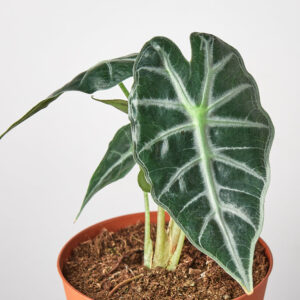
Origin: Southeast Asia
Common Name(s): Alocasia 'Bambino', African Mask, Elephant Ear
About the Alocasia Amazonica Bambino
The Alocasia Bambino adds a bold visual element to any room. Its dark green leaves are contrasted by bright silver or light green veins, creating a dramatic effect that makes it stand out in any setting. This miniaturized version of the Alocasia Amazonica is a perfect choice for those looking to add a touch of drama and elegance to smaller spaces.
Light
Bright, indirect light: This plant loves plenty of light but avoid direct sunlight, as it can scorch the leaves. A bright spot near a window with sheer curtains is ideal.
Water
Water once a week: This plant prefers weekly watering or when the top 1-2 inches of soil feel dry. Ensure that the soil remains consistently moist but not soggy.
Temperature & Humidity
Warm temperatures: This plant prefer temperatures between 65-85°F (18-27°C) with high humidity. Keep away from temperatures below 50°F.
How big will my plant grow?
It grows to around 1-2 feet (30-60 cm) tall, with leaves reaching 6-12 inches (15-30 cm) in length.
Is this plant toxic for pets and kids?
Yes. All parts of this Alocasia plant are toxic if ingested. Keep away from all pets and children.
🌿 Additional Care Tips:
- Wipe leaves gently when dust accumulates:The large, glossy leaves can accumulate dust. To maintain vibrancy, gently wipe the leaves with a damp cloth.
- Ideal for small spaces: This plant is a compact, relatively slow-growing plant, making it perfect for small spaces.
- Repot every 1-2 years: This plant doesn’t need frequent repotting. It can be repotted every 1-2 years, or when the roots become cramped
- Toxic if ingested: Like other Alocasias, this plant is also toxic to pets and humans if ingested.
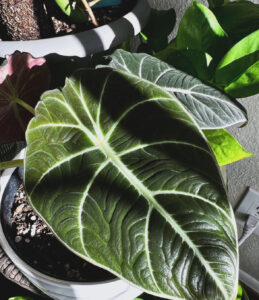
Origin: Southeast Asia
Common Name(s): Black Velvet Alocasia, Black Velvet Elephant Ear
About the Alocasia Reginula Black Velvet
The Alocasia Reginula 'Black Velvet' is a striking and sought-after variety of the Alocasia species, famous for its dark, velvety foliage that creates a dramatic contrast in any space. Native to Southeast Asia, this compact, slow-growing plant is a particularly special variety due to its deep, almost black, matte leaves, which are contrasted by prominent silver veins, making it a favorite among plant collectors and enthusiasts.
Light
Bright, indirect light:This plant loves plenty of light but avoid direct sunlight, as it can scorch the leaves. It can tolerate low light conditions but the leaves may not be as vibrant and textured.
Water
Water once a week: This Alocasia prefers weekly watering or when the top 1-2 inches of soil feel dry. This plant enjoys a bit of moisture but do avoid overwatering.
Temperature & Humidity
Warm temperatures: This plant prefer temperatures between 65-80°F (16-27°C) with very high humidity. Mist regularly, and do avoid cold conditions and sudden temperature changes.
How big will my plant grow?
This plant grows to a height of about 3 to 4 feet (90 to 120 cm) indoors, with leaves that can range from 12 to 18 inches (30 to 45 cm) long.
Is this plant toxic for pets and kids?
Yes. All parts of this Alocasia plant are toxic if ingested. Keep away from all pets and children.
🌿 Additional Care Tips:
- Watch for Pests: Watch out for mealybugs and scale insects, which can infest this Alocasia plant.
- Mist Regularly: This plant benefits from daily misting or the use of a humidifier or humidity tray.
- Avoid dry conditions: In drier conditions, this plant may become stress and this is shown by brown tips on leaves.
- Repot infrequently: This plant is generally a slow grower and don’t need frequent repotting.
- Soil for repotting: Use a well-draining potting mix, ideally with added perlite or orchid bark.
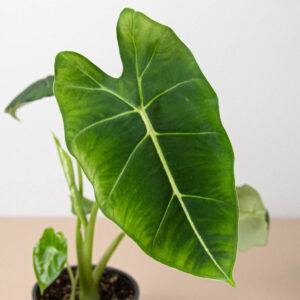
Origin: Southeast Asia and Oceania
Common Name(s): Green Velvet Alocasia
About the Alocasia Micholitziana Frydek
Alocasia micholitziana 'Frydek' is a striking ornamental plant admired for its velvety, deep green leaves and prominent white or silvery veins. Alocasia 'Frydek' thrives in bright, indirect light, which helps to bring out the rich colors of its foliage. Its high humidity requirement makes it an ideal candidate for bathrooms or rooms with high moisture levels.
Light
Bright, indirect light: This plant loves plenty of light but avoid direct sunlight, as it can scorch the leaves. Avoid low light conditions to prevent plant from losing its vibrancy.
Water
Water once a week: This plant prefers weekly watering or when the top 1-2 inches of soil feel dry. Be sure not to let the soil dry out completely, as this plant prefers consistent moisture.
Temperature & Humidity
Warm temperatures: This plant prefers temperatures between 65-85°F (18-27°C) with high humidity.
How big will my plant grow?
It typically grows to a height of about 2 to 3 feet (60 to 90 cm) when fully mature.
Is this plant toxic for pets and kids?
Yes. All parts of this Alocasia plant are toxic if ingested. Keep away from all pets and children.
🌿 Additional Care Tips:
- Reduce watering during dormant months: This Alocasia tends to go dormant in the winter months. During this time, reduce watering and allow the plant to rest.
- Repot every 1-2 years: This Alocasia prefers to be slightly root-bound, so repotting every 1-2 years is usually enough.
- Wipe leaves regularly: The large, velvety leaves are prone to dust buildup, so gently wipe them with a damp cloth
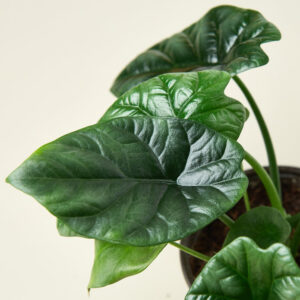
Origin: Southeast Asia
Common Name(s): Mirror Face Alocasia
About the Alocsia Mirror Face
This variety of Alocasia features large, dark green leaves with a silvery sheen, often compared to a mirror due to the way light plays off the surface. The leaves are heart-shaped with prominent veins, adding a touch of elegance and drama to any indoor space.
Light
Bright, indirect light: This plant loves plenty of light but avoid direct sunlight, as it can scorch the leaves. Avoid low light conditions to prevent plant from losing its vibrancy.
Water
Water once a week: This plant prefers weekly watering or when the top 1-2 inches of soil feel dry. This plant enjoys moisture but should not sit in a waterlogged soil.
Temperature & Humidity
Warm temperatures: This plant prefer temperatures between 65-85°F (18-27°C) with high humidity.
How big will my plant grow?
This Alocasia can grow up to about 2 to 3 feet (60 to 90 cm) in height, with leaves that can reach 12–18 inches (30–45 cm) long.
Is this plant toxic for pets and kids?
Yes. All parts of this Alocasia plant are toxic if ingested. Keep away from all pets and children.
🌿 Additional Care Tips:
- Wipe regularly: The glossy metallic finish of the leaves can accumulate dust, so regularly wipe them with a damp cloth.
- Ideal growth for small spaces: The Alocasia Serendipity is known for its compact size making it ideal for smaller spaces.
- Repot infrequently: This plant is generally a slow grower and don’t need frequent repotting.
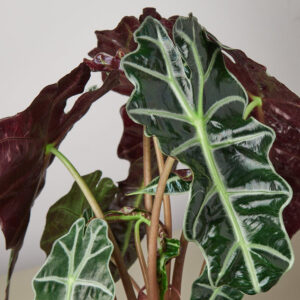
Origin: Southeast Asia
Common Name(s): African Mask Plant, Elephant Ear, Polly Alocasia
About the Alocsia Mirror Face
The Alocasia Polly, also known as the African Mask Plant or Elephant Ear, is a captivating houseplant with distinctive arrowhead-shaped leaves. These leaves are a deep green color with prominent white veins, resembling an African mask.
Light
Bright, indirect light: This plant loves plenty of light but avoid direct sunlight, as it can scorch the leaves. Avoid low light conditions to prevent plant from losing its vibrancy.
Water
Water once a week: This plant prefers weekly watering or when the top 1-2 inches of soil feel dry. Ensure that the soil remains consistently moist but not soggy.
Temperature & Humidity
Warm temperatures: This plant prefer temperatures between 65-85°F (18-27°C) with high humidity. Keep away from temperatures below 50°F.
How big will my plant grow?
This plant typically reaches a height of about 1 to 2 feet (30 to 60 cm) in indoor conditions. The leaves can grow up to 8–10 inches (20–25 cm) in length.
Is this plant toxic for pets and kids?
Yes. All parts of this Alocasia plant are toxic if ingested. Keep away from all pets and children.
🌿 Additional Care Tips:
- Wipe leaves gently when dust accumulates:The large, glossy leaves can accumulate dust. To maintain vibrancy, gently wipe the leaves with a damp cloth.
- Ideal for small spaces: This plant is a compact, relatively slow-growing plant, making it perfect for small spaces.
- Repot every 1-2 years: This plant doesn’t need frequent repotting. It can be repotted every 1-2 years, or when the roots become cramped.
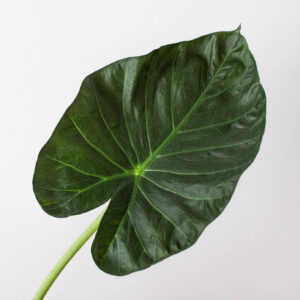
Origin: Southeast Asia
Common Name(s): Regal Shields Alocasia, Elephant Ear, Shield Alocasia
About the Alocasia Regal Shields
The Alocasia 'Regal Shields' is an impressive and visually striking cultivar of the Alocasia, loved for its large, dramatic foliage and bold visual appearance. Native to Southeast Asia, this variety is particularly popular for its enormous, shield-shaped leaves, which add a touch of grandeur to any space. With its rich, glossy green leaves and prominent veins, it’s a plant that commands attention in any collection or space.
Light
Bright, indirect light:This plant loves plenty of light but avoid direct sunlight, as it can scorch the leaves. It can tolerate low light conditions but the leaves may not be as vibrant and textured.
Water
Water once a week: This Alocasia prefers weekly watering or when the top 1-2 inches of soil feel dry. This plant enjoys a bit of moisture but do avoid overwatering.
Temperature & Humidity
Warm temperatures: This plant prefer temperatures between 65-80°F (16-27°C) with very high humidity. Mist regularly, and do avoid cold conditions and sudden temperature changes.
How big will my plant grow?
This plant grows to a height of about 3 to 4 feet (90 to 120 cm) indoors, with leaves that can range from 12 to 18 inches (30 to 45 cm) long.
Is this plant toxic for pets and kids?
Yes. All parts of this Alocasia plant are toxic if ingested. Keep away from all pets and children.
🌿 Additional Care Tips:
- Watch for Pests: Watch out for mealybugs and scale insects, which can infest this Alocasia plant.
- Mist Regularly: This plant benefits from daily misting or the use of a humidifier or humidity tray.
- Avoid dry conditions: In drier conditions, this plant may become stress and this is shown by brown tips on leaves.
- Repot infrequently: This plant is generally a slow grower and don’t need frequent repotting.
- Soil for repotting: Use a well-draining potting mix, ideally with added perlite or orchid bark.
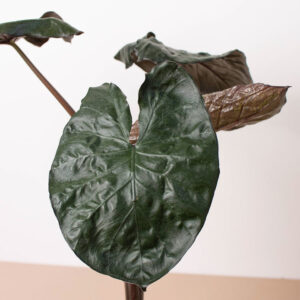
Origin: Southeast Asia
Common Name(s): African Mask Plant, Elephant Ear,
About the Alocasia Serendipity
The Alocasia Serendipity boasts large, arrowhead-shaped leaves with deep green tones and contrasting white veins, creating a bold, architectural appearance. This tropical plant is known for its striking foliage and is compactly built for the indoors.
Light
Bright, indirect light: This plant loves plenty of light but avoid direct sunlight, as it can scorch the leaves. Avoid low light conditions to prevent plant from losing its vibrancy.
Water
Water once a week: This plant prefers weekly watering or when the top 1-2 inches of soil feel dry. This plant enjoys moisture but should not sit in a waterlogged soil.
Temperature & Humidity
Warm temperatures: This plant prefer temperatures between 65-85°F (18-27°C) with high humidity.
How big will my plant grow?
This plant grows to a height of about 1.5 to 2 feet (45 to 60 cm) indoors, with leaves that can range from 6 to 12 inches(15 to 30 cm) long.
Is this plant toxic for pets and kids?
Yes. All parts of this Alocasia plant are toxic if ingested. Keep away from all pets and children.
🌿 Additional Care Tips:
- Wipe leaves regularly: The glossy, striking leaves can accumulate dust, so regularly wipe them with a damp cloth.
- Ideal for small spaces: Alocasia Serendipity is known for its compact size making it ideal for smaller spaces.
- Repot infrequently: Alocasias are generally slow growers and don’t need frequent repotting.
- Watch for pests: The Alocasia Serendipity can be prone to common houseplant pests such as spider mites and aphids.
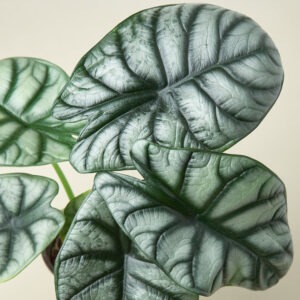
Origin: Southeast Asia
Common Name(s): Silver Dragon Alocasia
About the Alocasia Serendipity
The Alocasia Silver Dragon is known for it's leaves having prominent veins and a metallic sheen, adding to its allure. While it can grow quite large in its natural habitat, it typically remains compact indoors, making it suitable for various spaces.
Light
Bright, indirect light: This plant loves plenty of light but avoid direct sunlight, as it can scorch the leaves. Avoid low light conditions to prevent plant from losing its vibrancy.
Water
Water once a week: This plant prefers weekly watering or when the top 1-2 inches of soil feel dry. Ensure that the soil remains consistently moist but not soggy.
Temperature & Humidity
Warm temperatures: This plant prefer temperatures between 65-85°F (18-27°C) with high humidity. Keep away from temperatures below 50°F.
How big will my plant grow?
This plant grows to around 1–2 feet (30–60 cm) in height with leaves 6-8 inches (15–20 cm) long.
Is this plant toxic for pets and kids?
Yes. All parts of this Alocasia plant are toxic if ingested. Keep away from all pets and children.
🌿 Additional Care Tips:
- Wipe leaves regularly: The glossy, striking leaves can accumulate dust, so regularly wipe them with a damp cloth.
- Ideal for small spaces: Alocasia Serendipity is known for its compact size making it ideal for smaller spaces.
- Repot infrequently: Alocasias are generally slow growers and don’t need frequent repotting.
- Watch for pests: The Alocasia Silver Dragon can be prone to common houseplant pests such as spider mites and aphids.
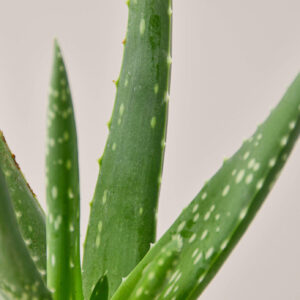
Origin: North Africa & The Arabian Peninsula
Common Name(s): Aloe Vera, Medicinal Aloe, Barbadenensis
About the Aloe Vera
This hardy plant is characterized by its fleshy, spiky leaves that are filled with a gel-like substance, commonly used in skin-care and health products. The thick, green leaves are often lined with small white teeth along the edges, and the plant produces a yellow tubular flower spike when in bloom, though it is more commonly cultivated for its leaves.
Light
Bright, indirect light: This plant loves plenty of light and also tolerate direct sunlight. In fact, this plant can also thrive in the sun in the cooler months.
Water
Water every 2-3 weeks: This plant is drought-tolerant and prefers to be watered less frequently. Avoid overwatering by allowing the soil to dry out between waterings.
Temperature & Humidity
Warm temperatures: This plant prefer temperatures between 55-85°F (15-27°C) with low to moderate humidity. Keep away from temperatures below 50°F.
How big will my plant grow?
Aloe vera plants can grow to around 2-3 feet (60-90 cm) tall, with thick, fleshy leaves that can reach 1-2 feet (30-60 cm) in length.
Is this plant toxic for pets and kids?
Toxic to pets only. While Aloe vera is non-toxic to humans in moderation, it can cause gastrointestinal upset if consumed in large quantities, and it is toxic to pets, particularly cats and dogs, if ingested.
🌿 Additional Care Tips:
- Don't overwater: The thick, fleshy leaves of Aloe Vera store water, so they may wrinkle slightly during dry conditions. If the leaves become brown or mushy, it may be a sign of overwatering or rot.
- Fertilize twice a year: Feed your aloe vera with a balanced liquid fertilizer diluted to half strength once or twice a year during the growing season.
- Propagates easily: Aloe vera is easy to propagate from leaf cuttings or offsets.
- Repot with growth: Aloe Vera does not need frequent repotting. Repot the plant every 2-3 years or when it becomes too large for its container.
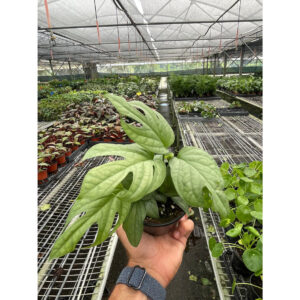
Origin: Southeast Asia
Common Name(s): Silver Amydrium, Silver Vine
About the Amydrium Silver
Also known as the Silver Surfer, this tropical plant features heart-shaped leaves that are often adorned with striking silver variegation, making it a standout addition to any indoor garden. The plant boasts large, glossy leaves with silver markings and deep green backgrounds, creating a visually captivating display.
Light
Bright, indirect light: This plant loves plenty of light and also tolerate direct sunlight. Avoid direct sunlight to prevent leave discoloration.
Water
Water once a week: This plant does not like to sit in water so only water once a week or when the top 1-2 inches of the soil is dry. Reduce water slightly during winter months.
Temperature & Humidity
Warm temperatures: This plant prefer temperatures between 65-85°F (18-27°C) with high humidity.
How big will my plant grow?
This plant can grow to around 1-2 feet (30-60 cm) in height, with leaves reaching 6-8 inches (15-20 cm) in length.
Is this plant toxic for pets and kids?
Yes. This plant is mildly toxic to pets and children if ingested, so handle with care and keep it out of reach.
🌿 Additional Care Tips:
- Benefits from a standing structure: As your Amydrium Silver grows, it will appreciate a moss pole or trellis to climb on.
- Fertilize during the growing season: Feed your plant with a balanced liquid fertilizer diluted to half strength once a month during the growing season.
- Repotting: Repot your Amydrium every 1-2 years or when it becomes root-bound, using a well-draining potting mix.
- Watch out for pests: Keep an eye for common houseplant pests like mealybugs and spider mites. Treat infestations promptly with insecticidal soap or neem oil.
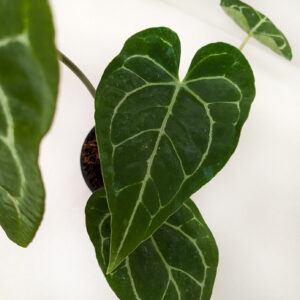
Origin: Central & South America
Common Name(s): Anthurium Crystalline, Crystal Anthurium, Silver Anthurium
About the Anthurium Crystallinum
The Anthurium Crystallinum is a striking tropical plant known for its large, heart-shaped leaves adorned with a unique silvery-white veining pattern. Native to the rainforests of Central and South America, this epiphytic plant thrives in humid, shaded environments where it can receive filtered indirect light and ample moisture. It is primarily grown for its spectacular foliage, which can add a touch of exotic beauty to any indoor space, making it a favored choice among plant collectors and enthusiasts.
Light
Bright, indirect light: This plant loves plenty of light but it avoid direct sunlight, as it can scorch the leaves. They can tolerate low light but growth may be slower.
Water
Water once a week: This plant prefers weekly watering or when the top 1-2 inches of soil feel dry. Distilled water is recommended. Let the top inch of soil dry out slightly between waterings.
Temperature & Humidity
Warm temperatures: This plant prefer temperatures between 65-80°F (18-27°C) with high humidity of 70-80%. Keep away from temperatures below 50°F.
How big will my plant grow?
It can grow to around 1-2 feet (30-60 cm) tall, with large, textured leaves that can reach 12-18 inches (30-45 cm) in length.
Is this plant toxic for pets and kids?
Yes. This Anthurium plant is toxic to humans and pets which can cause irritation and discomfort if ingested or touched.
🌿 Additional Care Tips:
- Stem Support: If this anthurium has long stems, provide support with a moss pole or stake.
- Lighting Positioning: An east-facing window is ideal, or a south-facing window with a sheer curtain to filter the light.
- Mist regularly: This anthurium thrives best in high humidity of 70-80% so mist regularly or use a humidifier.
- Repot every 2-3 years: This Anthurium doesn’t need frequent repotting. It can be repotted every 2-3 years, or when the roots become cramped.
- Fertilize during growing season: Fertilize your anthurium once a month during the spring and summer with a balanced liquid houseplant fertilizer

Origin: Central & South America
Common Name(s): Purple Anthurium, Purple Flamingo Flower, Purple Laceleaf
About the Anthurium Purple
The Purple variety of Anthurium is particularly notable for its rich, deep purple spathes, which contrast beautifully with its dark green, heart-shaped leaves. Native to the rainforests of Central and South America, this variety thrives in humid, tropical environments and is often found growing as an epiphyte in the understory.
Light
Bright, indirect light: This plant loves plenty of light but avoid direct sunlight, as it can scorch the leaves. They can tolerate lower light conditions. Place them near a window with filtered sunlight.
Water
Water once a week: This plant prefers weekly watering or when the top 1-2 inches of soil feel dry. Ensure that the soil remains consistently moist but not soggy.
Temperature & Humidity
Warm temperatures: This plant prefer temperatures between 65-80°F (18-27°C) with high humidity. Keep away from temperatures below 50°F.
How big will my plant grow?
It can grow to around 1-2 feet (30-60 cm) tall, with vibrant, purple, heart-shaped flowers that can reach 4-6 inches (10-15 cm) in length.
Is this plant toxic for pets and kids?
Yes. This Anthurium plant is toxic to humans and pets which can cause irritation and discomfort if ingested or touched.
🌿 Additional Care Tips:
- Stem Support: If your anthurium has long stems, provide support with a moss pole or stake.
- Avoid Cold Drafts: Protect your plant from cold drafts and sudden temperature changes.
- Repot every 2-3 years: This plant doesn’t need frequent repotting. It can be repotted every 2-3 years, or when the roots become cramped.
- Fertilize during growing season: Fertilize this anthurium variety once a month during the spring and summer with a balanced liquid houseplant fertilizer diluted to half strength.
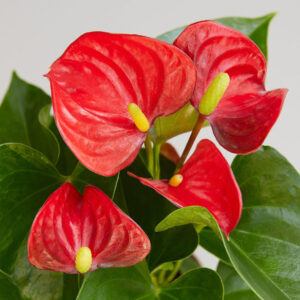
Origin: Central & South America
Common Name(s): Red Anthurium, Red Flamingo Flower, Red Laceleaf, Painter's Palette
About the Anthurium Red
The Red variety of Anthurium is especially prized for its vibrant red spathes, which contrast beautifully with its dark green, leathery leaves. Native to the tropical rainforests of Central and South America, this Anthurium plant are epiphytic by nature, often growing in the shade of larger trees where they enjoy indirect light and high humidity.
Light
Bright, indirect light: This plant loves plenty of light but avoid direct sunlight, as it can scorch the leaves. They can tolerate lower light conditions. Place them near a window with filtered sunlight.
Water
Water once a week: This plant prefers weekly watering or when the top 1-2 inches of soil feel dry. Ensure that the soil remains consistently moist but not soggy. Avoid overwatering.
Temperature & Humidity
Warm temperatures: This plant prefer temperatures between 65-80°F (18-27°C) with high humidity. Keep away from temperatures below 50°F.
How big will my plant grow?
It can grow to around 1-2 feet (30-60 cm) tall, with vibrant, red, heart-shaped flowers that can reach 4-6 inches (10-15 cm) in length.
Is this plant toxic for pets and kids?
Yes. This Anthurium plant is toxic to humans and pets which can cause irritation and discomfort if ingested or touched.
🌿 Additional Care Tips:
- Stem Support: If your Anthurium Red has long stems, provide support with a moss pole or stake.
- Avoid Cold Drafts: Protect your plant from cold drafts and sudden temperature changes.
- Repot every 2-3 years: This Anthurium variety doesn’t need frequent repotting. It can be repotted every 2-3 years, or when the roots become cramped.
- Fertilize during growing season: Fertilize your anthurium once a month during the spring and summer with a balanced liquid houseplant fertilizer diluted to half strength.
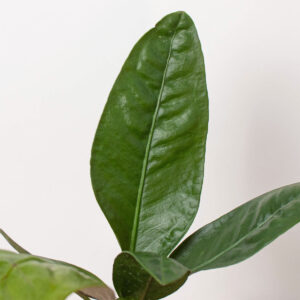
Origin: Central & South America
Common Name(s): Anthurium Superbum, King Anthurium, Bird's Nest Anthurium
About the Anthurium Superbum
Unlike the more commonly seen Anthurium varieties, the Anthurium Superbum is primarily grown for its beautiful foliage rather than its flowers, making it a great addition for those seeking an ornamental, low-maintenance plant. It is prized for its large, glossy, deeply lobed leaves and striking appearance
Light
Bright, indirect light: This plant loves plenty of light but it avoid direct sunlight, as it can scorch the leaves. They can tolerate low light but growth may be slower.
Water
Water once a week: This plant prefers weekly watering or when the top 1-2 inches of soil feel dry. Let the top inch of soil dry out slightly between waterings.
Temperature & Humidity
Warm temperatures: This plant prefer temperatures between 65-80°F (18-27°C) with high humidity. Keep away from temperatures below 50°F.
How big will my plant grow?
It can grow to around 1-2 feet (30-60 cm) tall, with large, textured leaves that can reach 12-18 inches (30-45 cm) in length.
Is this plant toxic for pets and kids?
Yes. This Anthurium plant is toxic to humans and pets which can cause irritation and discomfort if ingested or touched.
🌿 Additional Care Tips:
- Stem Support: If your Anthurium Superbum has long stems, provide support with a moss pole or stake.
- Avoid Cold Drafts: Protect your plant from cold drafts and sudden temperature changes.
- Repot every 2-3 years: This plant doesn’t need frequent repotting. It can be repotted every 2-3 years, or when the roots become cramped.
- Fertilize during growing season: Fertilize the superbum once a month during the spring and summer with a balanced liquid houseplant fertilizer diluted to half strength.
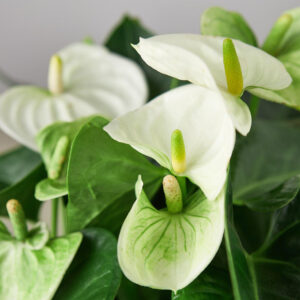
Origin: Central & South America
Common Name(s): White Anthurium, White Flamingo Flower, White Laceleaf, Painter's Palette
About the Anthurium White
The White variety of Anthurium stands out for its pure white spathes, which beautifully encircle the central spadix (flower spike), creating an elegant and sophisticated appearance. This plant is relatively easy to care for, making it a great choice for both beginner and seasoned plant enthusiasts.
Light
Bright, indirect light: This plant loves plenty of light but avoid direct sunlight, as it can scorch the leaves. They can tolerate lower light conditions. Place them near a window with filtered sunlight.
Water
Water once a week: This plant prefers weekly watering or when the top 1-2 inches of soil feel dry. Let the top inch of soil dry out slightly between waterings.
Temperature & Humidity
Warm temperatures: This plant prefer temperatures between 65-80°F (18-27°C) with high humidity. Keep away from temperatures below 50°F.
How big will my plant grow?
It can grow to around 1-2 feet (30-60 cm) tall, with vibrant, heart-shaped flowers that can reach 4-6 inches (10-15 cm) in length.
Is this plant toxic for pets and kids?
Yes. This Anthurium is toxic to humans and pets which can cause irritation and discomfort if ingested or touched.
🌿 Additional Care Tips:
- Stem Support: If your Anthurium White has long stems, provide support with a moss pole or stake.
- Avoid Cold Drafts: Protect your plant from cold drafts and sudden temperature changes.
- Repot every 2-3 years: This plant doesn’t need frequent repotting. It can be repotted every 2-3 years, or when the roots become cramped.
- Fertilize during growing season: Fertilize your anthurium once a month during the spring and summer with a balanced liquid houseplant fertilizer diluted to half strength.
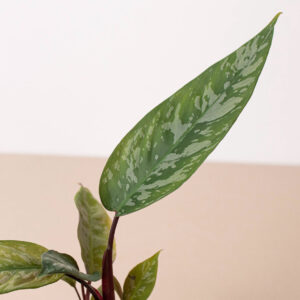
Origin: Southeast Asia
Common Name(s): Purple Sword Apoballis, Purple Sword Plant
About the Apoballis Purple Sword
This eye-catching plant adds a bold and dramatic splash of color to any collection, with its leaves transitioning from green to purple as they mature. The narrow, upright foliage has a sleek, sword-like appearance, which is where the plant gets its common name.
Light
Bright, indirect light: This plant loves plenty of light and also tolerate direct sunlight. Avoid the intense afternoon sunlight.
Water
Water every 1-2 weeks: This plant does not like to sit in water so only water every 1-2 weeks or when the top 1-2 inches of the soil is dry. Consistent moisture is preferred.
Temperature & Humidity
Warm temperatures: This plant prefer temperatures between 65-85°F (18-27°C) with moderate to high humidity.
How big will my plant grow?
This plant can grow to around 12-18 inches (30-60 cm) tall, with thick, fleshy leaves that can reach 6-8 inches (15-20 cm) in length.
Is this plant toxic for pets and kids?
Apoballis 'Purple Sword' is generally non-toxic to pets and humans, but as with all plants, it's a good idea to keep it out of reach of curious pets who may nibble on the foliage.
🌿 Additional Care Tips:
- Leaf Discoloration: If the leaves are losing their vibrant purple color, this could be due to insufficient light. Increase the light exposure (but avoid direct sun).
- Fertilize during growing season: Feed your plant with a balanced liquid fertilizer diluted to half strength once a month during the growing season.
- Repotting: Repot your Purple Sword every 1-2 years or when it becomes root-bound, using a well-draining potting mix. When repotting, gently check the roots for rot and remove any that look unhealthy.
- Watch out for pests: Keep an eye for common houseplant pests like mealybugs and spider mites. Treat infestations promptly with insecticidal soap or neem oil.
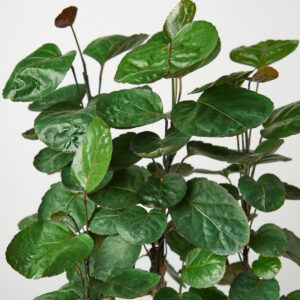
Origin: Southeast Asia
Common Name(s): Aralia Fabian Stump, Shield Aralia, Fabian Aralia
About the Aralia Fabian Stump ‘Polyscias Scutellaria’
This variety is particularly popular for its unique, bushy appearance, making it an ideal choice for both indoor and outdoor spaces that require a tropical touch. The plant's leaves are large and rounded, resembling shields, with deep green hues and prominent veins. Aralia Fabian Stump is a relatively slow-growing plant, but with the right care, it can develop into a beautiful, bushy shrub.
Light
Bright, indirect light: This plant loves plenty of light. It can slo tolerate some direct light in the early morning or late afternoon. Avoid full direct sunlight.
Water
Water once a week: This plant does not like to sit in water so only water once a week or when the top 1-2 inches of the soil is dry. Avoid overwatering to prevent root rot.
Temperature & Humidity
Warm temperatures: This plant prefer temperatures between 65-75°F (18-24°C) with moderate humidity.
How big will my plant grow?
This plant can grow to around 3-4 feet (90-120 cm) tall and wide, with delicate, fern-like foliage.
Is this plant toxic for pets and kids?
This plant is non-toxic to both pets and humans, making it a safe choice for homes with curious animals or small children.
🌿 Additional Care Tips:
- Remove Dead or Yellowing Leaves: Regularly remove any dead or yellowing leaves to improve the plant's appearance and prevent any potential disease issues
- Fertilize once a month during the growing season: During the active growing months, feed the plant every 4-6 weeks with a balanced, water-soluble fertilizer (diluted to half strength) to encourage strong growth and healthy foliage.
- Prune regularly: Prune your Aralia Fabian Stump to maintain its shape and encourage bushier growth.
- Watch out for pests: Keep an eye out for common houseplant pests like mealybugs and spider mites. Treat infestations promptly with insecticidal soap or neem oil.
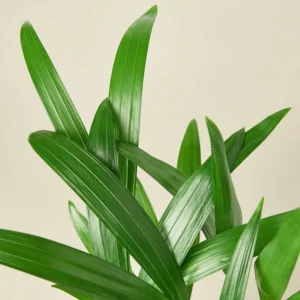
Origin: Southeast Asia
Common Name(s): Areca Palm, Butterfly Palm, Golden Cane Palm
About the Areca Palm
The Areca Palm is a popular, attractive indoor palm native to Madagascar. It is known for its feathery, arching fronds that give it a lush, tropical appearance. The Areca Palm is an excellent air purifier. It is known to filter out common indoor toxins like formaldehyde, xylene, and toluene, while also releasing fresh oxygen.
Light
Bright, indirect light: Prefers bright, indirect light but can tolerate some direct morning or late afternoon sun. Too much direct sun can cause leaf burn.
Water
Water weekly: Water when the top 1-2 inches of soil feel dry. Typically, water every 7-10 days, but reduce in winter when growth slows. Ensure proper drainage to prevent waterlogging.
Temperature & Humidity
Warm temperatures: Thrives in temperatures between 65-75°F (18-24°C). Prefers humidity levels above 50%. Increase humidity with a humidifier or misting if needed.
How big will my plant grow?
This plant can grow 4-7 feet tall indoors, making it a great option for filling spaces and adding a vibrant, green touch to your home or office.
Is this plant toxic for pets and kids?
The Areca Palm is considered non-toxic to pets, making it a safe option for households with animals.
🌿 Additional Care Tips:
- Fertilize regularly: Feed your Areca palm with a balanced liquid fertilizer diluted to half strength every 4-6 weeks during the growing season.
- Monitor for pests: Keep an eye out for common houseplant pests like mealybugs and spider mites. Treat infestations promptly with insecticidal soap or neem oil.
- Repot as needed: Repot every 2-3 years or when root-bound, using a well-draining, peat-based mix. Choose a pot that’s 1-2 inches larger in diameter.
- Rotate regularly: Rotate your Areca palm regularly to ensure even growth and adequate sunlight to all sides.
C
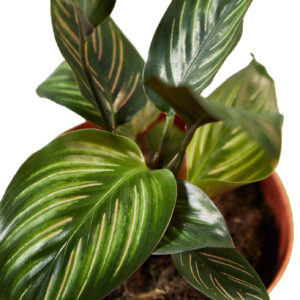
Origin: South America
Common Name(s): Beauty Star Calathea, Peacock Calathea, Striped Calathea
About the Calathea Beauty Star
The Calathea 'Beauty Star' is an exquisite tropical plant prized for its stunning foliage and bold, eye-catching patterns. The large, oval-shaped leaves of this variety are deep green with striking white or silver stripes that create a starburst effect, giving the plant its "Beauty Star" name. The Calathea 'Beauty Star' is not only known for its dramatic foliage but also for its unique ability to "dance" in response to the light. This phenomenon, called nyctinasty, causes the leaves to move upward at night and return to their normal position during the day.
Light
Bright, indirect light: This plant loves plenty of light. Avoid direct sunlight to prevent leaves from browning.
Water
Water once a week: This plant does not like to sit in water so only water once a week or when the top 1-2 inches of the soil is dry. Regular misting is recommended. Avoid overwatering.
Temperature & Humidity
Warm temperatures: This plant prefer temperatures between 65-75°F (18-24°C) with high humidity. Avoid temperatures below 50°F.
How big will my plant grow?
It typically grows to a height of 18 to 24 inches (45 to 60 cm), forming a compact, bushy clump of leaves. Its growth habit is upright and it does not become too leggy.
Is this plant toxic for pets and kids?
No. This Calathea is non-toxic to both pets and humans, making it a safe choice for households with animals or small children.
🌿 Additional Care Tips:
- Sensitive to some chemicals: This Calathea is generally sensitive to chemicals like chlorine and fluoride found in tap water. Distilled water is always recommended.
- Fertilize once a month: Feed this Calathea with a balanced liquid fertilizer diluted to half strength once a month during the growing season.
- Repot every 1-2 years: Repot every 1-2 years or when the plant becomes root-bound. Choose a pot that’s only slightly larger than the current.
- Avoid cold drafts: Keep your Calathea Beauty Star away from cold drafts and sudden temperature changes.
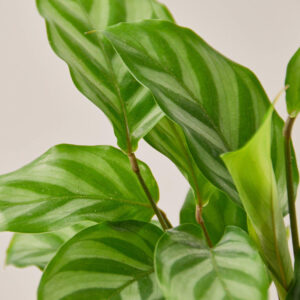
Origin: South America
Common Name(s): Freddie Calathea, Rattlesnake Plant
About the Calathea Concinna ‘Freddie’
The Calathea concinna 'Freddie' is known for its beautifully patterned foliage. The leaves are elongated and oval-shaped, displaying a rich, deep green with intricate, contrasting lighter green markings that resemble the scales of a rattlesnake, giving the plant its common name.
Light
Bright, indirect light: This plant loves plenty of light. Avoid direct sunlight to prevent leaves from browning.
Water
Water once a week: This plant does not like to sit in water so only water once a week or when the top 1-2 inches of the soil is dry. Regular misting is recommended.
Temperature & Humidity
Warm temperatures: This plant prefer temperatures between 65-75°F (18-24°C) with high humidity. Avoid temperatures below 50°F.
How big will my plant grow?
t typically grows to a height of 12 to 18 inches (30 to 45 cm), making it a medium-sized Calathea suitable for small to medium spaces.
Is this plant toxic for pets and kids?
No. This Calathea is non-toxic to both pets and humans, making it a safe choice for households with animals or small children.
🌿 Additional Care Tips:
- Sensitive to some chemicals: This plant is generally sensitive to chemicals like chlorine and fluoride found in tap water. Distilled water is recommended.
- Fertilize once a month: Feed your plant with a balanced liquid fertilizer diluted to half strength once a month during the growing season.
- Repot every 1-2 years: Repot every 1-2 years or when the plant becomes root-bound. Choose a pot that’s only slightly larger than the current one.
- Avoid cold drafts: Keep your Calathea away from cold drafts and sudden temperature changes.
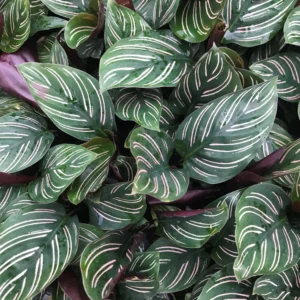
Origin: South America
Common Name(s): Pinstripe Calathea, Ornate Calathea
About the Calathea Ornata
The Calathea Ornata is a stunning tropical plant recognized for its striking, bold leaf patterns. The plant's large, oval-shaped leaves are deep green with contrasting pink or white stripes that run parallel along the veins, resembling pinstripes—hence the common name. The undersides of the leaves are often a rich purple or maroon, adding another layer of color contrast.
Light
Bright, indirect light: This plant loves plenty of light. Avoid direct sunlight to prevent leaves from browning.
Water
Water once a week: This plant does not like to sit in water so only water once a week or when the top 1-2 inches of the soil is dry. Regular misting is recommended. Avoid overwatering.
Temperature & Humidity
Warm temperatures: This plant prefer temperatures between 65-75°F (18-24°C) with high humidity. Avoid temperatures below 50°F.
How big will my plant grow?
It typically grows to a height of 18 to 24 inches (45 to 60 cm), forming a compact, bushy clump of leaves. Its growth habit is upright and it does not become too leggy.
Is this plant toxic for pets and kids?
No. This Calathea is non-toxic to both pets and humans, making it a safe choice for households with animals or small children.
🌿 Additional Care Tips:
- Sensitive to some chemicals: This Calathea is generally sensitive to chemicals like chlorine and fluoride found in tap water. Distilled water is always recommended.
- Fertilize once a month: Feed your Ornata with a balanced liquid fertilizer diluted to half strength once a month during the growing season.
- Repot every 1-2 years: Repot every 1-2 years or when the plant becomes root-bound. Choose a pot that’s only slightly larger than the current.
- Avoid cold drafts: Keep your Calathea Ornata away from cold drafts and sudden temperature changes.
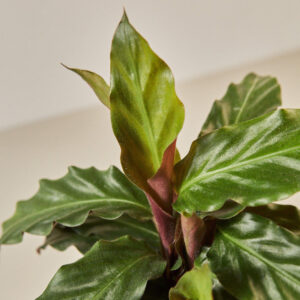
Origin: South America
Common Name(s): Furry Feather Calathea, Velvet Calathea
About the Calathea Rufibarba ‘Furry Feather'
The Calathea Rufibarba 'Furry Feather' is a stunning ornamental plant with uniquely textured foliage. The plant’s leaves are a rich, deep green on the upper surface, but the undersides covered in soft, velvety purple or reddish hues, giving the leaves a fuzzy, almost "feather-like" texture.
Light
Bright, indirect light: This plant loves plenty of light. Avoid direct sunlight to prevent leaves from browning.
Water
Water once a week: This plant does not like to sit in water so only water once a week or when the top 1-2 inches of the soil is dry. Regular misting is recommended. Avoid overwatering.
Temperature & Humidity
Warm temperatures: This plant prefer temperatures between 65-80°F (18-27°C) with moderate humidity. Avoid temperatures below 50°F.
How big will my plant grow?
It typically grows to a height of 18 to 24 inches (45 to 60 cm), in height and width, making it a compact yet striking plant suitable for smaller to medium spaces.
Is this plant toxic for pets and kids?
No. This Calathea is non-toxic to both pets and humans, making it a safe choice for households with animals or small children.
🌿 Additional Care Tips:
- Sensitive to some chemicals: This plant is generally sensitive to chemicals like chlorine and fluoride found in tap water. Distilled water is recommended.
- Fertilize once a month: Feed your plant with a balanced liquid fertilizer diluted to half strength once a month during the growing season.
- Repot every 1-2 years: Repot every 1-2 years or when the plant becomes root-bound. Choose a pot that’s only slightly larger than the current one.
- Avoid cold drafts: Keep your Calathea away from cold drafts and sudden temperature changes.
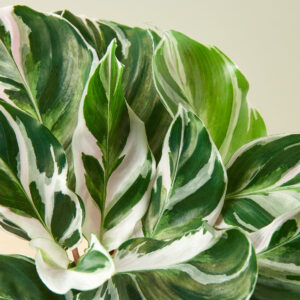
Origin: South America
Common Name(s): White Fusion Calathea
About the Calathea White Fusion
The Calathea 'White Fusion' is a visually striking and known for its bold, contrasting foliage. The leaves of this plant are a soft, pale green to cream, with dramatic white and silver marbling and streaks that give it an almost "frosted" appearance. It also exhibits the fascinating behavior known as "nyctinasty," where its leaves fold up at night and open during the day in response to light.
Light
Bright, indirect light: This plant loves plenty of light. Avoid direct sunlight to prevent leaves from browning.
Water
Water once a week: This plant does not like to sit in water so only water once a week or when the top 1-2 inches of the soil is dry. Regular misting is recommended.
Temperature & Humidity
Warm temperatures: This plant prefer temperatures between 65-75°F (18-24°C) with high humidity. Avoid temperatures below 50°F.
How big will my plant grow?
This plant typically reaches a mature height of about 18 to 24 inches (45 - 60 cm) when grown indoors.
Is this plant toxic for pets and kids?
No. The Calathea 'White Fusion' is non-toxic to both pets and humans, making it a safe choice for households with animals or small children.
🌿 Additional Care Tips:
- Sensitive to some chemicals: This Calathea, like many other varieties, is generally sensitive to chemicals like chlorine and fluoride found in tap water. Distilled water is recommended.
- Fertilize once a month: Feed your White Fusion with a balanced liquid fertilizer diluted to half strength once a month during the growing season.
- Repot every 1-2 years: Repot every 1-2 years or when the plant becomes root-bound. Choose a pot that’s only slightly larger than the current one.
- Avoid cold drafts: Keep your Calathea White Fusion away from cold drafts and sudden temperature changes.
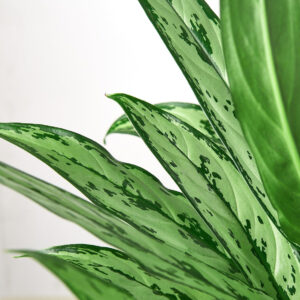
Origin: Southeast Asia
Common Name(s): Chinese Evergreen 'Cutlass'
About the Chinese Evergreen Cutlass
This striking houseplant renowned for its unique, narrow leaves that resemble swords, features lush, deep green foliage with beautiful silver markings, adding an elegant touch to any indoor setting. Its adaptability to various light conditions makes it a popular choice for both novice and experienced plant enthusiasts.
Light
Medium to Bright, indirect light: This plant loves a moderate amount of light to thrive. Avoid direct sunlight to prevent leaves from browning.
Water
Water once a week: This plant does not like to sit in water so only water once a week or when the top 1-2 inches of the soil is dry. The soil should be consistently moist; do not overwater.
Temperature & Humidity
Warm temperatures: This plant prefer temperatures between 65-85°F (18-29°C) with moderate to high humidity. Regular misting is ideal to maintain humidity levels.
How big will my plant grow?
It typically grows to a height of 12 to 18 inches (30 to 45 cm), in height. Leaves can group up to 12 inches. It makes an attractive table or shelf plant.
Is this plant toxic for pets and kids?
Yes, The Chinese Evergreen Cutlass is considered mildly toxic to pets and children if ingested, so handle with care and keep it out of reach.
🌿 Additional Care Tips:
- Repotting: Repot every 1-2 years, or when the plant becomes root-bound.
- Fertilize once a month: Feed your plant with a balanced liquid fertilizer diluted to half strength once a month during the growing season.
- Easily stressed: Avoid placing it near air conditioning vents or heating sources, as extreme temperature fluctuations can stress the plant.
- Avoid cold drafts: Keep your Evergreen away from cold drafts and sudden temperature changes.
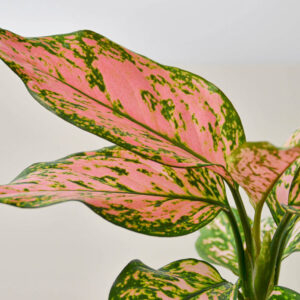
Origin: Southeast Asia
Common Name(s): Lady Valentine Chinese Evergreen
About the Chinese Evergreen Lady Valentine
The Chinese Evergreen 'Lady Valentine' is a striking cultivar of the Aglaonema species, known for its beautifully variegated leaves that combine shades of green, silver, and pink. This plant is native to tropical and subtropical regions of Southeast Asia, where it thrives in the shaded understory of rainforests. The 'Lady Valentine' variety is particularly prized for its vibrant pink blush and deep green leaf edges, which make it stand out in any room. Its adaptability to various light conditions makes it a popular indoor choice for both new and experienced plant lovers.
Light
Medium to Bright, indirect light: This plant loves moderate to plenty amount of light. While it can also thrive in low light, do avoid direct sunlight to prevent leaves from browning.
Water
Water once a week: This plant requires watering only once a week or when the top 1-2 inches of the soil is dry. Soil should be consistently moist; do not overwater.
Temperature & Humidity
Warm temperatures: This plant prefer temperatures between 65-85°F (18-29°C) with moderate to high humidity. Regular misting is ideal to help with humidity.
How big will my plant grow?
It typically grows to a height of 12 to 18 inches (30 to 45 cm), spreading to about 18 inches (45 cm). It is an upright plant, making it ideal for small spaces such as tabletops or shelves.
Is this plant toxic for pets and kids?
Yes, The Chinese Evergreen Lady Valentine is considered mildly toxic to pets and children if ingested, so handle with care and keep it out of reach.
🌿 Additional Care Tips:
- Repotting: Repot every 1-2 years, or when the plant becomes root-bound
- Fertilize once a month: Feed your plant with a balanced liquid fertilizer diluted to half strength once a month during the growing season.
- Easily stressed: Avoid placing it near air conditioning vents or heating sources, as extreme temperature fluctuations can stress the plant.
- Avoid cold drafts: Keep your Silver Gray away from cold drafts and sudden temperature changes.
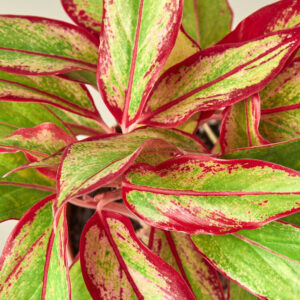
Origin: Southeast Asia
Common Name(s): Red Siam Chinese Evergreen
About the Chinese Evergreen Red Siam
This popular houseplant, admired for its vibrant and multicolored foliage, features stunning leaves with deep green backgrounds and striking red and pink variegation. Its adaptability to various light conditions makes it a popular indoor choice for plant enthusiasts.
Light
Medium to Bright, indirect light: This plant loves moderate to plenty amount of light. While it can also thrive in low light, do avoid direct sunlight to prevent leaves from browning.
Water
Water once a week: This plant requires watering only once a week or when the top 1-2 inches of the soil is dry. Soil should be consistently moist; do not overwater. Reduce watering in the winter.
Temperature & Humidity
Warm temperatures: This plant prefer temperatures between 65-85°F (18-29°C) with moderate to high humidity. Regular misting is ideal to help with humidity.
How big will my plant grow?
It typically grows to a height of 12 to 18 inches (30 to 45 cm). It is ideal for small spaces or small corners where it can add a splash of color.
Is this plant toxic for pets and kids?
Yes, The Chinese Evergreen Red Siam is considered mildly toxic to pets and children if ingested, so handle with care and keep it out of reach.
🌿 Additional Care Tips:
- Repotting: Repot every 1-2 years, or when the plant becomes root-bound
- Fertilize once a month: Feed your plant with a balanced liquid fertilizer diluted to half strength once a month during the growing season.
- Easily stressed: Avoid placing it near air conditioning vents or heating sources, as extreme temperature fluctuations can stress the plant.
- Avoid cold drafts: Keep your Silver Gray away from cold drafts and sudden temperature changes.
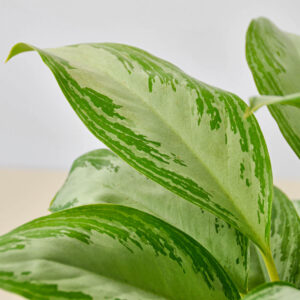
Origin: Southeast Asia
Common Name(s): Chinese Evergreen, Silver Bay Aglaonema
About the Chinese Evergreen Silver Bay
This striking houseplant renowned for its unique striking foliage, features lush, green leaves adorned with silvery-gray variegation, creating a beautiful contrast that brightens any indoor space. Its adaptability to various light conditions makes it a popular choice for home and offices.
Light
Medium to Bright, indirect light: This plant loves moderate amount of light. Avoid direct sunlight to prevent leaves from browning.
Water
Water once a week: This plant does not like to sit in water so only water once a week or when the top 1-2 inches of the soil is dry. Soil should be consistently moist.
Temperature & Humidity
Warm temperatures: This plant prefer temperatures between 65-85°F (18-29°C) with moderate to high humidity.
How big will my plant grow?
It typically grows to a height of 12 to 18 inches (30 to 45 cm), in height, making it ideal for small to medium-sized spaces.
Is this plant toxic for pets and kids?
Yes, The Chinese Evergreen Silver Bay is considered mildly toxic to pets and children if ingested, so handle with care and keep it out of reach.
🌿 Additional Care Tips:
- Repotting: Repot every 1-2 years, or when the plant becomes root-bound
- Fertilize once a month: Feed your plant with a balanced liquid fertilizer diluted to half strength once a month during the growing season.
- Easily stressed: Avoid placing it near air conditioning vents or heating sources, as extreme temperature fluctuations can stress the plant.
- Avoid cold drafts: Keep your Silver Bay away from cold drafts and sudden temperature changes.
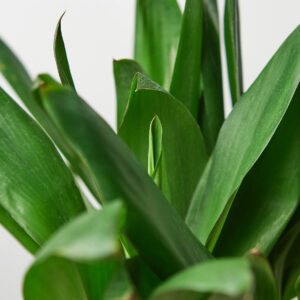
Origin: Pacific Islands
Common Name(s): Glauca Cordyline, Blue Cordyline
About the Cordyline Glauca
This plant is a striking ornamental plant that stands out due to its bold, architectural foliage. This species is prized for its long, narrow, lance-shaped leaves that emerge in a distinctive blue-green hue. The plant’s color intensifies when grown in brighter light, and the foliage takes on a more vibrant blue or silvery-green shade. It has an upright growth habit, with long, narrow leaves that fan out from a central stem.
Light
Medium to Bright, indirect light: This plant loves moderate to plenty amount of light to thrive. While it can also thrive in low light, do avoid direct sunlight.
Water
Water once a week: This plant requires watering only once a week or when the top 1-2 inches of the soil is dry. Soil should be consistently moist; pot must have good drainage.
Temperature & Humidity
Warm temperatures: This plant prefer temperatures between 65-80°F (18-27°C) with moderate humidity. Misting helps with its humidity levels.
How big will my plant grow?
It typically grows to a height of 24 to 36 inches (60 to 90 cm), making it suitable for indoor environments with limited space.
Is this plant toxic for pets and kids?
Yes. This plant is mildly toxic to pets and humans if ingested. The sap, berries, and roots contains toxins. Handle with care.
🌿 Additional Care Tips:
- Prune regularly: This plant should be pruned regularly to maintain shape and encourage new growth.
- Reduce fertilizing in Winter: During the fall and winter, when the plant’s growth slows down, reduce fertilizing or stop altogether to avoid overfeeding.
- Repotting every 1-2 years: Cordyline glauca will likely need to be repotted every 1–2 years, especially if it becomes root-bound. Check roots for any rot or diseases.
- Watch for common pests: While Cordylines are relatively pest-resistant, they can occasionally attract mealybugs, spider mites, or scale insects. Inspect the plant regularly for signs of pests, particularly on the undersides of leaves.
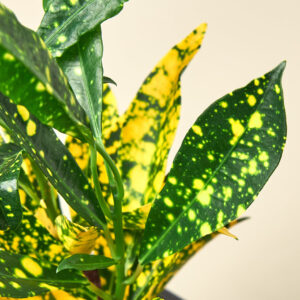
Origin: Southeast Asia and the Pacific Islands
Common Name(s): Gold Dust Croton, Croton 'Gold Dust', Variegated Croton
About the Croton Gold Dust
The 'Gold Dust' variety is particularly admired for its dark green leaves with bright yellow spots or speckles, giving it a "dusted" appearance, hence the name. This striking coloration makes it a popular choice for adding a touch of drama and color to indoor spaces. The vibrant foliage makes this plant a striking accent in living rooms or near windows.
Light
Bright, indirect light: This plant loves plenty of light and thrive indirect bright light. They can tolerate some direct light and low light; colors may fade in low light.
Water
Water once a week: This plant prefers weekly watering or when the top 1-2 inches of soil feel dry. Let the top inch of soil dry out slightly between waterings; water throughly.
Temperature & Humidity
Warm temperatures: This plant prefer temperatures between 60-85°F (15-29°C) with very high humidity. Mist the leaves regularly, especially during dry winter months.
How big will my plant grow?
It typically grows to a height of 24 to 36 inches (60 to 90 cm). Its bushy from makes it suitable for medium spaces indoors near windows and with good lighting.
Is this plant toxic for pets and kids?
Yes. This plant is toxic to pets and humans if ingested. It can cause symptoms such as nausea, vomiting, and stomach discomfort if ingested. Keep away from pets and children.
🌿 Additional Care Tips:
- Handle plant with care: Handling the plant may cause mild skin irritation for sensitive individuals, so it's recommended to wear gloves when working with Crotons.
- Benefit from a Humidity Tray: Place the pot on a tray filled with pebbles and water to increase humidity around the plant.
- Repot every 2-3 years: This plant doesn’t need frequent repotting. It can be repotted every 2-3 years, or when the roots become cramped.
- Fertilize during growing season: Fertilize your croton once a month during the spring and summer with a balanced liquid houseplant fertilizer diluted to half strength.
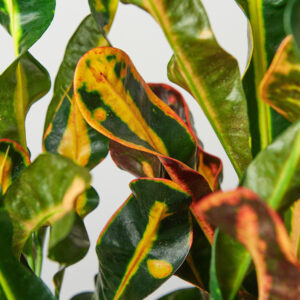
Origin: Southeast Asia and the Pacific Islands
Common Name(s): Mammy Croton, Croton 'Mammy', Variegated Croton
About the Croton Mammy
The 'Mammy' variety of Croton is particularly prized for its small, bushy growth habit and its intense, contrasting colors that make it an excellent statement plant for interior spaces. The vibrant foliage makes this plant a striking accent in living rooms, sunrooms, or near windows where it can receive plenty of light.
Light
Bright, direct light: This plant loves plenty of light and thrive in direct light. They can tolerate low light but colors may become less intense.
Water
Water once a week: This plant prefers weekly watering or when the top 1-2 inches of soil feel dry. Let the top inch of soil dry out slightly between waterings; water throughly.
Temperature & Humidity
Warm temperatures: This plant prefer temperatures between 60-85°F (15-29°C) with very high humidity. Mist the leaves regularly, especially during dry winter months.
How big will my plant grow?
It typically grows to a height of 12 to 24 inches (45 to 60 cm). Its bushy compact from makes it suitable for small spaces indoors near windows and with bright lighting.
Is this plant toxic for pets and kids?
Yes. This plant is toxic to pets and humans if ingested. It can cause symptoms such as nausea, vomiting, and stomach discomfort if ingested. Keep away from pets and children.
🌿 Additional Care Tips:
- Avoid Fertilizing in Winter: Reduce or stop fertilizing during the winter months.
- Avoid Cold Drafts: Protect your plant from cold drafts and sudden temperature changes.
- Repot every 2-3 years: This plant doesn’t need frequent repotting. It can be repotted every 2-3 years, or when the roots become cramped.
- Fertilize during growing season: Fertilize your croton once a month during the spring and summer with a balanced liquid houseplant fertilizer diluted to half strength.
- Handle with Care when pruning: Handling the plant may cause mild skin irritation in sensitive individuals, so wearing gloves while pruning or repotting is recommended.
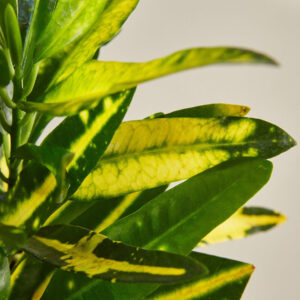
Origin: Southeast Asia and the Pacific Islands
Common Name(s): Sunny Star Croton, Croton 'Sunny Star', Variegated Croton
About the Croton Sunny Star
The 'Sunny Star' variety of Croton stands out for its bright yellow and green variegated leaves that create a dramatic, sunburst-like effect, making it a popular choice for brightening up indoor spaces. The vibrant foliage makes this plant a striking accent in living rooms, sunrooms, or near windows where it can receive plenty of light.
Light
Bright, direct light: This plant loves plenty of light and thrive in direct light. The more sunlight they receive, the more vibrant the leaves become. They can tolerate low light.
Water
Water once a week: This plant prefers weekly watering or when the top 1-2 inches of soil feel dry. Let the top inch of soil dry out slightly between waterings; water throughly.
Temperature & Humidity
Warm temperatures: This plant prefer temperatures between 60-85°F (15-29°C) with very high humidity. Mist the leaves regularly, especially during dry winter months.
How big will my plant grow?
It typically grows to a height of 24 to 36 inches (60 to 90 cm), making it suitable for indoor environments near windows and bright lighting.
Is this plant toxic for pets and kids?
Yes. This plant is toxic to pets and humans if ingested. It can cause symptoms such as nausea, vomiting, and stomach discomfort if ingested. Keep away from pets and children.
🌿 Additional Care Tips:
- Stem Support: If your Croton Sunny Star has long stems, provide support with a moss pole or stake.
- Avoid Cold Drafts: Protect your plant from cold drafts and sudden temperature changes.
- Repot every 2-3 years: This plant doesn’t need frequent repotting. It can be repotted every 2-3 years, or when the roots become cramped.
- Fertilize during growing season: Fertilize your croton once a month during the spring and summer with a balanced liquid houseplant fertilizer diluted to half strength.
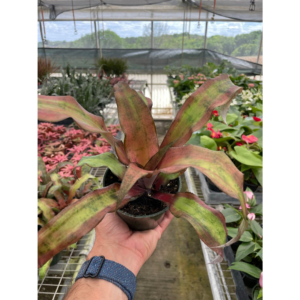
Origin: Brazil
Common Name(s): Earth Star 'Calypso'
About the Cryptanthus Calypso
This plant well known for its dramatic rosette of brightly colored, textured leaves. The plant’s leaves are narrow and form a tight, star-like shape, with hues ranging from deep pink and red to shades of green, creating a vivid and eye-catching display. The Cryptanthus' Calypso' is also adapted to absorb moisture from the air, making it an excellent choice for homes with average humidity.
Light
Bright, indirect light: This plant loves moderate to plenty amount of light. While it can also tolerate low light, do avoid direct sunlight.
Water
Water once a week: This plant requires watering only once a week or when the top 1-2 inches of the soil is dry. It is recommended to water the plant by filling the central "cup" (the rosette of leaves) with water.
Temperature & Humidity
Warm temperatures: This plant prefer temperatures between 6o-80°F (16-27°C) with moderate humidity. Can adapt to average humidity levels.
How big will my plant grow?
It typically reaches a mature size of about 6–12 inches (15–30 cm) in height and 12–18 inches (30–45 cm) in width, making it an excellent choice for smaller spaces, terrariums, or as an accent plant.
Is this plant toxic for pets and kids?
No. This plant is non-toxic to pets and humans, making it a safe and decorative option for households with children or animals.
🌿 Additional Care Tips:
- Repotting: Repot every 1-2 years, or when the plant becomes root-bound.
- Fertilize once a month: Feed your plant with a balanced liquid fertilizer diluted to half strength once a month during the growing season.
- Easily stressed: Avoid placing it near air conditioning vents or heating sources, as extreme temperature fluctuations can stress the plant.
- Avoid cold drafts: Keep your Calypso away from cold drafts and sudden temperature changes.
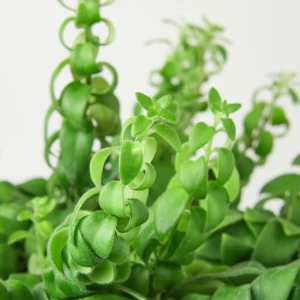
Origin: Southeast Asia
Common Name(s): Curly Lipstick Plant, Curly Aeschynanthus
About the Curly Lipstick Plant
The Curly Lipstick Plant is a unique variety of the traditional Lipstick Plant, renowned for its distinctive curled leaves and vibrant, tubular flowers that resemble lipstick tubes. Its glossy, dark green, and wavy leaves provide an attractive texture that enhances its overall appeal.
Light
Bright, indirect light: This plant thrives in bright, indirect light. Too much direct sun can scorch the leaves. Too little light can reduce flowering.
Water
Water once a week: Be cautious not to overwater, as this can lead to root rot. Adjust frequency to every 1.5-2 weeks in winter months when growth slows.
Temperature & Humidity
Warm temperatures: Lipstick plants prefer warm temperatures, ideally between 65-75°F (18-24°C) with high humidity. Mist plant to improve humidity.
How big will my plant grow?
It typically reaches a mature size of about 12–24 inches (30–60 cm), making it an eye-catching addition to hanging baskets or elevated displays.
Is this plant toxic for pets and kids?
No. This plant is non-toxic to pets and humans, making it a safe and decorative option for households with children or animals.
🌿 Additional Care Tips:
- Unique Foliage: The curly leaves are a distinctive feature; ensure good light for the best leaf development.
- Fertilizing: Use a balanced, diluted liquid fertilizer every 4-6 weeks during the growing season (spring and summer) for optimal growth.
- Pruning: Regularly pinch back stems to encourage bushier growth and remove any dead or damaged leaves.
- Pest Watch: Keep an eye out for common pests like aphids and spider mites; neem oil or insecticidal soap can be effective treatments if needed.
D
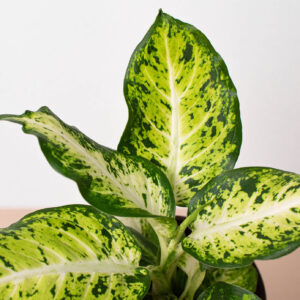
Origin: Central & South America
Common Name(s): Amy Dumb Cane, Dieffenbachia 'Amy'
About the Dieffenbachia Amy
Known for its lush, ornamental foliage, this plant features large, glossy, lance-shaped leaves with a bold pattern of green and creamy white or yellow variegation. It has air-purifying qualities such as the ability to improve indoor air quality by removing toxins such as formaldehyde and benzene from the air, making it an excellent choice for homes and offices.
Light
Bright, indirect light: This plant prefers plenty of light to maintain its vegetation. Avoid direct sunlight to prevent the delicate leaves from scorching.
Water
Water once a week: This plant requires watering only once a week or when the top 1-2 inches of the soil is dry. Soil should be consistently moist; do not overwater.
Temperature & Humidity
Warm temperatures: This plant prefer temperatures between 65-75°F (18-24°C) with moderate to high humidity.
How big will my plant grow?
It typically grows to a height of about 3–4 feet (90–120 cm) indoors, with a spread of approximately 24–36 feet (60–90 cm). This makes it ideal for larger pots or as a statement plant in a room or office.
Is this plant toxic for pets and kids?
Yes, this plant can cause mild skin irritation and a burning sensation if ingested. It is considered toxic to both pets and humans, especially if the sap or leaves are chewed or eaten.
🌿 Additional Care Tips:
- Repotting: Repot every 1-2 years, or when the plant becomes root-bound. Handle with care as the sap can irritate the skin.
- Fertilize once a month: Feed your plant with a balanced liquid fertilizer diluted to half strength once a month during the growing season.
- Prune regularly: Prune your Dieffenbachia to remove damaged or leggy stems and encourage bushier growth.
- Avoid cold drafts: Keep your Dieffenbachia away from cold drafts and sudden temperature changes.
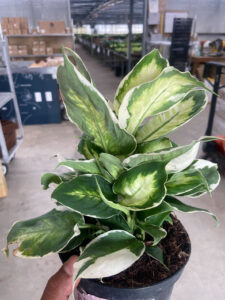
Origin: Central & South America
Common Name(s): Cool Beauty Dumb Cane, Dieffenbachia 'Cool Beauty'
About the Dieffenbachia Cool Beauty
The Dieffenbachia 'Cool Beauty' is an eye-catching cultivar of the Dumb Cane plant, prized for its striking and vibrant foliage. The leaves of this plant are large, glossy, and broad, with a beautiful contrast of deep green and creamy-white variegation. This plant has air-purifying qualities such as the ability to improve indoor air quality by removing toxins such as formaldehyde and benzene from the air, making it an excellent choice all year round.
Light
Bright, indirect light: This plant prefers plenty of light to maintain its vegetation. Avoid direct sunlight to prevent the delicate leaves from scorching.
Water
Water once a week: This plant requires watering only once a week or when the top 1-2 inches of the soil is dry. Soil should be consistently moist; do not overwater.
Temperature & Humidity
Warm temperatures: This plant prefer temperatures between 65-75°F (18-24°C) with moderate to high humidity.
How big will my plant grow?
It typically grows to a height of about 36–48 inches (90–120 cm) indoors, with a spread of approximately 2–3 inches (60–90 cm). It’s a relatively tall and bushy plant that makes a good floor plant or a statement piece in large containers.
Is this plant toxic for pets and kids?
Yes, this plant can cause mild skin irritation and a burning sensation if ingested. It is considered toxic to both pets and humans, especially if the sap or leaves are chewed or eaten
🌿 Additional Care Tips:
- Repotting: Repot every 1-2 years, or when the plant becomes root-bound. Handle with care as the sap can irritate the skin.
- Fertilize once a month: Feed your plant with a balanced liquid fertilizer diluted to half strength once a month during the growing season.
- Prune regularly: Prune your Dieffenbachia to remove damaged or leggy stems and encourage bushier growth.
- Avoid cold drafts: Keep your Dieffenbachia away from cold drafts and sudden temperature changes.
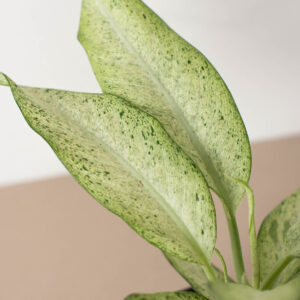
Origin: Central & South America
Common Name(s): Camouflage Dumb Cane, Dieffenbachia 'Camouflage'
About the Dieffenbachia Camouflage
Known for its beautiful and distinctive foliage, this ornamental and decorative plant has leaves that are large, broad, and glossy, with a unique pattern of green and creamy-white variegation that creates the "camouflage" appearance. This plant has air-purifying qualities such as the ability to improve indoor air quality by removing toxins such as formaldehyde and benzene from the air, making it an excellent choice all year round.
Light
Bright, indirect light: This plant prefers plenty of light. It can tolerate low light as well. Avoid direct sunlight to prevent the delicate leaves from scorching.
Water
Water once a week: This plant requires watering only once a week or when the top 1-2 inches of the soil is dry. Soil should be consistently moist; do not overwater.
Temperature & Humidity
Warm temperatures: This plant prefer temperatures between 65-75°F (18-24°C) with moderate humidity. Regular misting is ideal to help with humidity.
How big will my plant grow?
It typically grows to about 3–4 feet (90–120 cm) in height. It has a full, bushy appearance, with multiple stems emerging from the base, creating a dense clump of foliage. Ideal for medium to large spaces.
Is this plant toxic for pets and kids?
Yes, this plant can cause mild skin irritation and the sap is toxic if ingested. It is considered toxic to both pets and humans, especially if the sap or leaves are chewed or eaten.
🌿 Additional Care Tips:
- Repotting: Repot every 1-2 years, or when the plant becomes root-bound. Handle with care as the sap can irritate the skin.
- Fertilize once a month: Feed your plant with a balanced liquid fertilizer diluted to half strength once a month during the growing season.
- Prune regularly: Prune your Dieffenbachia to remove damaged or leggy stems and encourage bushier growth.
- Avoid cold drafts: Keep your Dieffenbachia away from cold drafts and sudden temperature changes.
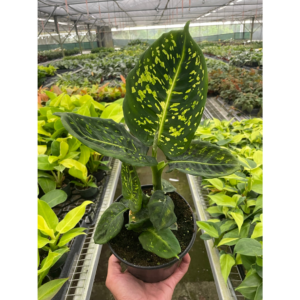
Origin: Central & South America
Common Name(s): Reflector Dumb Cane, Dieffenbachia 'Reflector'
About the Dieffenbachia Reflector
Known for its beautiful and distinctive foliage, this decorative plant has leaves that are large, glossy, and broad, with a striking pattern of light green, white, and cream markings. This creates a marbled or "reflective" effect on the surface. This plant has air-purifying qualities such as the ability to improve indoor air quality by removing toxins such as formaldehyde and benzene from the air, making it an excellent choice for home and offices.
Light
Bright, indirect light: This plant prefers plenty of light. It can tolerate low light as well. Avoid direct sunlight to prevent the delicate leaves from scorching.
Water
Water once a week: This plant requires watering only once a week or when the top 1-2 inches of the soil is dry. Soil should be consistently moist; do not overwater.
Temperature & Humidity
Warm temperatures: This plant prefer temperatures between 65-75°F (18-24°C) with moderate humidity. Regular misting is ideal to help with humidity.
How big will my plant grow?
It typically grows to about 3–4 feet (90–120 cm) in height. Ideal for medium to large spaces and large pots when repotting.
Is this plant toxic for pets and kids?
Yes, this plant contains toxins in its sap, which can cause irritation to the skin, mouth, and throat if ingested. As a result, it is not recommended for homes with small children or pets that might chew on the leaves.
🌿 Additional Care Tips:
- Repotting: Repot every 1-2 years, or when the plant becomes root-bound. Handle with care as the sap can irritate the skin.
- Fertilize once a month: Feed your plant with a balanced liquid fertilizer diluted to half strength once a month during the growing season.
- Prune regularly: Prune your Dieffenbachia to remove damaged or leggy stems and encourage bushier growth.
- Avoid cold drafts: Keep your Dieffenbachia away from cold drafts and sudden temperature changes.
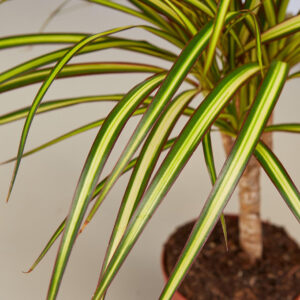
Origin: Madagascar
Common Name(s): Sunshine Dracaena, Dragon Tree 'Sunshine'
About the Dracaena Marginata ‘Sunshine'
This variety of the popular Dracaena marginata. is known for its elegant, arching foliage, with long, narrow leaves that feature a vibrant yellow and green variegation. Its tropical feel works well in a variety of interior design styles, from contemporary to eclectic. The central green stripe runs down the middle of each leaf, while the edges are highlighted with a bold golden yellow, creating the “sunshine” effect. This plant has air-purifying qualities such as the ability to improve indoor air quality by removing toxins such as formaldehyde and benzene from the air, making it an excellent choice for home and offices.
Light
Bright, indirect light: This plant prefers plenty of light to maintain its yellow vegetation. Brighter light enhance the color of the leaves. Avoid direct sunlight to prevent the delicate leaves from scorching.
Water
Water once a week: This plant requires watering only once a week or when the top 1-2 inches of the soil is dry. Soil should be consistently moist; do not overwater.
Temperature & Humidity
Warm temperatures: This plant prefer temperatures between 65-75°F (18-24°C) with moderate to high humidity. Tolerant of fluctuating temperature and humidity.
How big will my plant grow?
It typically grows to about 4–6 feet (120–180 cm) in height. Its long leaves adding a striking vertical element to your space.
Is this plant toxic for pets and kids?
Yes, this plant contains toxins in its sap, which can cause irritation to the skin, mouth, and throat if ingested. As a result, it is not recommended for homes with small children or pets that might chew on the leaves.
🌿 Additional Care Tips:
- Repotting: Repot every 2-3 years, or when the plant becomes root-bound. Handle with care as the sap can irritate the skin.
- Fertilize once a month: Feed your plant with a balanced liquid fertilizer diluted to half strength once a month during the growing season.
- Reduce fertilizing in Winter: During the fall and winter, the plant's growth slows down, so reduce or stop fertilizing during this period.
- Trim leggy growth: If the plant becomes leggy or uneven in shape, you can cut back the stems to encourage a fuller, bushier growth habit.
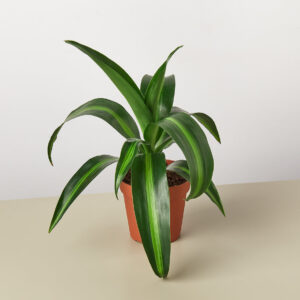
Origin: Africa
Common Name(s): Corn Plant, Massangeana Dracaena, Dracaena Massangeana
About the Dracaena Massangeana
A popular and easy-to-grow houseplant known for its long, glossy, lance-shaped leaves that are a rich, deep green with creamy yellow stripes running down the center of each leaf. This plant has air-purifying qualities such as the ability to improve indoor air quality by removing toxins such as formaldehyde and benzene from the air, making it an excellent choice. This makes it a favorite for adding vertical height and a touch of tropical flair to indoor spaces.
Light
Bright, indirect light: This plant prefers plenty of light to maintain its yellow vegetation. Avoid direct sunlight to prevent the delicate leaves from scorching.
Water
Water once a week: This plant requires watering only once a week or when the top 1-2 inches of the soil is dry. Soil should be consistently moist; do not overwater.
Temperature & Humidity
Warm temperatures: This plant prefer temperatures between 65-75°F (18-24°C) with moderate to high humidity. Tolerant of fluctuating temperature and humidity.
How big will my plant grow?
It typically grows to about 4–6 feet (120–180 cm) in height. Its remains compact as it grows. It has a slow growth rate and is very easy to care as it grows.
Is this plant toxic for pets and kids?
Yes, this plant contains toxins in its sap, which can cause irritation to the skin, mouth, and throat if ingested. As a result, it is not recommended for homes with small children or pets like cats and dogs.
🌿 Additional Care Tips:
- Repotting: Repot every 2-3 years, or when the plant becomes root-bound. Handle with care as the sap can irritate the skin.
- Fertilize once a month: Feed your plant with a balanced liquid fertilizer diluted to half strength once a month during the growing season.
- Prune regularly: Prune your Dracaena to remove damaged or leggy stems and encourage bushier growth.
- Reduce fertilizing in Winter: During the fall and winter, the plant's growth slows down, so reduce or stop fertilizing during this period.
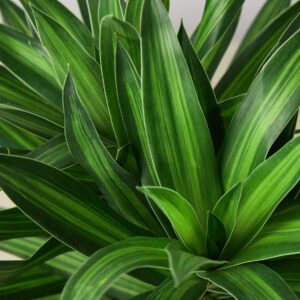
Origin: Africa
Common Name(s): Song of Jamaica Dracaena, Dracaena 'Song of Jamaica'
About the Dracaena Reflexa Song of Jamaica
This striking variety of the Dracaena is recognized for its dramatic foliage and vibrant color patterns, featuring long, lance-shaped leaves that are a rich green in the center with wide, bright yellow stripes along the edges making it a standout in any indoor setting. This Dracaena has air-purifying qualities such as the ability to improve indoor air quality by removing toxins such as formaldehyde and benzene from the air. It is the ultimate choice for adding height and visuals to any to home or office environments.
Light
Bright, indirect light: This plant prefers plenty of light to maintain its yellow and green vegetation. Can tolerate lower light levels. Avoid direct sunlight.
Water
Water once a week: This plant requires watering only once a week or when the top 1-2 inches of the soil is dry. Soil should be consistently moist; do not overwater. Use distilled water if possible.
Temperature & Humidity
Warm temperatures: This plant prefer temperatures between 65-75°F (18-24°C) with moderate to high humidity. Mist the plant to help with humidity levels.
How big will my plant grow?
It typically grows to about 4–6 feet (120–180 cm) in height, though it may take several years to reach its full height. The plant can develop a slender trunk or stem as it matures, with the bushy crown of leaves at the top.
Is this plant toxic for pets and kids?
Yes, this plant contains saponins, which can cause irritation to the skin, mouth, and throat if ingested. As a result, it is not recommended for spaces with small children or pets like cats and dogs.
🌿 Additional Care Tips:
- Repotting: Repot every 2-3 years, or when the plant becomes root-bound. Handle with care as the sap can irritate the skin.
- Fertilize once a month: Feed your plant with a balanced liquid fertilizer diluted to half strength once a month during the growing season.
- Prune regularly: Prune your Dracaena to remove damaged or leggy stems and encourage bushier growth.
- Avoid cold drafts: Keep your Dracaena away from cold drafts and sudden temperature changes.
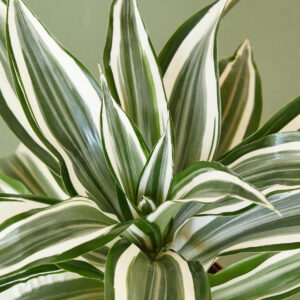
Origin: Africa
Common Name(s): White Jewel Dracaena, Warneckii 'White Jewel'
About the Dracaena Warneckii ‘White Jewel'
This striking variety of the Dracaena is recognized for its attractive variegated foliage, featuring long, lance-shaped leaves with bold green centers framed by wide, creamy white or light silver stripes along the edges. This Dracaena has air-purifying qualities such as the ability to improve indoor air quality by removing toxins such as formaldehyde and benzene from the air. Its a favorite choice for adding texture and vertical interest to both home and office environments.
Light
Bright, indirect light: This plant prefers plenty of light to maintain its creamy-white vegetation. Avoid direct sunlight to prevent brown spots on the leaves.
Water
Water once a week: This plant requires watering only once a week or when the top 1-2 inches of the soil is dry. Soil should be consistently moist; do not overwater. Use distilled water if possible.
Temperature & Humidity
Warm temperatures: This plant prefer temperatures between 65-75°F (18-24°C) with moderate humidity. Mist the plant to help with humidity levels.
How big will my plant grow?
It typically grows to about 3–5 feet (90–150 cm) in height. It may grow more slowly in lower light conditions.
Is this plant toxic for pets and kids?
Yes, this plant contains toxins in its sap, which can cause irritation to the skin, mouth, and throat if ingested. As a result, it is not recommended for homes with small children or pets like cats and dogs.
🌿 Additional Care Tips:
- Repotting: Repot every 2-3 years, or when the plant becomes root-bound. Handle with care as the sap can irritate the skin.
- Fertilize once a month: Feed your plant with a balanced liquid fertilizer diluted to half strength once a month during the growing season.
- Prune regularly: Prune your Dracaena to remove damaged or leggy stems and encourage bushier growth.
- Reduce fertilizing in Winter: During the fall and winter, the plant's growth slows down, so reduce or stop fertilizing during this period.
E
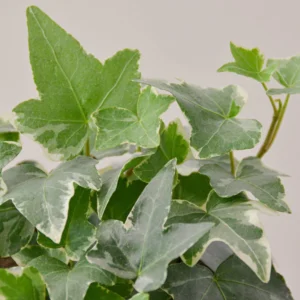
Origin: Europe & Western Asia
Common Name(s): English Ivy ‘Glacier’
About the English Ivy Glacier
The English Ivy ‘Glacier’ is a popular variegated ivy variety known for its small, gray-green leaves edged in white or silver, making it a charming choice for both indoor and outdoor settings. Native to Europe and Western Asia, this climbing vine can reach several feet long, especially when given something to climb on, but can also be kept in a more compact form through pruning. It has standout air-purifying qualities such as the ability to filter indoor air pollutants consistently. This plant is an excellent choice for homes and outdoors.
Light
Bright, indirect light: This plant prefers bright, indirect light. It can tolerate lower light conditions, but it may grow more slowly and have less vibrant leaves.
Water
Water moderately: Allow the top inch of soil to dry out between waterings. Avoid overwatering, as this can lead to root rot.
Temperature & Humidity
Cool temperatures: English Ivy prefers cooler temperatures, ideally between 55-65°F (13-18°C) and with low-to-moderate humidity.
How big will my plant grow?
When used as a hanging or trailing plant, It typically grows to a height of about 72–120 inches (1–3m). If allowed to climb, it can also extend its reach vertically, covering walls or trellises.
Is this plant toxic for pets and kids?
Yes, the English Ivy is toxic to pets and humans if ingested, potentially causing nausea, skin irritation, or digestive discomfort. This plant is best suited to homes without curious pets or young children.
🌿 Additional Care Tips:
- Climbing or trailing: English Ivy is a vining plant that can be trained to climb a trellis or allowed to trail.
- Pruning: Regularly prune your English Ivy to maintain its desired shape and size. You can also prune to encourage bushier growth.
- Toxic to pets: English Ivy is toxic to cats and dogs. Keep it out of reach of pets.
- Air purifying qualities: English Ivy is known to help purify the air by removing toxins.
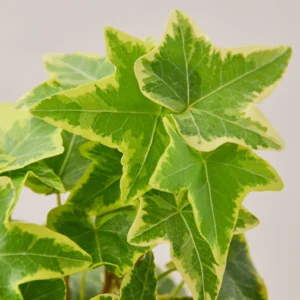
Origin: Europe & Western Asia
Common Name(s): English Ivy ‘Gold Child’
About the English Ivy Gold Child
This ivy variety, native to Europe and Western Asia, has a more compact growth habit, though its trailing vines can still grow several feet long if left untrimmed. Its unique coloring and dense foliage make it a popular choice for hanging baskets or as an elegant tabletop plant. It has standout air-purifying qualities such as the ability to filter indoor air pollutants consistently.
Light
Bright, indirect light: This variegated English Ivy variety requires bright, indirect light to maintain its vibrant golden color.
Water
Water moderately: Water once a week, letting the top inch of soil dry out between waterings. Avoid overwatering, as this can lead to root rot.
Temperature & Humidity
Cool temperatures: English Ivy prefers cooler temperatures, ideally between 55-65°F (13-18°C) and thrives in moderate humidity.
How big will my plant grow?
When used as a hanging or trailing plant, It typically grows to a height of about 72–120 inches (1–3m). If allowed to climb, it can also extend its reach vertically, covering walls or trellises.
Is this plant toxic for pets and kids?
Yes, the English Ivy is toxic to pets and humans if ingested, potentially causing nausea, skin irritation, or digestive discomfort. This plant is best suited to homes without curious pets or young children.
🌿 Additional Care Tips:
- Fertilizing: Feed monthly with a balanced, diluted liquid fertilizer, especially during the spring and summer months.
- Variegation Maintenance: Rotate the plant periodically to ensure even light exposure, helping maintain its beautiful variegated leaf pattern.
- Pruning: Trim back overgrown vines to encourage a fuller, bushy appearance.
- Pest Alert: Watch for spider mites, as they are especially attracted to English Ivy. Regularly misting the leaves may help deter them.
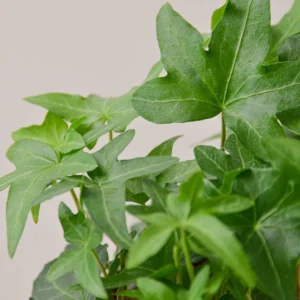
Origin: Europe & Western Asia
Common Name(s): English Ivy ‘Green California’
About the English Ivy Green California
Native to Europe and Western Asia, this fast-growing ivy can quickly cover surfaces with its trailing vines, making it popular for hanging baskets, indoor pots, and outdoor ground cover. Indoors, it can grow several feet in length if not pruned, adding a touch of greenery to various spaces. It has standout air-purifying qualities such as the ability to filter indoor air pollutants consistently.
Light
Bright, indirect light: This plant prefers bright, indirect light. It can tolerate lower light conditions, but it may grow more slowly and have less vibrant leaves.
Water
Water moderately: Allow the top inch of soil to dry out between waterings. Avoid overwatering, as this can lead to root rot.
Temperature & Humidity
Cool temperatures: English Ivy prefers cooler temperatures, ideally between 55-65°F (13-18°C) with moderate humidity.
How big will my plant grow?
When used as a hanging or trailing plant, It typically grows to a height of about 72–120 inches (1–3m). If allowed to climb, it can also extend its reach vertically, covering walls or trellises.
Is this plant toxic for pets and kids?
Yes, the English Ivy is toxic to pets and humans if ingested, potentially causing nausea, skin irritation, or digestive discomfort. This plant is best suited to homes without curious pets or young children.
🌿 Additional Care Tips:
- Pruning: Trim regularly to control growth and encourage bushiness.
- Fertilizing: Feed with a balanced liquid fertilizer once a month, especially during the spring and summer.
- Climbing or trailing: English Ivy is a vining plant that can be trained to climb a trellis or allowed to trail.
- Repotting: Repot every 1-2 years in a well-draining soil mix to prevent root congestion.
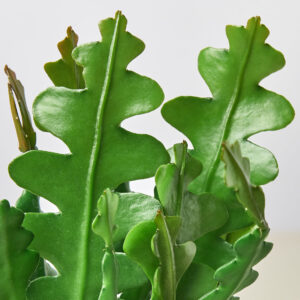
Origin: Central & South America
Common Name(s): Ric Rac Cactus, Fishbone Cactus, Orchid Cactus
About the Epiphyllum ‘Ric Rac’ Cactus
Thriving in the shaded understory of rainforests. The 'Ric Rac' variety is particularly admired for its unusual, curled, or “ric rac” stems that give it a distinctive look, making a popular choice fro home and tabletops. It is visually striking with zigzag-shaped, fishbone-like stems and large colorful blooms.
Light
Bright, indirect light: This plant prefers plenty of light to maintain its fresh vegetation. It can tolerate direct sunlight in the mornings and afternoon. Avoid midday sun.
Water
Water once every 2-3 weeks: This plant stores water in the leaves and stem so it does not require frequent watering. Allow soil to dry out between waterings.
Temperature & Humidity
Warm temperatures: This plant prefer temperatures between 60-85°F (16-29°C) with low to moderate humidity. It can tolerate slightly cooler temperature but avoid freezing conditions.
How big will my plant grow?
This plant is typically a fast-growing plant, with its stems reaching 36–72 inches (90–180 cm) in length if grown as a trailing plant. It will often spill over the sides of containers, baskets, or shelves, creating a cascading effect.
Is this plant toxic for pets and kids?
No. While not toxic to humans or pets, it’s always best to keep plants out of reach of young children and animals.
🌿 Additional Care Tips:
- Propagate as needed: It can be propagated by stem cuttings or leaf cuttings only when necessary. Allow the cut end to callus for 1-2 days before planting it in well-draining soil.
- Watch for Pests: Watch out for mealybugs and scale insects, which can infest cactus plants.
- Fertilize sparingly: Feed your plant with a balanced liquid fertilizer diluted to half strength once or twice a year during the growing season.
- Reduce watering during winter: During winter, reduce watering and move the plant to a cooler, brighter location.
F
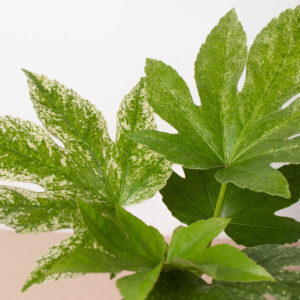
Origin: East Asia
Common Name(s): Spider’s Web Fatsia, Japanese Aralia 'Spider's Web'
About the Fatsia ‘Spider’s Web’
This striking phenom of the Japanese Aralia, prized for its bold, ornamental foliage and dramatic appearance. This striking variegation gives the plant an almost frosted or webbed effect, adding an elegant and textured touch to any space.
Light
Bright, indirect light: This plant prefers plenty of light to maintain its fresh vegetation. It can tolerate direct sunlight in the mornings and afternoon. Avoid midday sun.
Water
Water once every 2-3 weeks: This plant stores water in the leaves and stem so it does not require frequent watering. Allow soil to dry out between waterings.
Temperature & Humidity
Warm temperatures: This plant prefer temperatures between 60-85°F (16-29°C) with low to moderate humidity. It can tolerate slightly cooler temperature but avoid freezing conditions.
How big will my plant grow?
This plant typically grows to a height of 4–7 feet (120–180 cm). It has a bushy growth habit, with dense foliage that makes it an excellent choice for adding structure to your indoor space.
Is this plant toxic for pets and kids?
No. While not toxic to humans or pets, it’s always best to keep plants out of reach of young children and animals.
🌿 Additional Care Tips:
- Repotting: Repot every 1-2 years, or when the plant becomes root-bound. Handle with care as the sap can be sensitive to the skin.
- Cut Back in Spring: If needed, prune back the plant in the spring when new growth begins..
- Ensure Good Drainage: Make sure the pot has good drainage holes, and avoid letting the plant sit in water, as this can lead to root rot.
- Monitor pet infestations: Watch out for common houseplant pests like mealybugs and spider mites. Treat infestations promptly with insecticidal soap or neem oil.
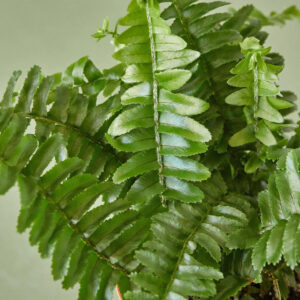
Origin: Southeast Asia
Common Name(s): Jester’s Crown Fern, Kangaroo Fern
About the Fern Jester’s Crown
This fern is renowned for its attractive, rounded fronds that emerge in a distinct, crown-like shape, which gives the plant its "Jester's Crown" name. It thrives in warm, humid conditions but is adaptable to typical indoor environments, making it an excellent choice for both novice and experienced plant lovers. This fern is ideal for tabletops, where it forms a neat, compact mound of attractive foliage.
Light
Bright, indirect light: This plant prefers plenty of light to maintain its vibrant green color. Can tolerate lower light levels but it will slow growth. Avoid direct sunlight.
Water
Water once a week: This plant requires watering only once a week or when the top 1-2 inches of the soil is dry. A consistently moist and well-draining soil is preferred.
Temperature & Humidity
Warm temperatures: This plant prefer temperatures between 65-75°F (15-24°C) with very high humidity. Sensitive to cold and temperate changes. Occasional misting is recommended.
How big will my plant grow?
While it typically grows to about 12-18 inches (30-45 cm) tall, it can spread wider, making it a great addition to both small and larger plant displays.
Is this plant toxic for pets and kids?
No. While not toxic to humans or pets, it’s always best to keep plants out of reach of young children and animals.
🌿 Additional Care Tips:
- Repotting: Repot every 1-2 years, or when the plant becomes root-bound.
- Fertilize every 2-3 weeks during growing season: Feed your plant with a balanced liquid fertilizer diluted to half strength every 2-3 weeks during the growing season.
- Prune regularly: Prune your Fern to remove damaged or dead leaves to maintain a health appearance.
- Avoid drafts: Keep your Jester's Crown Fern away from cold drafts and sudden temperature changes.
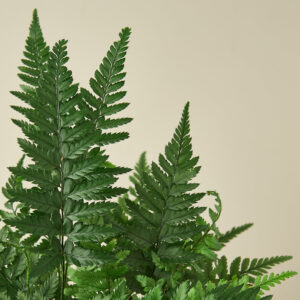
Origin: Southeast Asia
Common Name(s): Korean Rock Fern, Tsus-simense Fern, Rock Shield Fern
About the Fern Korean Rock
This hardy, evergreen fern is known for its compact, low-growing habit and its deep green, leathery fronds. Its arching fronds are often described as having a "shield-like" shape, which gives the plant an elegant, robust appearance. It thrives in temperate, shaded environments but adapts easily to typical indoor conditions, making it a great option for both beginners and experienced plant owners.
Light
Low, indirect light: This plant prefers low to moderate light to maintain its deep green color. Avoid direct sunlight and extremely bright lights.
Water
Water once a week: This plant requires watering only once a week or when the top 1-2 inches of the soil is dry. Avoid overwatering.
Temperature & Humidity
Cool to Moderate temperatures: This plant prefer temperatures between 60-75°F (15-24°C) with moderate to high humidity. Thrives best in very cool temperature.
How big will my plant grow?
It typically grows to about 12-18 inches (30-45 cm) tall. Its small size and elegant form make it a wonderful choice for tabletops or a hanging plant.
Is this plant toxic for pets and kids?
No. The Korean Rock Fern is non-toxic to pets, making it a safe choice for households with cats and dogs.
🌿 Additional Care Tips:
- Repotting: Repot every 2-3 years, or when the fern becomes root-bound.
- Prune regularly: Cut off any yellowing or damaged fronds to maintain the fern’s tidy appearance. This can also encourage new growth.
- Keep away from heat: When grown indoors, place the fern in a low, indirect light location. Avoid placing it near heat sources, in dry air, bright lights or air conditioning vents.
- Avoid overfertilizing: Ferns generally don’t require heavy feeding. Too much fertilizer can lead to excessive growth and weaker foliage. Fertilize only once a month during the growing season.
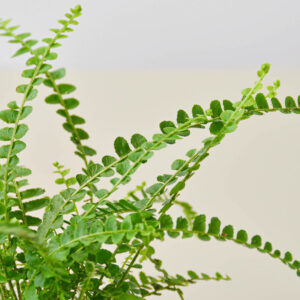
Origin: Central & South America
Common Name(s): Lemon Button Fern, Dwarf Sword Fern
About the Fern Lemon Button
This fern is small, compact fern that’s perfect for adding texture and greenery to any indoor space. It is especially prized for its delicate, bright green fronds that have a soft, rounded appearance, resembling little "buttons" or beads along the length of each leaf, which is how it earned its nam. It thrives in warm, humid conditions but is adaptable to typical indoor environments, making it an excellent choice for both novice and experienced plant lovers.
Light
Bright, indirect light: This plant prefers plenty of light to maintain its vibrant green color. Can tolerate lower light levels but it will slow growth. Avoid direct sunlight.
Water
Water once a week: This plant requires watering only once a week or when the top 1-2 inches of the soil is dry. A consistently moist and well-draining soil is preferred.
Temperature & Humidity
Warm temperatures: This plant prefer temperatures between 60-75°F (15-24°C) with very high humidity. Sensitive to cold and temperate changes. The occasional misting is recommended.
How big will my plant grow?
While it typically grows to about 8-12 inches (20-30 cm) tall, its stature makes it ideal for small spaces.
Is this plant toxic for pets and kids?
No. While not toxic to humans or pets, it’s always best to keep plants out of reach of young children and animals.
🌿 Additional Care Tips:
- Repotting: Repot every 1-2 years, or when the plant becomes root-bound.
- Fertilize once a month: Feed your plant with a balanced liquid fertilizer diluted to half strength once a month during the growing season.
- Avoid Dry Air: Lemon Button Ferns are sensitive to dry air, so keep them away from heating vents and air conditioners.
- Avoid drafts: Keep your Lemon Button Fern away from cold drafts and sudden temperature changes.
- Watch for yellowing Leaves: Yellow leaves can be a sign of overwatering, poor drainage, or a lack of nutrients.
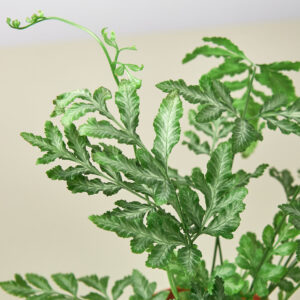
Origin: Europe & Asia
Common Name(s): Silver Lace Fern, Soft Shield Fern
About the Fern Silver Lace
This Fern is a beautiful and elegant fern known for its soft, feathery texture and striking silver-toned foliage. The plant’s delicate, lacy fronds are a silvery green with a soft, almost metallic sheen, giving the fern its "silver lace" appearance. It thrives in temperate, shaded environments but adapts easily to typical indoor conditions, making it a great option for both beginners and experienced plant owners.
Light
Bright, indirect light: This plant prefers plenty of light to maintain its silvery green color. Can tolerate lower light levels but it will slow growth. Avoid direct sunlight.
Water
Water once a week: This plant requires watering only once a week or when the top 1-2 inches of the soil is dry. Allow roots to dry out completely before watering.
Temperature & Humidity
Warm temperatures: This plant prefer temperatures between 60-75°F (15-24°C) with very high humidity. Sensitive to the cold and extreme heat.
How big will my plant grow?
It typically grows to about 12-24 inches (30-60 cm) tall. Its compact size and elegant form make it a wonderful choice for pots, containers, or hanging baskets.
Is this plant toxic for pets and kids?
No. While not toxic to humans or pets, it’s always best to keep plants out of reach of young children and pets.
🌿 Additional Care Tips:
- Repotting: Repot every 1-2 years, or when the plant becomes root-bound.
- Prune regularly: Prune dead or yellowing fronds to encourage new growth and maintain the plant's tidy appearance.
- Avoid Dry Air: Fern Silver Lace sensitive to dry air, so keep them away from heating vents and air conditioners.
- Avoid drafts: Keep your Fern away from cold drafts and sudden temperature changes.
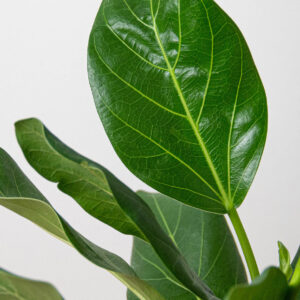
Origin: Southeast Asia
Common Name(s): Ficus Audrey, Bengal Fig, Indian Banyan
About the Ficus Audrey
The Ficus Audrey is an elegant and striking houseplant known for its lush, glossy leaves and tree-like form. This species is often found growing as a large, spreading tree in the wild. Indoors, it is typically grown as a beautiful, ornamental plant that adds a tropical, architectural element to any space.
Light
Bright, indirect light: This plant prefers plenty of light to maintain its vibrant green color. Can tolerate lower light levels but plant may become leggy. Avoid direct sunlight.
Water
Water once a week: This plant requires watering only once a week or when the top 1-2 inches of the soil is dry. Avoid overwatering.
Temperature & Humidity
Warm temperatures: This plant prefer temperatures between 60-75°F (16-24°C) with moderate to high humidity. Stable temperature is preferred.
How big will my plant grow?
It can grow up to 3-6 feet (1-2 meters) tall indoors with proper care, though it can be pruned to maintain a compact size.
Is this plant toxic for pets and kids?
Yes, this plant is mildly toxic to pets, especially cats and dogs, if ingested. The plant contains a sap that can cause stomach ache and can irritate the skin or eyes. Keep out of reach from pets and children.
🌿 Additional Care Tips:
- Repotting: Repot every 1-2 years, or when the ficus becomes root-bound. Handle with care as the sap can irritate the skin.
- Prune regularly: Prune to rid dead leaves and to encourage new growth.
- Fertilize once a month: Feed your plant with a balanced liquid fertilizer diluted to half strength once a month during the growing season.
- Avoid drafts: Keep your Ficus away from cold drafts and sudden temperature changes.
- Encouraging branching: To encourage more branching, pinch back the tips of the stems, which helps the plant become fuller.

Origin: Southeast Asia
Common Name(s): Tineke Rubber Plant, Variegated Rubber Plant
About the Ficus Elastica Tineke
The Ficus 'Tineke' is a stunning and popular variety of the Rubber Plant, known for its bold, glossy, variegated foliage. It features large, thick, dark green leaves with beautiful creamy-white or pale yellow streaks, giving it a marbled appearance. This plant has an upright, tree-like form with leathery, oblong leaves that grow alternately along thick stems, giving it a bold, architectural presence.
Light
Bright, indirect light: This plant prefers plenty of light to maintain its vibrant green color. Can tolerate lower light levels but plant may become leggy. Avoid direct sunlight.
Water
Water once a week: This plant requires watering only once a week or when the top 1-2 inches of the soil is dry. Avoid overwatering.
Temperature & Humidity
Warm temperatures: This plant prefer temperatures between 60-75°F (16-24°C) with moderate humidity. Stable temperature is preferred.
How big will my plant grow?
It can grow up to 6-10 feet (1.8-3 meters) tall indoors, though it can be pruned to maintain a more compact size.
Is this plant toxic for pets and kids?
Yes, this plant is mildly toxic to pets, especially cats and dogs, if ingested. The plant contains a sap that can cause stomach ache and can irritate the skin or eyes. Keep out of reach from pets and children.
🌿 Additional Care Tips:
- Repotting: Repot every 1-2 years, or when the ficus becomes root-bound. Handle with care as the sap can irritate the skin.
- Prune regularly: Prune to rid dead leaves and to encourage new growth.
- Fertilize once a month: Feed your plant with a balanced liquid fertilizer diluted to half strength once a month during the growing season.
- Use organic fertilizers: Organic options, such as worm castings or compost, can be used in place of synthetic fertilizers.
- Encouraging branching: To encourage more branching, pinch back the tips of the stems, which helps the plant become fuller.
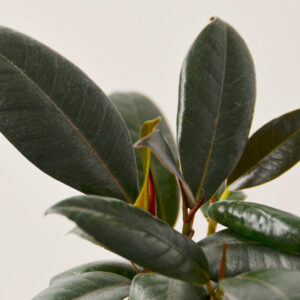
Origin: Southeast Asia
Common Name(s): Burgundy Rubber Plant, Red Rubber Plant, Rubber Tree
About the Ficus Elastica Burgundy
The Ficus Elastica 'Burgundy' is a striking and popular indoor plant choice, distinguished by its deep, rich burgundy-colored leaves. The dark, almost purple tone of the leaves, especially on new growth, gives the Burgundy Rubber Plant a dramatic, bold appearance, making it an eye-catching addition to any home or office space.
Light
Bright, indirect light: This plant prefers plenty of light to maintain its vibrant green color. Can tolerate lower light levels but plant may become less saturated. Avoid direct sunlight.
Water
Water once a week: This plant requires watering only once a week or when the top 1-2 inches of the soil is dry. Avoid overwatering. Ensure pot has good drainage.
Temperature & Humidity
Warm temperatures: This plant prefer temperatures between 60-75°F (16-24°C) with moderate to high humidity. Stable temperature is preferred.
How big will my plant grow?
It can grow up to 6-10 feet (1.8-3 meters) tall indoors with proper care, though it can be pruned to maintain an ideal size.
Is this plant toxic for pets and kids?
Yes, this plant is mildly toxic to pets, especially cats and dogs, if ingested. Keep pets and children away from the plant at all times.
🌿 Additional Care Tips:
- Repotting: Repot every 1-2 years, or when the ficus becomes root-bound. Handle with care as the sap can irritate the skin.
- Prune regularly: Prune regularly to remove any dead or damaged leaves and leggy growth to encourage new growth.
- Fertilize once a month: Feed your plant with a balanced liquid fertilizer diluted to half strength once a month during the growing season.
- Avoid drafts: Keep your Ficus away from cold drafts and sudden temperature changes.
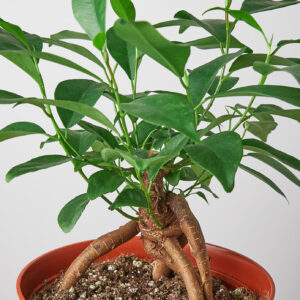
Origin: Southeast Asia
Common Name(s): Ginseng Ficus, Ginseng Bonsai, Ficus Ginseng
About the Ficus Ginseng
This intriguing plant features a wide, knobby trunk that tapers upward into a dense canopy of glossy, dark green leaves. The Ginseng Ficus is particularly prized for its unusual, bulbous root structure, which makes it a favorite among bonsai enthusiasts and those looking to add a touch of the exotic to their home décor.
Light
Low, indirect light: This plant prefers low to moderate light to maintain its deep green color. Avoid direct sunlight and extremely bright lights.
Water
Water once a week: This plant requires watering only once a week or when the top 1-2 inches of the soil is dry. Avoid overwatering.
Temperature & Humidity
Cool to Moderate temperatures: This plant prefer temperatures between 60-75°F (15-24°C) with moderate to high humidity. Thrives best in very cool temperature.
How big will my plant grow?
It can grow to a height of 3-5 feet (90-150 cm) when potted. It is typically kept smaller and more compact through pruning and training.
Is this plant toxic for pets and kids?
Yes, the Ginseng Ficus is mildly toxic to pets, especially cats and dogs, if ingested. Keep out of reach from pets and children.
🌿 Additional Care Tips:
- Repotting: Repot every 1-2 years, or when the fern becomes root-bound.
- Prune regularly: To maintain a bonsai-like appearance, prune the Ficus Ginseng regularly. Remove any dead or damaged leaves and leggy growth to encourage a more compact shape.
- Fertilize once a month: Feed your plant with a balanced liquid fertilizer diluted to half strength once a month during the growing season.
- Avoid drafts and frost: Keep your Ficus away from cold drafts and sudden temperature changes so it should be brought indoors if grown outside in cooler climates.
G
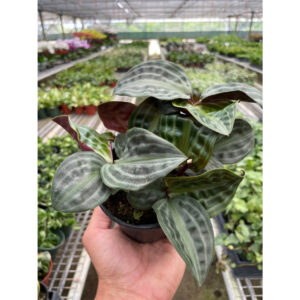
Origin: South America
Common Name: Seersucker Geogenanthus
About the Geogenanthus Seersucker
The Geogenanthus 'Seersucker' is an eye-catching and distinctive houseplant that brings a unique texture and color to any space. It prized for its striking foliage and ornamental appeal. Its soft, low-growing rosette of leaves creates a lush, ground-cover-like appearance, making it perfect for adding texture to tropical plant arrangements.
Light
Bright, indirect light: This plant prefers plenty of light to maintain its vibrant green color. Can tolerate lower light levels but coloration may become dull. Avoid direct sunlight.
Water
Water once a week: This plant requires watering only once a week or when the top 1-2 inches of the soil is dry. Avoid overwatering to prevent root from rotting.
Temperature & Humidity
Warm temperatures: This plant prefer temperatures between 65-80°F (18-27°C) with moderate to high humidity. Misting is recommended especially during winter months.
How big will my plant grow?
This plant typically grows to a height of 6–12 inches (15–30 cm). The plant has a modest growth habit making it an ideal choice for smaller spaces.
Is this plant toxic for pets and kids?
No. While not toxic to humans or pets, it’s always best to keep plants out of reach of young children and animals.
🌿 Additional Care Tips:
- Repotting: Repot every 1-2 years, or when the seersucker becomes root-bound.
- Propagate as needed: You can propagate Seersucker plants by dividing the plant or by taking leaf cuttings.
- Fertilize once a month: Feed your plant with a balanced liquid fertilizer diluted to half strength once a month during the growing season.
- Avoid drafts: Keep your seersucker away from cold drafts and sudden temperature changes.
H
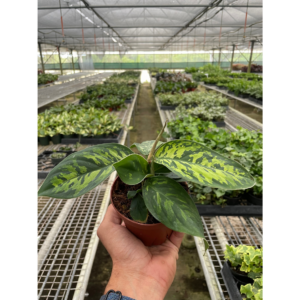
Origin: Southeast Asia
Common Name(s): Camouflage Homalomena, Camouflage Plant
About the Homalomena Camouflage
The 'Camouflage' variety is particularly valued for its unique, mottled leaf appearance, which features a blend of deep green and silvery-gray markings that resemble a camouflage pattern. The contrast in coloration gives the plant a modern and decorative look, making it a popular choice for interior spaces. It's bushy, upright growth habit, making it suitable for tabletops, desks, or small spaces.
Light
Bright, indirect light: This plant prefers plenty of light to maintain its vibrant green color. Can tolerate lower light levels but leaves may lose its vibrancy. Avoid direct sunlight.
Water
Water once a week: This plant requires watering only once a week or when the top 1-2 inches of the soil is dry. Avoid overwatering to prevent root from rotting.
Temperature & Humidity
Warm temperatures: This plant prefer temperatures between 65-80°F (18-27°C) with moderate to high humidity. Avoid temperatures below 50°F.
How big will my plant grow?
This plant typically grows to a height of 12-18 inches (30–45 cm), with a bushy, upright growth habit.
Is this plant toxic for pets and kids?
Yes. It is toxic to pets, including cats and dogs, if ingested. It contains compounds that can cause digestive upset, so it's important to keep the plant out of reach of curious pets.
🌿 Additional Care Tips:
- Prune as needed: Remove any yellowing or damaged leaves to maintain a healthy appearance.
- Propagate as needed: You can propagate this plants by dividing the plant or by taking stem cuttings.
- Fertilize once a month: Feed your plant with a balanced liquid fertilizer diluted to half strength once a month during the growing season.
- Avoid drafts: Avoid placing the plant near cold drafts or air conditioning vents.
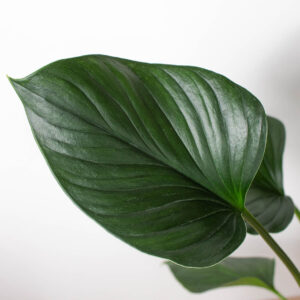
Origin: Southeast Asia
Common Name(s): Emerald Gem Homalomena, Emerald Homalomena
About the Homalomena Emerald Gem
The 'Emerald Gem' variety is highly prized for its dark, emerald green leaves that have a smooth, almost waxy finish, adding a sophisticated, tropical vibe to any space. Its compact growth habit makes it an excellent choice for tabletops, shelves, or smaller indoor gardens. It is a very vibrant low maintenance houseplant.
Light
Bright, indirect light: This plant prefers plenty of light to maintain its vibrant green color. Can tolerate lower light levels but leaves may lose its vibrancy. Avoid direct sunlight.
Water
Water once a week: This plant requires watering only once a week or when the top 1-2 inches of the soil is dry. Avoid overwatering to prevent root from rotting.
Temperature & Humidity
Warm temperatures: This plant prefer temperatures between 65-80°F (18-27°C) with moderate to high humidity. Avoid temperatures below 50°F.
How big will my plant grow?
This plant typically grows to a height of 12-18 inches (30–45 cm). The plant has a modest growth habit making it an ideal choice for smaller spaces.
Is this plant toxic for pets and kids?
Yes. It is toxic to pets, including cats and dogs, if ingested. It contains compounds that can cause digestive upset, so it's important to keep the plant out of reach of curious pets.
🌿 Additional Care Tips:
- Prune as needed: Remove any yellowing or damaged leaves to maintain a healthy appearance.
- Propagate as needed: You can propagate this plants by dividing the plant or by taking stem cuttings.
- Fertilize once a month: Feed your plant with a balanced liquid fertilizer diluted to half strength once a month during the growing season.
- Avoid drafts: Avoid placing the plant near cold drafts or air conditioning vents.
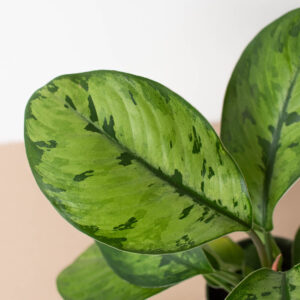
Origin: Southeast Asia
Common Name(s): Selby Homalomena, Selby Shield Plant
About the Homalomena Selby
The Homalomena 'Selby' is a striking and elegant houseplant known for its attractive, glossy foliage and easy-to-care-for nature. This plant is prized for its deep green glossy heart-shaped leaves that have a velvety texture and subtle sheen, making it a beautiful addition to both tropical plant collections and minimalist décor.
Light
Bright, indirect light: This plant prefers plenty of light to maintain its vibrant green color. Can tolerate lower light levels but leaves may lose its vibrancy. Avoid direct sunlight.
Water
Water once a week: This plant requires watering only once a week or when the top 1-2 inches of the soil is dry. Avoid overwatering to prevent root from rotting.
Temperature & Humidity
Warm temperatures: This plant prefer temperatures between 65-80°F (18-27°C) with moderate to high humidity. Avoid temperatures below 50°F.
How big will my plant grow?
This plant typically grows to a height of 12-18 inches (30–45 cm). The plant has a modest growth habit making it an ideal choice for smaller spaces.
Is this plant toxic for pets and kids?
Yes. It is toxic to pets, including cats and dogs, if ingested. It contains compounds that can cause digestive upset, so it's important to keep the plant out of reach of curious pets.
🌿 Additional Care Tips:
- Prune as needed: Remove any yellowing or damaged leaves to maintain a healthy appearance.
- Propagate as needed: You can propagate this plants by dividing the plant or by taking stem cuttings.
- Fertilize once a month: Feed your plant with a balanced liquid fertilizer diluted to half strength once a month during the growing season.
- Avoid drafts: Avoid placing the plant near cold drafts or air conditioning vents.
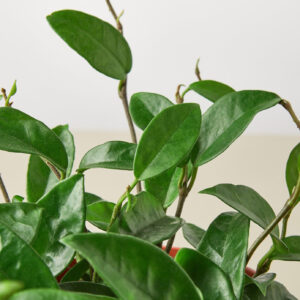
Origin: East & Southeast Asia
Common Name(s): Wax Plant, Porcelain Flower
About the Hoya Carnosa
The Hoya Carnosa is one of the most popular and widely grown species of the Hoya genus. Known for its thick, waxy leaves, fragrant star-shaped flowers, and low-maintenance care requirements, this plant is a favorite among beginners and indoor plant enthusiasts. Native to East and Southeast Asia, this species has become a staple in homes and offices due to its beautiful trailing vines, compact growth, and ease of care.
Light
Bright, indirect light: This plant prefers plenty of light to maintain its thick waxy leaves and bloom flowers. Can tolerate moderate lighting; avoid direct light.
Water
Water once every 1-2 weeks: This plant requires watering only once every 1-2 weeks or when the top 1-2 inches of the soil is dry. This plant is drought-tolerant and prefers to dry out a bit between waterings. Avoid overwatering.
Temperature & Humidity
Warm temperatures: This plant prefer temperatures between 60-80°F (16-27°C) with modern to high humidity. Be mindful of sudden temperature changes and cold drafts. Temperate below 50°F can damage the plant.
How big will my plant grow?
This plant is generally a slow grower but can eventually reach a height of up to 3-6 feet with a trellis or support structure.
Is this plant toxic for pets and kids?
No. While not toxic to humans or pets, it’s always best to keep plants out of reach of young children and animals.
🌿 Additional Care Tips:
- Avoid Disturbing the Roots: Hoya plants don't like their roots to be disturbed, so repot them only when necessary.
- Use a humidifier: This plant benefits greatly from the use of a humidifier or high humidity area eg. bathroom for healthier leaves.
- Enjoy the rare flowers: The Hoya Carnosa is also known for beautiful, fragrant flowers. To encourage blooming, provide plenty of bright light and avoid overwatering.
- Avoid drafts: Avoid placing this plant near cold drafts or air conditioning vents. This Hoya is sensitive to cold temperatures.
- Watch for pests: Watch out for pests like mealybugs and spider mites. Treat infestations promptly with insecticidal soap or neem oil.
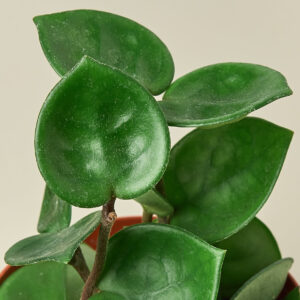
Origin: Southeast Asia
Common Name(s): Chelsea Wax Plant, Hoya Chelsea
About the Hoya Carnosa Chelsea
This cultivar features thick, dark green leaves that are often edged with creamy white or light yellow margins, adding a lovely contrast to the plant's overall appearance. In addition to its attractive foliage, this Hoya is prized for its clusters of fragrant flowers that bloom in tight, waxy umbels. It is ideal for hanging baskets, trellises, or as a trailing accent on shelves or window sills.
Light
Medium to Bright, indirect light: This plant prefers moderate to plenty of light to maintain its vegetation and grow flowers. Can tolerate lower light levels but their flowers may not grow. Avoid direct sunlight.
Water
Water once every 1-2 week: This plant requires watering only once every 1-2 weeks or when the top 1-2 inches of the soil is dry. This plant is drought-tolerant and prefers to dry out a bit between waterings.
Temperature & Humidity
Warm temperatures: This plant prefer temperatures between 65-85°F (18-29°C) with moderate to high humidity. Be mindful of sudden temperature changes and cold drafts.
How big will my plant grow?
This plant is generally a slow grower but can eventually reach a height of up to 20 feet with trellis and standing structure support.
Is this plant toxic for pets and kids?
No. While not toxic to humans or pets, it’s always best to keep plants out of reach of young children and animals.
🌿 Additional Care Tips:
- Avoid Disturbing the Roots: Hoya plants don't like their roots to be disturbed, so repot them only when necessary.
- Provide Support for growth: Provide a trellis or moss pole for this Hoya plant to climb on as it grows.
- Fertilize once a month: Feed this plant with a balanced liquid fertilizer diluted to half strength once a month during the growing season.
- Enjoy the Flowers: The fragrant flowers of Hoya Carnosa Chelsea are a beautiful sight and smell for any indoor space.

Origin: Southeast Asia
Common Name(s): Tricolor Hoya, Variegated Wax Plant
About the Hoya Carnosa Tricolor
The Hoya Carnosa 'Tricolor' is a stunning, variegated cultivar of the popular Hoya carnosa, known for its unique and eye-catching foliage that features a combination of green, cream, and pink tones. The "Tricolor" name refers to this tri-colored pattern, which gives the plant a beautiful, almost marbled appearance, making it a popular choice for plant collectors and enthusiasts. This is an ideal beginner -friendly choice for new plant lovers.
Light
Medium to Bright, indirect light: This plant prefers moderate to plenty of light to maintain its vibrant pink and green vegetation and grow flowers. Can tolerate lower light levels but their flowers may not grow. Avoid direct sunlight.
Water
Water once every 1-2 week: This plant requires watering only once every 1-2 weeks or when the top 1-2 inches of the soil is dry. This plant is drought-tolerant and prefers to dry out a bit between waterings.
Temperature & Humidity
Warm temperatures: This plant prefer temperatures between 65-85°F (18-29°C) with high humidity. Be mindful of sudden temperature changes and cold drafts.
How big will my plant grow?
This plant is generally a slow grower but can eventually reach a height of 6-10 feet with trellis and standing structure support.
Is this plant toxic for pets and kids?
No. While not toxic to humans or pets, it’s always best to keep plants out of reach of young children and animals.
🌿 Additional Care Tips:
- Avoid Disturbing the Roots: The Hoya Carnosa Tricolor does not like its roots to be disturbed, so repot it only when necessary.
- Provide Support for growth: Provide a trellis or moss pole for this Hoya plant to climb on as it grows.
- Fertilize once a month: Feed this Hoya with a balanced liquid fertilizer diluted to half strength once a month during the growing season.
- Enjoy the Flowers: The fragrant flowers of this "Tricolor" variety of Hoya are a beautiful sight and smell for any indoor space.

Origin: Madagascar
Common Name(s): Polka Dot Plant, Freckle Face
About the Hypoestes Polka Dot
The Polka Dot Plant, known for its vibrant pink, red, or white spotted leaves, is native to Madagascar and tropical regions of South Africa and Southeast Asia. This striking, compact plant adds a pop of color to shaded areas in homes or offices.
Light
Bright, indirect light: This plant loves plenty of light but avoid direct sunlight, as it can scorch the leaves. A north or east-facing window is ideal.
Water
Water weekly: Water 1-2 times per week to keep the soil moist, but not waterlogged. Check soil regularly, as the plant wilts if underwatered.
Temperature & Humidity
Warm temperatures: Hypoestes prefer temperatures between 65-75°F (18-24°C) with moderate-to-high humidity.
How big will my plant grow?
This plant is generally grows to reach a height of 12-inches.
Is this plant toxic for pets and kids?
No. While not considered highly toxic, the Polka Dot Plant can cause mild digestive discomfort if ingested by pets or humans.
🌿 Additional Care Tips:
- Prune regularly: To encourage bushier growth and prevent excessively long stems.
- Watch for pests: Mealybugs and spider mites can be a problem. Inspect your plant regularly and treat infestations promptly with insecticidal soap or neem oil.
- Fertilize regularly: Feed your Polka Dot plant with a balanced liquid fertilizer diluted to half strength every 2-4 weeks during the spring and summer.
- Repot with growth: Repot your Polka Dot plant every year or two in a slightly larger pot with fresh, well-draining potting mix.
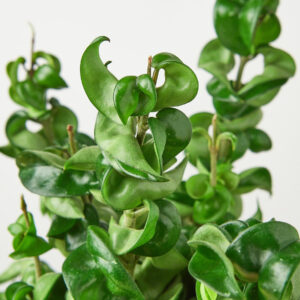
Origin: Southeast Asia and parts of India
Common Name(s): Hoya Rope Plant, Hindu Rope Plant, Curly Leaf Hoya
About the Hoya Rope Plant
Often referred to as the "Hindu Rope" plant due to the rope-like appearance, the Hoya Rope plant is intertwined with waxy leaves that add a fascinating texture and tropical vibe to any indoor space. It’s an easy-care, slow-growing vine that is ideal for hanging baskets, trellises, or as a trailing accent on shelves or window sills.
Light
Bright, indirect light: This plant prefers plenty of light to maintain its growth levels. Can tolerate lower light levels but their flowers may not grow. Avoid direct sunlight.
Water
Water once every 1-2 week: This plant requires watering only once every 1-2 weeks or when the top 1-2 inches of the soil is dry. This plant is drought-tolerant and prefers to dry out a bit between waterings.
Temperature & Humidity
Warm temperatures: This plant prefer temperatures between 65-85°F (18-29°C) with moderate to high humidity. Be mindful of sudden temperature changes and cold drafts.
How big will my plant grow?
This plant is generally a slow grower but can eventually reach a height of 4-6 feet (1.2-1.8 meters) in ideal conditions.
Is this plant toxic for pets and kids?
No. While not toxic to humans or pets, it’s always best to keep plants out of reach of young children and animals.
🌿 Additional Care Tips:
- Avoid Disturbing the Roots: Hoya plants don't like their roots to be disturbed, so repot them only when necessary.
- Provide Support for growth: Provide a trellis or moss pole for your Hoya Rope Plant to climb on as it grows.
- Fertilize once a month: Feed this Hoya with a balanced liquid fertilizer diluted to half strength once a month during the growing season.
- Enjoy the Flowers: The fragrant flowers of this Hoya Rope Plant plants are a beautiful sight and smell for any space.
- Avoid drafts: Avoid placing this plant near cold drafts or air conditioning vents.
J
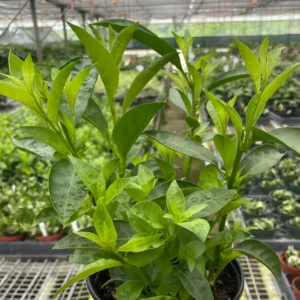
Origin: Caribbean & Central America
Common Name(s): Night-Blooming Jasmine, Queen of the Night, Lady of the Night
About the Jasmine Night
Known for its intoxicatingly sweet aroma, this plant releases its fragrance most strongly at night, especially in warm, humid conditions. Its delicate white-green tubular flowers bloom from spring through fall, and it can reach up to 10 feet outdoors but remains more compact when grown indoors.
Light
Full sun to partial shade: Ideally, provide at least 4-6 hours of direct sunlight daily. This plant thrives in full sun but can tolerate some shade, especially in hot climates.
Water
Water twice a week: Water 1-2 times per week, keeping the soil evenly moist but not soggy. During hot weather, increase watering frequency to prevent the soil from drying out.
Temperature & Humidity
Warm temperatures: Jasmine Night prefers warm temperatures, ideally between 65-75°F (18-24°C). Prefers high humidity, so occasional misting or a humidifier may be beneficial.
How big will my plant grow?
Indoors, this plant typically grows 3 to 6 feet (0.9 to 1.8 meters) tall, though it can be pruned to maintain a smaller size.
Is this plant toxic for pets and kids?
Yes. This plant is very toxic if ingested by pets or humans, potentially causing nausea and other digestive issues. The strong fragrance can also be irritating to some people, especially those with allergies.
🌿 Additional Care Tips:
- Fragrance: This plant emits a strong, sweet fragrance at night - freshening the room.
- Fertilizing: Use a balanced, diluted fertilizer every 4-6 weeks for maximum growth.
- Pest and disease: Watch for pests like aphids and mealybugs. Treat infestations promptly with insecticidal soap or neem oil.
- Pruning: Prune after flowering to control growth and encourage new blooms.
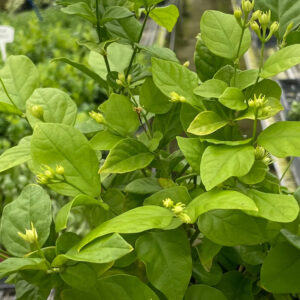
Origin: Southeast Asia
Common Name(s): Arabian Jasmine, Sambac Jasmine, Pikake
About the Jasmine Sambac
Jasmine Sambac is a highly fragrant, evergreen shrub native to South and Southeast Asia, valued for its delicate, white flowers that bloom year-round in the right conditions. Known for its intensely sweet fragrance, this jasmine variety is often used in perfumes, teas, and traditional garlands.
Light
Bright, indirect light: This plant thrives in bright, indirect light. It can tolerate some direct sunlight, but avoid intense afternoon sun, especially in hot climates.
Water
Water 2-3 times per week: Water 2-3 times per week, keeping the soil moist but not soggy. During winter, reduce watering slightly, letting the soil dry out a bit between waterings.
Temperature & Humidity
Warm temperatures: Prefers warm temperatures, ideally between 65-75°F (18-24°C), coupled with moderate-to-high humidity.
How big will my plant grow?
Indoors, this plant typically grows 1 to 3 feet tall, though it can be pruned to maintain a smaller size.
Is this plant toxic for pets and kids?
No. While its generally considered non-toxic, it’s still best to keep it out of reach of pets and children who might be prone to nibbling on houseplants.
🌿 Additional Care Tips:
- Fragrance: Known for its strong, sweet fragrance, particularly in the evening, which can fill a room or outdoor space. Ideally, place in a room that benefits from the fragrance.
- Fertilizer: Use a a balanced fertilizer monthly to support blooms. With growth, you can train your Jasmine Sambac to climb a trellis or grow as a bush.
- Container Care: If growing indoors or in a container, repot every 1-2 years to refresh soil and avoid root binding.
- Pest and disease: Watch for pests like aphids and mealybugs. If infested, apply insecticidal soap or neem oil as need to restore your plant to full health.
L
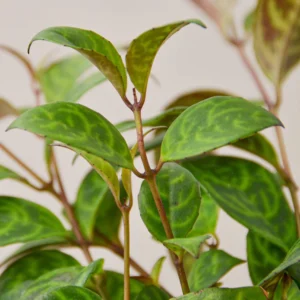
Origin: Southeast Asia
Common Name(s): Black Pagoda Lipstick Plant
About the Lipstick Black Pagoda
The Black Pagoda Lipstick Plant is a striking variety of the Lipstick Plant known for its unique dark green, paddle-shaped leaves that have a subtle reddish tint and distinctive cream or yellow edges. This stunning plant is native to tropical regions and is an excellent choice for hanging baskets or elevated displays where its trailing vines can showcase their beauty.
Light
Bright, indirect light: This plant thrives in bright, indirect light. Too much direct sun can scorch the leaves. Too little light can reduce flowering.
Water
Water once a week: Be cautious not to overwater, as this can lead to root rot. Adjust frequency to every 1.5-2 weeks in winter months when growth slows.
Temperature & Humidity
Warm temperatures: Lipstick plants prefer warm temperatures, ideally between 65-75°F (18-24°C) with high humidity. Mist plant to improve humidity.
How big will my plant grow?
Indoors, this plant typically grows 12-24 inches tall. It is ideal for small spaces and hanging baskets.
Is this plant toxic for pets and kids?
No. The Black Pagoda Lipstick Plant is considered non-toxic to pets, making it a safe choice for households with animals.
🌿 Additional Care Tips:
- Unique Foliage: This variety produces tubular, vibrant flowers that can attract pollinators like hummingbirds. The Black Pagoda variety is known for its dark, almost black foliage, providing a striking contrast to the bright red flowers.
- Fertilizing: Use a balanced, diluted liquid fertilizer every 4-6 weeks during the growing season (spring and summer) for optimal growth.
- Pruning: Regularly pinch back stems to encourage bushier growth and remove any dead or damaged leaves.
- Pest Watch: Keep an eye out for common pests like aphids and spider mites; neem oil or insecticidal soap can be effective treatments if needed.
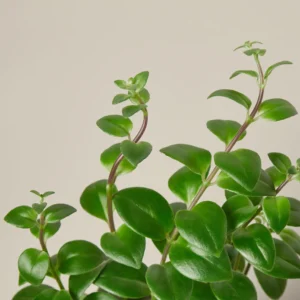
Origin: Southeast Asia
Common Name(s): Lipstick Plant, Basket Plant
About the Lipstick Plant
The Lipstick Plant, known for its striking tubular flowers that resemble lipstick tubes, is a popular houseplant native. This trailing plant is an excellent choice for hanging baskets or high shelves where its vibrant, red flowers can dangle gracefully. The plant features glossy, dark green leaves that provide a beautiful contrast to its colorful blooms.
Light
Bright, indirect light: This plant thrives in bright, indirect light. Too much direct sun can scorch the leaves. Too little light can reduce flowering.
Water
Water once a week: Be cautious not to overwater, as this can lead to root rot. Adjust frequency to every 1.5-2 weeks in winter months when growth slows.
Temperature & Humidity
Warm temperatures: Lipstick plants prefer warm temperatures, ideally between 65-75°F (18-24°C) with high humidity. Mist plant to improve humidity.
How big will my plant grow?
Indoors, this plant typically grows 12-24 inches tall. It is ideal for small spaces and hanging baskets.
Is this plant toxic for pets and kids?
No. The Lipstick Plant is considered non-toxic to pets, making it a safe choice for households with animals.
🌿 Additional Care Tips:
- Unique blooms: The plant produces tubular flowers, often red or orange, which can attract hummingbirds and other pollinators.
- Pruning: Prune after flowering to maintain shape and encourage new growth.
- Fertilizing: Feed with a balanced liquid fertilizer every 4-6 weeks in spring and summer.
- Pests and diseases: Infestations are rare, but if it occurs - treat infestations promptly with insecticidal soap or neem oil.
M
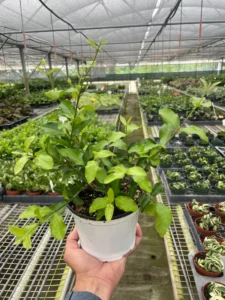
Origin: Caribbean & Central America
Common Name(s): Barbados Cherry, Acerola Cherry, West Indian Cherry
About the Malpighia Barbados Cherry
The Barbados Cherry, also known as Acerola Cherry, is a small evergreen shrub native to the Caribbean and Central America. Known for its bright, red, cherry-like fruits, this plant is not only ornamental but also prized for its high vitamin C content. It can produce edible fruits year-round, especially in warm, tropical climates. The plant is valued both for its beauty and its health benefits, as the cherries are often used in juices, supplements, and other natural products.
Light
Bright, direct sunlight: This tropical fruit tree thrives in full sunlight. It can tolerate partial shade but may produce fewer cherries and have slower growth in lower light conditions.
Water
Water regularly: Typically about 2-3 times per week, keeping the soil evenly moist. Once established, they can tolerate some drought, but regular watering during dry periods is recommended.
Temperature & Humidity
Warm temperatures: This tropical plant prefers warm temperatures, ideally between 65-85°F (18-30°C). It is not frost-tolerant.
How big will my plant grow?
Indoors, this plant typically grows 3-6 feet tall.
Is this plant toxic for pets and kids?
No. The Black Pagoda Lipstick Plant is considered non-toxic to pets, making it a safe choice for households with animals.
🌿 Additional Care Tips:
- Fruit Production: Barbados Cherry produces small, bright red fruits that are rich in vitamin C. Fruit production is best with plenty of sunlight.
- Pruning: Prune regularly to maintain shape and encourage fruit production.
- Cold sensitivity: Protect your Barbados cherry from frost. In colder climates, it may need to be grown in a container and brought indoors during winter.
- Best for outdoors: This tropical fruiting tree is best grown in the outdoors after they surpass 24 inches in height. It can be grown indoors, but in ideal settings with adequate sunlight and space.
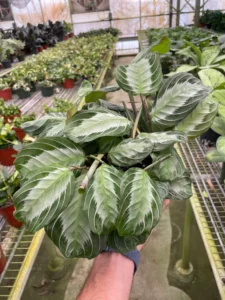
Origin: Brazil
Common Name(s): Silver Band Prayer Plant
About the Maranta Silver Band
The Maranta ‘Silver Band’ is a unique and elegant variety of the Prayer Plant, known for its deep green leaves accented by a striking silver stripe down the center. This beautiful contrast gives the plant a sophisticated look, adding a touch of refinement to any indoor space. This variety also displays the classic “prayer” movement, folding its leaves up at night and reopening during the day.
Light
Bright, indirect light: This plant thrive in bright, indirect light. Avoid direct sunlight, as it can scorch the leaves. Low light is tolerated but may reduce the vibrancy of the leaves.
Water
Regular watering: Keep the soil consistently moist, but avoid overwatering. Water once a week. Allow the top soil to dry out slightly between watering; be cautious not to let the plant sit in water.
Temperature & Humidity
Warm temperatures: Maranta plants prefer warm temperatures, ideally between 65-75°F (18-24°C) with high humidity. Avoid cold drafts.
How big will my plant grow?
Indoors, this plant typically grows 10-12 inches tall, making it an ideal choice for tabletops, shelves, or hanging planters.
Is this plant toxic for pets and kids?
No. The Silver Band Prayer Plant is non-toxic to pets, making it a pet-friendly choice for households with animals.
🌿 Additional Care Tips:
- Prayer plant movement: Maranta plants are known for their unique nighttime behavior. As the sun sets, their leaves fold up, resembling hands in prayer.
- Soil preference: Use a well-draining potting mix that retains moisture.
- Leaf Handling: For all Maranta varieties, the leaves are beautiful, but be cautious when handling the plant. The leaves are delicate and can easily bruise or tear.
- Fertilize & avoid pests: Feed your Maranta plant with a balanced liquid fertilizer diluted to half strength every 4-6 weeks and treat with neem oil to prevent infestation by pests, such as spider mites and mealybugs.
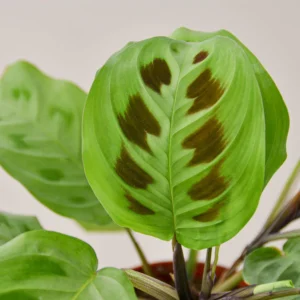
Origin: Brazil
Common Name(s): Prayer Plant, Herringbone Plant
About the Maranta Leuconeura
The Maranta leuconeura, commonly known as the Prayer Plant, is beloved for its lush, oval-shaped leaves with intricate patterns of green, dark red, and sometimes hints of purple. The Prayer Plant is named for its unique leaf movement—its leaves fold up at night as if in prayer and reopen during the day.
Light
Bright, indirect light: This plant thrive in bright, indirect light. Avoid direct sunlight, as it can scorch the leaves. Low light is tolerated but may reduce the vibrancy of the leaves.
Water
Regular watering: Keep the soil consistently moist, but avoid overwatering. Water once a week. Allow the top soil to dry out slightly between watering; be cautious not to let the plant sit in water.
Temperature & Humidity
Warm temperatures: Maranta plants prefer warm temperatures, ideally between 65-75°F (18-24°C) with high humidity. Avoid cold drafts.
How big will my plant grow?
This plant typically grows 10-12 inches tall, making it an ideal choice small spaces.
Is this plant toxic for pets and kids?
No. This prayer plant is non-toxic to pets, making it a pet-friendly choice for households with animals.
🌿 Additional Care Tips:
- Prayer plant movement: Maranta plants are known for their unique nighttime behavior. As the sun sets, their leaves fold up, resembling hands in prayer.
- Soil preference: Use a well-draining potting mix that retains moisture.
- Leaf Handling: For all Maranta varieties, the leaves are beautiful, but be cautious when handling the plant. The leaves are delicate and can easily bruise or tear.
- Fertilize & avoid pests: Feed your Maranta plant with a balanced liquid fertilizer diluted to half strength every 4-6 weeks and treat with neem oil to prevent infestation by pests, such as spider mites and mealybugs.
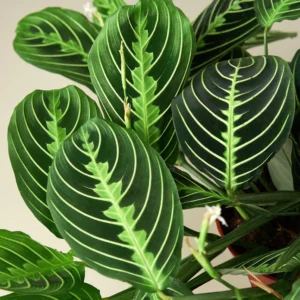
Origin: Brazil
Common Name(s): Lemon Lime Prayer Plant
About the Maranta Lemon Lime
The Lemon Lime Prayer Plant is a vibrant variety of Maranta, loved for its bright green leaves adorned with lime green and darker green stripes that create a striking contrast. Its eye-catching foliage adds a fresh pop of color to any room, and like other prayer plants, its leaves fold up at night in a "prayer" motion.
Light
Bright, indirect light: This plant thrive in bright, indirect light. Avoid direct sunlight, as it can scorch the leaves. Low light is tolerated but may reduce the vibrancy of the leaves.
Water
Regular watering: Keep the soil consistently moist, but avoid overwatering. Water once a week. Allow the top soil to dry out slightly between watering; be cautious not to let the plant sit in water.
Temperature & Humidity
Warm temperatures: Maranta plants prefer warm temperatures, ideally between 65-75°F (18-24°C) with high humidity. Avoid cold drafts.
How big will my plant grow?
This plant typically grows 10-12 inches tall, making it an ideal for small spaces, tabletops, or shelves.
Is this plant toxic for pets and kids?
No. This prayer plant is non-toxic to pets, making it a pet-friendly choice for households with animals.
🌿 Additional Care Tips:
- Prayer plant movement: Maranta plants are known for their unique nighttime behavior. As the sun sets, their leaves fold up, resembling hands in prayer.
- Soil preference: Use a well-draining potting mix that retains moisture.
- Pruning: Prune away any dead or yellowing leaves to encourage new growth and maintain appearance.
- Fertilize & avoid pests: Feed your Maranta plant with a balanced liquid fertilizer diluted to half strength every 4-6 weeks and treat with neem oil to prevent infestation by pests, such as spider mites and mealybugs.
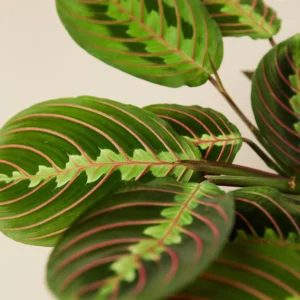
Origin: Brazil
Common Name(s): Red Prayer Plant, Red Maranta
About the Maranta Red Prayer
The Red Prayer Plant, also known as the Red Maranta, is a striking, low-growing perennial native to the tropical rainforests of Brazil. This plant is celebrated for its stunning foliage, featuring deep green leaves with bold red veins that create an eye-catching pattern. This plant is an excellent choice for tabletops, terrariums, or as part of a vibrant indoor plant collection.
Light
Bright, indirect light: Maranta Red Prayer plants thrive in bright, indirect light. Avoid direct sunlight, as it can scorch the leaves. Low light is tolerated but may reduce the vibrancy of the leaves.
Water
Regular watering: Keep the soil consistently moist, but avoid overwatering. Water once a week. Allow the top soil to dry out slightly between watering; be cautious not to let the plant sit in water.
Temperature & Humidity
Warm temperatures: Maranta plants prefer warm temperatures, ideally between 65-75°F (18-24°C) with high humidity. Avoid cold drafts.
How big will my plant grow?
This plant typically grows 10-12 inches tall, making it an ideal for small spaces, terrariums, tabletops, or shelves.
Is this plant toxic for pets and kids?
No. This prayer plant is non-toxic to pets, making it a pet-friendly choice for households with animals.
🌿 Additional Care Tips:
- Prayer plant movement: Maranta plants are known for their unique nighttime behavior. As the sun sets, their leaves fold up, resembling hands in prayer.
- Soil preference: Use a well-draining potting mix that retains moisture.
- Pruning: Prune away any dead or yellowing leaves to encourage new growth and maintain appearance.
- Fertilize & avoid pests: Feed your Maranta plant with a balanced liquid fertilizer diluted to half strength every 4-6 weeks and treat with neem oil to prevent infestation by pests, such as spider mites and mealybugs.
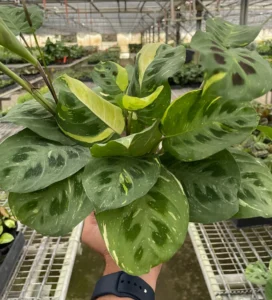
Origin: Brazil
Common Name(s): Variegated Prayer Plant, Beauty Kim Maranta
About the Maranta Variegated Beauty Kim
The Variegated Prayer Plant ‘Beauty Kim’ is a rare and stunning variety of Maranta known for its beautifully variegated leaves with shades of green, cream, and sometimes subtle pink hues. The leaves of the Beauty Kim fold up at night in a unique “prayer” movement, a characteristic feature of all prayer plants.
Light
Bright, indirect light: This plant thrive in bright, indirect light. Avoid direct sunlight, as it can scorch the leaves. Low light is tolerated but may reduce the vibrancy of the leaves.
Water
Regular watering: Keep the soil consistently moist, but avoid overwatering. Water once a week. Allow the top soil to dry out slightly between watering; be cautious not to let the plant sit in water.
Temperature & Humidity
Warm temperatures: Maranta plants prefer warm temperatures, ideally between 65-75°F (18-24°C) with high humidity. Avoid cold drafts.
How big will my plant grow?
This plant typically grows 10-12 inches tall, making it an ideal choice small spaces.
Is this plant toxic for pets and kids?
No. This prayer plant is non-toxic to pets, making it a pet-friendly choice for households with animals.
🌿 Additional Care Tips:
- Prayer plant movement: Maranta plants are known for their unique nighttime behavior. As the sun sets, their leaves fold up, resembling hands in prayer.
- Soil preference: Use a well-draining potting mix that retains moisture.
- Variegation Maintenance: Consistent bright, indirect light helps maintain the variegation on the leaves. Prune away any dead or yellowing leaves to encourage new growth and maintain appearance.
- Fertilize & avoid pests: Feed your Maranta plant with a balanced liquid fertilizer diluted to half strength every 4-6 weeks and treat with neem oil to prevent infestation by pests, such as spider mites and mealybugs.
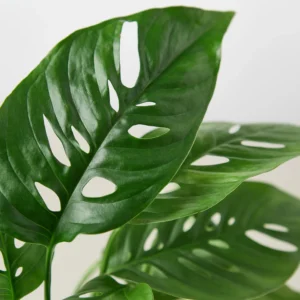
Origin: Central America
Common Name(s): Swiss Cheese Plant, Monkey Mask Monstera
About the Monstera Adansonii Swiss Cheese
The Monstera adansonii is known for its distinctive, fenestrated leaves with oval-shaped holes. This vining plant is highly popular as a houseplant due to its unique leaf pattern and ease of care. Typically, it grows well in hanging baskets or as a climbing plant on a moss pole, adding a tropical feel to any space. It is known to help improve indoor air quality by filtering out common toxins, such as formaldehyde, benzene, and trichloroethylene.
Light
Bright, indirect light: Thrives in bright, indirect light for 6-8 hours daily. Too little light can cause the plant to grow slowly and produce smaller leaves with fewer holes (fenestrations).
Water
Water weekly: Allow the top soil to dry before watering again. In winter, reduce watering to every 10-14 days as growth slows and the plant requires less moisture.
Temperature & Humidity
Warm temperatures: Performs best in temperatures between 65-80°F (18-27°C). Avoid temperatures below 55°F (13°C), as the plant is sensitive to cold and can develop leaf damage.
How big will my plant grow?
This plant typically grows between 3 to 6 feet (1 to 2 meters) in height. It can grow up to 10 feet especially when it has something to climb on, such as a moss pole, trellis, or large structure.
Is this plant toxic for pets and kids?
Yes. The Monstera adansonii is mildly toxic if ingested due to calcium oxalate crystals, which can cause irritation. Keep this plant out of reach of pets and children to ensure safety.
🌿 Additional Care Tips:
- Support and Growth Pattern: As a climbing plant, it benefits from a moss pole or trellis, which will allow the plant to produce larger leaves with more pronounced fenestrations.
- Fertilizing Details: Use a balanced, diluted liquid fertilizer every 4-6 weeks in spring and summer. Avoid fertilizing in winter when growth slows. Too much fertilizer can lead to salt buildup, so flush the soil every few months.
- Pruning Techniques: Trim any yellow, damaged, or overly long vines to encourage a bushier shape. Clean pruning shears with rubbing alcohol before and after pruning to prevent disease spread.
- Pest Management: Regularly inspect for pests like spider mites, scale, and mealybugs, which are attracted to the large leaves. Wipe the leaves with a damp cloth once a month and treat any infestations with neem oil or insecticidal soap. Spider mites, in particular, thrive in dry environments, so keeping humidity high can prevent them.
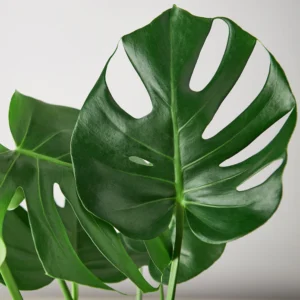
Origin: South America
Common Name(s): Split-Leaf Philodendron, Swiss Cheese Plant
About the Monstera Deliciosa
The Monstera Deliciosa is a tropical plant known for its large, deeply lobed leaves that give it an exotic, sculptural look. This plant can grow impressively large indoors when given adequate space. This plant is also known for its strong and significant air purifying qualities such as removing toxins from the air, producing oxygen, and regulating indoor humidity levels. This plant contributes to a fresher indoor atmosphere.
Light
Bright, indirect light: This plant thrives in bright, indirect light. Avoid direct sunlight, especially during intense midday hours.
Water
Water every 1-2 weeks: Let the top 2 inches of soil dry out before watering again. In winter, reduce watering frequency as the plant's growth rate slows.
Temperature & Humidity
Warm temperatures: Thrives in temperatures between 65-85°F (18-29°C), but try to keep it above 60°F (16°C) for optimal growth.
How big will my plant grow?
It typically grows up to 2-3 feet and spreads as a groundcover or climbing vine, making it perfect for hanging baskets or as a floor plant.
Is this plant toxic for pets and kids?
Yes. This Philodendron variety is toxic to pets (cats and dogs) if ingested, so it’s important to keep it out of reach of curious animals. Keep away from small children to prevent accidental ingestion.
🌿 Additional Care Tips:
- Support and Growth Pattern: As a climbing plant, it benefits from a moss pole or trellis, which will allow the plant to produce larger leaves with more pronounced fenestrations.
- Fertilizing Details: Use a balanced, diluted liquid fertilizer every 4-6 weeks in spring and summer. Avoid fertilizing in winter when growth slows. Too much fertilizer can lead to salt buildup, so flush the soil every few months.
- Pruning Techniques: Trim any yellow, damaged, or overly long vines to encourage a bushier shape. Clean pruning shears with rubbing alcohol before and after pruning to prevent disease spread.
- Pest Management: Regularly inspect for pests like spider mites, scale, and mealybugs, which are attracted to the large leaves. Wipe the leaves with a damp cloth once a month and treat any infestations with neem oil or insecticidal soap. Spider mites, in particular, thrive in dry environments, so keeping humidity high can prevent them.
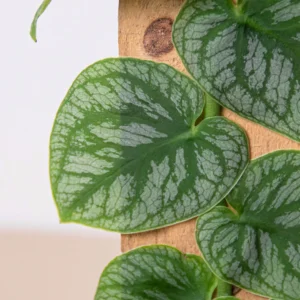
Origin: Central & South America
Common Name(s): Shingle Plant, Monstera Dubia
About the Monstera Dubia Shingle Plant
The Monstera dubia, commonly known as the Shingle Plant, is a unique and rare species of Monstera that grows in a distinctive shingling pattern, with each leaf lying flat against its climbing surface. Native to Central and South America, this plant’s juvenile leaves are small and heart-shaped, but as it matures, it may develop the iconic Monstera fenestrations (splits) if provided with the right conditions. Monstera dubia grows as a compact vine, making it an intriguing choice for moss poles or other vertical supports.
Light
Bright, indirect light: This plant thrives in bright, indirect light. Avoid direct sunlight, especially during intense midday hours.
Water
Water weekly: Water 1-2 times per week to keep the soil moist. Reduce watering in winter when growth slows.
Temperature & Humidity
Warm temperatures: Monstera dubia prefers temperatures between 65-75°F (18-24°C) with moderate-to-high humidity.
How big will my plant grow?
This plant typically grows between 3 to 6 feet (1 to 2 meters) in height, depending on how it is trained.
Is this plant toxic for pets and kids?
Yes. The Monstera Dubia is considered mildly toxic to pets and humans due to calcium oxalate crystals, which can cause irritation if ingested. Keep this plant out of reach of pets and small children.
🌿 Additional Care Tips:
- Climbing or trailing: Monstera dubia is a vining plant that can be trained to climb a moss pole or allowed to trail.
- Slow growth: This plant is a slow grower, so be patient.
- Unique leaf shape: The plant starts with small, heart-shaped leaves and gradually develops larger, fenestrated leaves as it matures.
- Pruning: Trim any damaged or overly long vines to maintain the plant’s shape and prevent legginess.
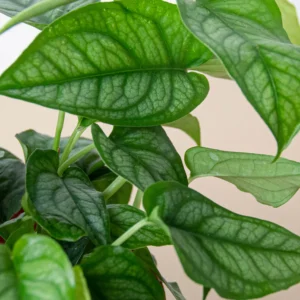
Origin: Central America
Common Name(s): Silver Monstera, Silver Leaf Philodendron
About the Monstera Siltepecana
The Monstera siltepecana is a uniquely and elegantly for its silvery-blue leaves with dark green veining, creating a striking contrast. This plant is a vining species that climbs as it matures, eventually developing fenestrations (splits) in its leaves under the right conditions. In its juvenile phase, the leaves remain small and heart-shaped, making it a beautiful trailing plant or an attractive climber when given a moss pole. It is known to help improve indoor air quality by filtering out common toxins, such as formaldehyde, benzene, and trichloroethylene.
Light
Bright, indirect light: This plant thrives in bright, indirect light. Avoid direct sunlight, especially during intense midday hours.
Water
Water once a week: allowing the top inch of soil to dry out between waterings. Allow the top inch of soil to dry out slightly between waterings. Avoid overwatering, as this can lead to root rot.
Temperature & Humidity
Warm temperatures: Thrives in temperatures between 65-80°F (18-27°C). Prefers high humidity; mist regularly or use a humidifier to keep leaves healthy, especially in dry indoor condition.
How big will my plant grow?
This plant typically grows between 3 to 6 feet (1 to 2 meters) in height. It can grow up to 10 feet especially when it has something to climb on, such as a moss pole, trellis, or large structure.
Is this plant toxic for pets and kids?
Yes. The Monstera siltepecana is mildly toxic if ingested due to calcium oxalate crystals, which can cause irritation. Keep this plant out of reach of pets and children to ensure safety.
🌿 Additional Care Tips:
- Climbing and Growth Patterns: Provide a moss pole or other support to encourage upward growth. In its juvenile stage, the leaves are small and without fenestrations, but as it climbs, the plant will develop larger, more mature leaves with splits.
- Fertilizing: Feed every 4-6 weeks with a half-strength, balanced liquid fertilizer during spring and summer. Avoid fertilizing in winter, as the plant’s growth slows naturally.
- Pruning for Shape: Regularly trim leggy stems to encourage bushier growth and maintain a compact shape. Remove yellow or damaged leaves to keep the plant looking tidy.
- Pest Management: Spider mites, mealybugs, and scale insects can sometimes appear. Wipe the leaves down with a damp cloth regularly, and treat with insecticidal soap or neem oil at the first sign of pests. High humidity helps deter spider mites, which prefer dry conditions.
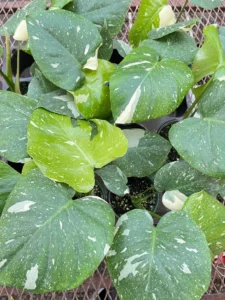
Origin: Central & South America
Common Name(s): Thai Constellation Monstera
About the Monstera Thai Constellation
The Monstera Thai Constellation is a stunning, variegated variety of the popular Monstera deliciosa, renowned for its striking white and cream marbling across its large, glossy green leaves. It grows as a climbing vine, producing fenestrated (split) leaves as it matures, and can reach several feet in height when supported by a trellis or moss pole. It is known to help improve indoor air quality by filtering out common toxins, such as formaldehyde, benzene, and trichloroethylene due to its air purifying nature.
Light
Bright, indirect light: Prefers bright, indirect light to maintain its stunning variegation. Avoid direct sunlight to prevent leaf burns. Low light may slow growth and the reduce variegation of leaves.
Water
Water 1-2 times a week: Be careful not to overwater, as the Monstera Thai Constellation is prone to root rot; ensure the pot has good drainage.
Temperature & Humidity
Warm temperatures: Monstera Thai Constellation prefers warm temperatures, ideally between 65-75°F (18-24°C) with moderate-to-high humidity. Mist during dry periods.
How big will my plant grow?
This plant typically grows between 3 to 6 feet (1 to 2 meters) in height, depending on how it is trained and if it has something to climb on.
Is this plant toxic for pets and kids?
Yes. The Monstera Thai Constellation is mildly toxic to pets and humans if ingested, causing irritation and discomfort. Keep this plant out of reach of pets and small children to ensure safety.
🌿 Additional Care Tips:
- Climbing or trailing: Monstera Thai Constellation is a vining plant that can be trained to climb a moss pole or allowed to trail.
- Slow growth: This plant is a slow grower, so be patient.
- Variegation Maintenance: The plant’s white or cream marbling requires sufficient light for vibrant color; avoid low light.
- Pruning & Infestation Control: Trim any damaged or unruly vines to maintain shape and encourage healthy new growth. For pest infestations, treat with neem oil or insecticidal soap as needed.
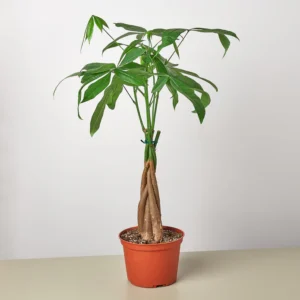
Origin: South America
Common Name(s): Money Tree, Guiana Chestnut, Pachira Braid
About the Braided Money Tree Pachira aquatica
The Braided Money Tree (Pachira aquatica) is a popular and striking tropical plant known for its unique braided trunk and lush, glossy leaves. Native to the swamps and rainforests of Central and South America, this plant is celebrated for its symbolic association with good fortune, wealth, and prosperity. It is also prized for its low-maintenance nature, making it a perfect choice for beginners. The Money Tree is known to help purify indoor air, remove toxins, and improve humidity levels, contributing to a fresher and healthier environment.
Light
Bright, indirect light: The Money Tree thrives in bright, indirect light but can adapt to lower light levels. Avoid direct sunlight as it can scorch the leaves.
Water
Water every 7-10 days: Allow the top 1-2 inches of soil to dry out between waterings. In winter, reduce watering frequency to every 2-3 weeks as the plant enters a dormant phase and its growth slows.
Temperature & Humidity
Warm temperatures: This plant thrives in temperatures between 65-75°F (18-24°C). Keep it in a space with stable warmth, and avoid placing it near drafts, heaters, or air conditioners. Moderate humidity is best; if the air is too dry, mist occasionally or use a humidity tray to prevent leaf tips from drying out.
How big will my plant grow?
Indoors, the Money Tree can grow to 6-8 feet tall, though it can be kept smaller with pruning. The braided trunk adds a distinctive, sculptural element, while the large, glossy leaves spread out in a bushy formation, making it a beautiful floor or tabletop plant.
Is this plant toxic for pets and kids?
No. The Money Tree is non-toxic to both pets and humans, making it a safe addition to homes with children and animals.
🌿 Additional Care Tips:
Support and Growth Pattern: The Money Tree has a slow to moderate growth rate. The braided trunk, formed by intertwining multiple stems, is an attractive feature that requires no additional support, but the plant may need occasional pruning to keep it tidy.
Fertilizing Details: Use a balanced liquid fertilizer diluted to half strength every 4-6 weeks during the growing season (spring and summer). Avoid fertilizing in winter when growth naturally slows, and be cautious not to over-fertilize, as this can harm the plant.
Pruning Techniques: Prune any yellow or damaged leaves to maintain a clean and healthy appearance. Trim back any leggy growth to encourage a fuller shape. Clean pruning shears with rubbing alcohol before and after each use to prevent the spread of disease.
Pest Management: While the Money Tree is relatively pest-resistant, it can sometimes attract aphids, spider mites, or mealybugs. Regularly inspect the plant, especially on the undersides of leaves, and wipe them clean with a damp cloth. If pests are found, treat with neem oil or insecticidal soap.
N

Origin: Brazil
Common Name(s): Black Goldfish Plant, Goldfish Plant
About the Nematanthus Black Goldfish
The Black Goldfish Plant is a unique, trailing tropical plant named for its tubular, dark orange-red flowers that resemble tiny goldfish. Native to Brazil, this plant features glossy, dark green leaves and typically grows well in hanging baskets or pots where its vines can cascade. When in bloom, the vibrant flowers provide a stunning contrast to its dark foliage, making it an eye-catching choice for indoor displays. The Black Goldfish Plant can help improve indoor air quality by absorbing carbon dioxide and releasing oxygen, contributing to a fresher environment.
Light
Bright, indirect light: Prefers bright, indirect light to promote blooming and keep the leaves vibrant. Place near an east or west-facing window for ideal lighting conditions.
Water
Water regularly: Water every 7-10 days, allowing the top soil to dry. Ensure the soil is moist but not soggy. In winter, reduce watering to every 2-3 weeks as the plant’s growth slows and its water needs decrease.
Temperature & Humidity
Warm temperatures: Thrives in temperatures between 65-75°F (18-24°C). Avoid temperatures below 60°F (16°C) as it may cause stress or slow growth with mid-to-high humidity.
How big will my plant grow?
It typically grows to a height of about 6 to 12 inches (15–30 cm) when it is allowed to grow in a bushy form or mounded shape. If grown in a hanging basket or allowed to trail, it can spread and cascade down to a length of about 18 to 24 inches (45–60 cm).
Is this plant toxic for pets and kids?
No. This plant is considered non-toxic to pets, making it a safe choice for households with animals.
🌿 Additional Care Tips:
- Fertilizing Needs: Feed monthly during spring and summer with a balanced, diluted liquid fertilizer to encourage blooms. Reduce fertilizing in fall and stop altogether in winter.
- Pruning Tips: Prune lightly after flowering to maintain shape and encourage bushier growth. Use sterilized scissors to remove leggy or damaged stems.
- Repotting Frequency: Repot every 2-3 years, preferably in spring, using a well-draining potting mix.
- Pest Management: Monitor for pests like aphids and spider mites, which are attracted to the flowers. Treat infestations with neem oil or insecticidal soap if needed.
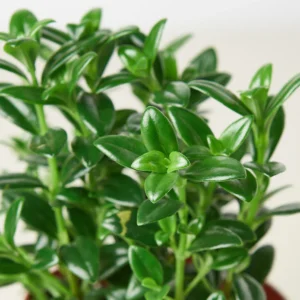
Origin: Brazil
Common Name(s): Black Goldfish Plant, Goldfish Plant
About the Nematanthus Brazilian Firecracker
The Brazilian Firecracker Plant is a striking tropical plant known for its vibrant, tubular orange-red flowers that resemble small firecrackers, giving it its fiery name. This trailing plant features glossy, dark green leaves that provide a beautiful backdrop for its brilliant flowers, which bloom in clusters. Its trailing vines make it an ideal choice for hanging baskets or containers, where the plant can cascade down or climb with support. Like many house plants, this plant can help improve indoor air quality by absorbing carbon dioxide and releasing oxygen, contributing to a fresher environment.
Light
Bright, indirect light: Prefers bright, indirect light to promote blooming and keep the leaves vibrant. Place near an east or west-facing window for ideal lighting conditions.
Water
Water regularly: Water every 7-10 days, allowing the top soil to dry. Ensure the soil is moist but not soggy. In winter, reduce watering to every 2-3 weeks as the plant’s growth slows and its water needs decrease.
Temperature & Humidity
Warm temperatures: Thrives in temperatures between 65-75°F (18-24°C). Avoid temperatures below 60°F (16°C) as it may cause stress or slow growth with mid-to-high humidity.
How big will my plant grow?
It typically grows to a height of about 6 to 12 inches (15–30 cm) when it is allowed to grow in a bushy form or mounded shape. If grown in a hanging basket or allowed to trail, it can spread and cascade down to a length of about 18 to 24 inches (45–60 cm).
Is this plant toxic for pets and kids?
No. This plant is considered non-toxic to pets, making it a safe choice for households with animals.
🌿 Additional Care Tips:
- Fertilizing Needs: Feed monthly during spring and summer with a balanced, diluted liquid fertilizer to encourage blooms. Reduce fertilizing in fall and stop altogether in winter.
- Pruning Tips: Prune lightly after flowering to maintain shape and encourage bushier growth. Use sterilized scissors to remove leggy or damaged stems.
- Repotting Frequency: Repot every 2-3 years, preferably in spring, using a well-draining potting mix.
- Pest Management: Monitor for pests like aphids and spider mites, which are attracted to the flowers. Treat infestations with neem oil or insecticidal soap if needed.
P
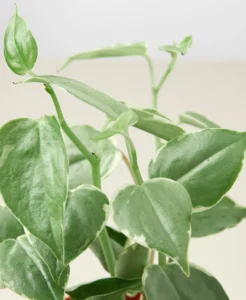
Origin: South America
Common Name(s): Cupid Peperomia
About the Peperomia Cupid
The Peperomia Cupid is a charming and compact houseplant known for its unique, heart-shaped leaves that have a soft, velvety texture. The leaves are typically a vibrant green, sometimes with hints of red or pink at the edges, adding to its attractive appearance. This variety is compact and very easy to care for. While it does not have significant air purifying qualities, it can help improve air quality by absorbing carbon dioxide and releasing oxygen, contributing to a fresher indoor atmosphere.
Light
Bright, indirect light: Prefers bright, indirect light. Avoid direct sunlight, as it can cause leaf discoloration and scorch the leaves.
Water
Water weekly: Allow the soil to dry out completely between waterings. Overwatering is a common cause of root rot in peperomias.
Temperature & Humidity
Warm temperatures: Thrives in temperatures between 65-75°F (18-24°C) and high humidity, but can adapt to average indoor humidity. Mist during dry winter months.
How big will my plant grow?
It typically grows up to 6-8 inches (15-20 cm), perfect for hanging baskets or as a cascading accent in containers or on shelves.
Is this plant toxic for pets and kids?
No. The Peperomia Cupid is non-toxic to pets, making it a pet-friendly option for households with animals.
🌿 Additional Care Tips:
- Fertilize sparingly: Feed your Peperomia Cupid with a diluted, balanced liquid fertilizer once or twice a year during the spring and summer seasons. Too much fertilizer can burn the roots.
- Repot carefully: Repot your Peperomia Cupid only when it becomes root-bound. Use a well-draining potting mix.
- Avoid overwatering: Overwatering is the most common cause of death for peperomias. Allow the soil to dry out completely before watering again.
- Protect from cold drafts & pests: Peperomias are sensitive to cold drafts. Place them away from drafty windows and doors. Additionally, keep an eye out for common houseplant pests like mealybugs and spider mites. Treat infestations promptly with insecticidal soap or neem oil.
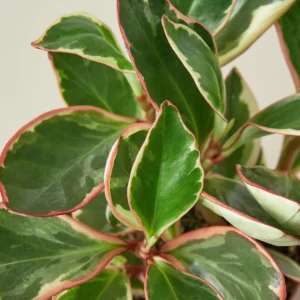
Origin: Brazil
Common Name(s): Peperomia Ginny, Rainbow Peperomia, Tricolor Peperomia
About the Peperomia Ginny
Peperomia Ginny is a beautiful and colorful variety of Peperomia, known for its oval-shaped leaves edged in shades of pink, cream, and green. With its vibrant foliage and easy-care nature, Peperomia Ginny adds a touch of charm to desks, shelves, and tabletops. While this Peperomia is not a heavy air purifier, it can help improve indoor air quality by absorbing carbon dioxide and releasing oxygen, contributing to a fresher atmosphere.
Light
Bright, indirect light: Ginny peperomia thrives in bright, indirect light. Avoid direct sunlight, as it can scorch the leaves.
Water
Water weekly: Water when the top 1 inch of soil feels dry. Typically, water every 7-10 days, but reduce in winter. Ensure the pot has drainage to avoid waterlogging.
Temperature & Humidity
Warm temperatures: Thrives in temperatures between 65-75°F (18-24°C). Prefers humidity levels around 50-60%. Increase humidity if needed with a humidifier or occasional misting.
How big will my plant grow?
It typically grows to a height of about 6 to 12 inches (15–30 cm), making it ideal for small spaces and tabletops.
Is this plant toxic for pets and kids?
No. The Peperomia Ginny is non-toxic to pets, making it a pet-friendly option for households with animals. As always, it’s best to monitor pets to prevent any accidental nibbling, but this plant is generally safe around cats and dogs.
🌿 Additional Care Tips:
- Fertilize sparingly: Feed your Ginny peperomia with a diluted, balanced liquid fertilizer once or twice a year during the spring and summer.
- Repot infrequently: Repot your Ginny peperomia only when it becomes root-bound. Use a well-draining potting mix.
- Avoid overwatering: Overwatering is the most common cause of death for peperomias. Allow the soil to dry out completely before watering again.
- Unique leaf shape: The Ginny peperomia is known for its distinctive, paddle-shaped leaves with a glossy, dark green color.
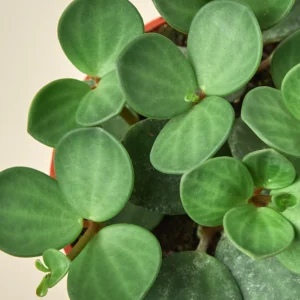
Origin: Brazil
Common Name(s): Peperomia Hope
About the Peperomia Hope
Peperomia Hope is a charming, semi-succulent plant known for its round, fleshy, light-green leaves that grow in pairs along trailing stems. This compact plant has a delicate, layered look, making it a lovely addition to hanging baskets or as a trailing accent on shelves or desks. While this Peperomia is does not have significant air purifying qualities, it can help improve indoor air quality by absorbing carbon dioxide and releasing oxygen, contributing to a fresher atmosphere.
Light
Bright, indirect light: Prefers bright, indirect light. Avoid direct sunlight, as it can cause leaf discoloration and scorch the leaves.
Water
Water weekly: Allow the soil to dry out completely between waterings. Overwatering is a common cause of root rot in peperomias.
Temperature & Humidity
Warm temperatures: Thrives in temperatures between 65-75°F (18-24°C) and moderate humidity, but can tolerate average indoor conditions.
How big will my plant grow?
It typically grows up to 12 inches (30 cm), making it ideal for small spaces, hanging baskets or trailing accents.
Is this plant toxic for pets and kids?
No. The Peperomia Hope is non-toxic to pets, making it a pet-friendly option for households with animals. As always, it’s best to monitor pets to prevent any accidental nibbling.
🌿 Additional Care Tips:
- Fertilize sparingly: Feed your Peperomia Hope with a diluted, balanced liquid fertilizer once or twice a year during the spring and summer. Too much fertilizer can burn the roots.
- Repot carefully: Repot your Peperomia Hope only when it becomes root-bound. Use a well-draining potting mix.
- Avoid overwatering: Overwatering is the most common cause of death for peperomias. Allow the soil to dry out completely before watering again.
- Protect from cold drafts & pests: Peperomias are sensitive to cold drafts. Place them away from drafty windows and doors. Additionally, keep an eye out for common houseplant pests like mealybugs and spider mites. Treat infestations promptly with insecticidal soap or neem oil.
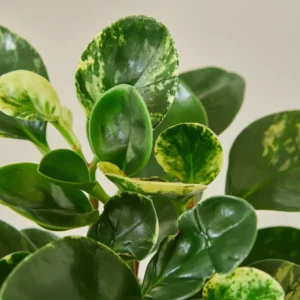
Origin: South America
Common Name(s): Peperomia Marble, Variegated Baby Rubber Plant
About the Peperomia Marble
Peperomia Marble is a popular and visually stunning variety of Peperomia, known for its thick, glossy, oval-shaped leaves adorned with variegated patterns of green, cream, and yellow. This compact and easy-care plant is native to tropical region of South America where it grows as an understory plant. While this Peperomia is does not have significant air purifying qualities, it can help improve air quality by absorbing carbon dioxide and releasing oxygen, contributing to a fresher indoor environment.
Light
Bright, indirect light: Prefers bright, indirect light. Avoid direct sunlight and low light as they can reduce leaf variegation.
Water
Water weekly: Allow the soil to dry out completely between waterings. Overwatering is a common cause of root rot in peperomias.
Temperature & Humidity
Warm temperatures: Thrives in temperatures between 65-75°F (18-24°C) and moderate humidity, but can tolerate average indoor conditions.
How big will my plant grow?
It typically grows up to 6-12 inches (15-30 cm), making it an ideal choice for desktops, shelves, and small indoor spaces.
Is this plant toxic for pets and kids?
No. The Peperomia Marble is non-toxic to pets, making it a pet-friendly option for households with animals. As always, it’s best to monitor pets to prevent any accidental nibbling.
🌿 Additional Care Tips:
- Fertilize sparingly: Feed your Peperomia Marble with a diluted, balanced liquid fertilizer once or twice a year during the spring and summer. Too much fertilizer can burn the roots.
- Repot carefully: Repot your Peperomia Marble only when it becomes root-bound. Use a well-draining potting mix.
- Avoid overwatering: Overwatering is the most common cause of death for peperomias. Allow the soil to dry out completely before watering again.
- Protect from cold drafts & pests: Peperomias are sensitive to cold drafts. Place them away from drafty windows and doors. Additionally, keep an eye out for common houseplant pests like mealybugs and spider mites. Treat infestations promptly with insecticidal soap or neem oil.

Origin: South America
Common Name(s): Metallica Peperomia, Shiny Peperomia
About the Peperomia Metallica
The Peperomia Metallica is a unique and visually striking houseplant known for its shiny, metallic-looking foliage. The leaves are thick and waxy with deep green colors, often accentuated by a reddish or coppery tint along the veins. This variety is compact and very easy to care for. While it does not have significant air purifying qualities, it can help improve air quality by absorbing carbon dioxide and releasing oxygen, contributing to a fresher indoor atmosphere.
Light
Bright, indirect light: Prefers bright, indirect light. Avoid direct sunlight, as it can cause leaf discoloration and scorch the leaves.
Water
Water weekly: Allow the soil to dry out completely between waterings. Overwatering is a common cause of root rot in peperomias.
Temperature & Humidity
Warm temperatures: Thrives in temperatures between 65-75°F (18-24°C) and high humidity, but can adapt to average indoor humidity. Mist during dry winter months.
How big will my plant grow?
It typically grows up to 6-8 inches (15-20 cm), making it an ideal choice for desktops, shelves, and small indoor spaces.
Is this plant toxic for pets and kids?
No. The Peperomia Metallica is non-toxic to pets, making it a pet-friendly option for households with animals.
🌿 Additional Care Tips:
- Fertilize sparingly: Feed your Peperomia Metallica with a diluted, balanced liquid fertilizer once or twice a year during the spring and summer seasons. Too much fertilizer can burn the roots.
- Repot carefully: Repot your Peperomia Metallica only when it becomes root-bound. Use a well-draining potting mix.
- Avoid overwatering: Overwatering is the most common cause of death for peperomias. Allow the soil to dry out completely before watering again.
- Protect from cold drafts & pests: Peperomias are sensitive to cold drafts. Place them away from drafty windows and doors. Additionally, keep an eye out for common houseplant pests like mealybugs and spider mites. Treat infestations promptly with insecticidal soap or neem oil.
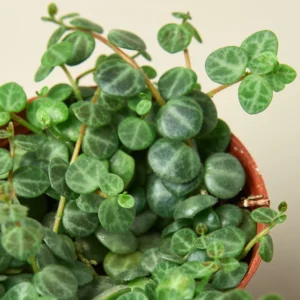
Origin: Brazil
Common Name(s): String of Turtles, Turtle Vine
About the Peperomia Prostrata 'String of Turtles’
The Peperomia prostrata is a charming and unique trailing plant known for its small, round leaves that resemble tiny turtle shells. The leaves have intricate, white veining over a green base, giving each one a patterned, almost mosaic-like appearance. This slow-growing plant is perfect for hanging baskets or as a cascading tabletop accent, where its delicate vines can trail down. While this Peperomia is does not have significant air purifying qualities, it can help improve indoor air quality by absorbing carbon dioxide and releasing oxygen, contributing to a fresher atmosphere.
Light
Bright, indirect light: Prefers bright, indirect light. Avoid direct sunlight, as it can cause leaf discoloration and scorch the leaves.
Water
Water weekly: Allow the soil to dry out completely between waterings. Overwatering is a common cause of root rot in peperomias.
Temperature & Humidity
Warm temperatures: Thrives in temperatures between 65-75°F (18-24°C) and moderate humidity, but can tolerate average indoor conditions.
How big will my plant grow?
It typically grows to a height of about 6 to 8 inches (15–20 cm), making it ideal for small spaces, hanging baskets, shelves, and tabletops.
Is this plant toxic for pets and kids?
No. The Peperomia Prostrata is non-toxic to pets, making it a pet-friendly option for households with animals. As always, it’s best to monitor pets to prevent any accidental nibbling.
🌿 Additional Care Tips:
- Fertilize sparingly: Feed your Peperomia Prostrata with a diluted, balanced liquid fertilizer once or twice a year during the spring and summer. Too much fertilizer can burn the roots.
- Repot carefully: Repot your Peperomia Prostrata only when it becomes root-bound. Use a well-draining potting mix.
- Avoid overwatering: Overwatering is the most common cause of death for peperomias. Allow the soil to dry out completely before watering again.
- Protect from cold drafts & pests: Peperomias are sensitive to cold drafts. Place them away from drafty windows and doors. Additionally, keep an eye out for common houseplant pests like mealybugs and spider mites. Treat infestations promptly with insecticidal soap or neem oil.
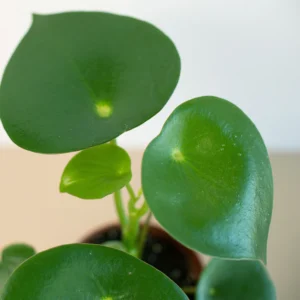
Origin: South America
Common Name(s): Raindrop Peperomia, Coin-Leaf Peperomia
About the Peperomia Raindrop
The Peperomia Raindrop is a striking and unique houseplant known for its glossy, heart-shaped leaves that resemble raindrops. The leaves are a rich green color and have a smooth, shiny texture, creating a visually appealing contrast against its slender, upright stems. This popular variety is very easy to care for. While it does not have significant air purifying qualities, it can help improve air quality by absorbing carbon dioxide and releasing oxygen, contributing to a fresher indoor environment.
Light
Bright, indirect light: Peperomia Raindrop thrives in bright, indirect light. Avoid direct sunlight, as it can scorch the leaves.
Water
Water weekly: Allow the soil to dry out completely between waterings. Overwatering is a common cause of root rot in peperomias.
Temperature & Humidity
Warm temperatures: Thrives in temperatures between 65-75°F (18-24°C) and high humidity, but can adapt to average indoor humidity. Mist during dry winter months.
How big will my plant grow?
It typically grows up to 8-12 inches (20-30 cm), making it an ideal choice for desktops, shelves, and small indoor spaces.
Is this plant toxic for pets and kids?
No. The Peperomia Raindrop is non-toxic to pets, making it a pet-friendly option for households with animals. As always, it’s best to monitor pets to prevent any accidental nibbling.
🌿 Additional Care Tips:
- Fertilize sparingly: Feed your Peperomia Raindrop with a diluted, balanced liquid fertilizer once or twice a year during the spring and summer seasons. Too much fertilizer can burn the roots.
- Repot carefully: Repot your Peperomia Raindrop only when it becomes root-bound. Use a well-draining potting mix.
- Avoid overwatering: Overwatering is the most common cause of death for peperomias. Allow the soil to dry out completely before watering again.
- Protect from cold drafts & pests: Peperomias are sensitive to cold drafts. Place them away from drafty windows and doors. Additionally, keep an eye out for common houseplant pests like mealybugs and spider mites. Treat infestations promptly with insecticidal soap or neem oil.
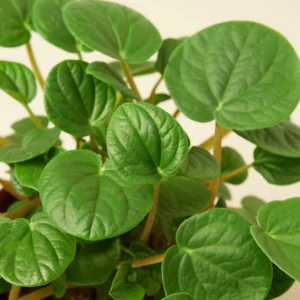
Origin: Brazil
Common Name(s): Rana Verde Peperomia, Green Creeping Peperomia
About the Peperomia Rana Verde
Peperomia Rana Verde is a charming, trailing variety of Peperomia known for its round, succulent-like leaves that have a vibrant green color. This low-maintenance plant is perfect for hanging baskets, shelves, or as a cascading tabletop accent. While this Peperomia is not a heavy air purifier, it can help improve indoor air quality by absorbing carbon dioxide and releasing oxygen, contributing to a fresher atmosphere.
Light
Bright, indirect light: Rana Verde peperomia thrives in bright, indirect light. Avoid direct sunlight, as it can scorch the leaves.
Water
Water weekly: Water when the top 1 inch of soil feels dry. Typically, water every 7-10 days, but reduce in winter. Ensure the pot has drainage to avoid waterlogging.
Temperature & Humidity
Warm temperatures: Thrives in temperatures between 65-75°F (18-24°C). Prefers humidity levels around 50-60% but can adapt to average indoor humidity.
How big will my plant grow?
It typically grows to a height of about 6 to 12 inches (15–30 cm), making it ideal for small spaces, hanging baskets, shelves, and tabletops.
Is this plant toxic for pets and kids?
No. The Peperomia Rana Verde is non-toxic to pets, making it a pet-friendly option for households with animals. As always, it’s best to monitor pets to prevent any accidental nibbling, but this plant is generally safe around cats and dogs.
🌿 Additional Care Tips:
- Fertilize sparingly: Feed your Rana Verde peperomia with a diluted, balanced liquid fertilizer once or twice a year during the spring and summer.
- Repot infrequently: Repot your Rana Verde peperomia only when it becomes root-bound. Use a well-draining potting mix.
- Avoid overwatering: Overwatering is the most common cause of death for peperomias. Allow the soil to dry out completely before watering again.
- Unique leaf shape: The Rana Verde peperomia is known for its distinctive, heart-shaped leaves with a vibrant green color.
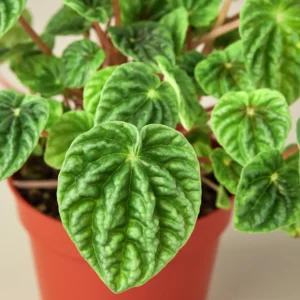
Origin: Brazil
Common Name(s): Ripple Peperomia, Emerald Ripple, Radiator Plant
About the Peperomia Ripple
The Peperomia Ripple is a compact and decorative houseplant known for its deeply textured, wrinkled leaves that come in various shades, from rich green to silvery and even purple. Its distinctive, heart-shaped leaves and mounding growth habit make it a popular choice for tabletops, desks, and shelves. While this Peperomia is does not have significant air purifying qualities, it can help improve indoor air quality by absorbing carbon dioxide and releasing oxygen, contributing to a fresher atmosphere.
Light
Bright, indirect light: Peperomia Ripple thrives in bright, indirect light. Avoid direct sunlight, as it can cause leaf discoloration.
Water
Water weekly: Allow the soil to dry out completely between waterings. Overwatering is a common cause of root rot in peperomias.
Temperature & Humidity
Warm temperatures: Thrives in temperatures between 65-75°F (18-24°C) and moderate humidity, but can tolerate average indoor conditions.
How big will my plant grow?
It typically grows to a height of about 6 to 8 inches (15–20 cm), making it ideal for small spaces, hanging baskets, shelves, and tabletops.
Is this plant toxic for pets and kids?
No. The Peperomia Ripple is non-toxic to pets, making it a pet-friendly option for households with animals. As always, it’s best to monitor pets to prevent any accidental nibbling, but this plant is generally safe around cats and dogs.
🌿 Additional Care Tips:
- Fertilize sparingly: Feed your Peperomia Ripple with a diluted, balanced liquid fertilizer once or twice a year during the spring and summer. Too much fertilizer can burn the roots.
- Repot carefully: Repot your Peperomia Ripple only when it becomes root-bound. Use a well-draining potting mix.
- Avoid overwatering: Overwatering is the most common cause of death for peperomias. Allow the soil to dry out completely before watering again.
- Protect from cold drafts & pests: Peperomias are sensitive to cold drafts. Place them away from drafty windows and doors. Additionally, keep an eye out for common houseplant pests like mealybugs and spider mites. Treat infestations promptly with insecticidal soap or neem oil.
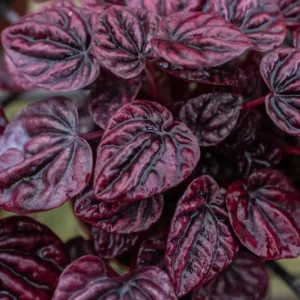
Origin: South America
Common Name(s): Red Ripple Peperomia, Ruby Ripple Peperomia
About the Peperomia Ripple Red
The Peperomia Red Ripple is an eye-catching, compact houseplant known for its deeply textured, heart-shaped leaves that feature a rich, burgundy-red color. The striking red foliage provides a dramatic contrast when grouped with other green plants, adding depth and color to any indoor space. While this Peperomia is does not have significant air purifying qualities, it can help improve indoor air quality by absorbing carbon dioxide and releasing oxygen, contributing to a fresher atmosphere.
Light
Bright, indirect light: Prefers bright, indirect light. Avoid direct sunlight, as it can cause leaf discoloration and scorch the leaves.
Water
Water weekly: Allow the soil to dry out completely between waterings. Overwatering is a common cause of root rot in peperomias.
Temperature & Humidity
Warm temperatures: Thrives in temperatures between 65-75°F (18-24°C) and moderate humidity, but can tolerate average indoor conditions.
How big will my plant grow?
It typically grows to a height of about 6 to 8 inches (15–20 cm), making it ideal for small spaces, hanging baskets, shelves, and tabletops. It has a mounding growth habit.
Is this plant toxic for pets and kids?
No. The Peperomia Ripple Red is non-toxic to pets, making it a pet-friendly option for households with animals. As always, it’s best to monitor pets to prevent any accidental nibbling.
🌿 Additional Care Tips:
- Fertilize sparingly: Feed your Peperomia Ripple Red with a diluted, balanced liquid fertilizer once or twice a year during the spring and summer. Too much fertilizer can burn the roots.
- Repot carefully: Repot your Peperomia Ripple Red only when it becomes root-bound. Use a well-draining potting mix.
- Avoid overwatering: Overwatering is the most common cause of death for peperomias. Allow the soil to dry out completely before watering again.
- Protect from cold drafts & pests: Peperomias are sensitive to cold drafts. Place them away from drafty windows and doors. Additionally, keep an eye out for common houseplant pests like mealybugs and spider mites. Treat infestations promptly with insecticidal soap or neem oil.
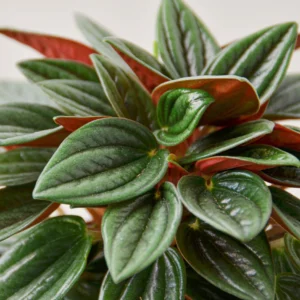
Origin: Brazil
Common Name(s): Peperomia Rosso, Red-Edged Peperomia
About the Peperomia Rosso
Peperomia Rosso is a striking variety of Peperomia known for its dark green, heart-shaped leaves that have vibrant red undersides and a unique, textured surface. This compact and decorative plant makes an excellent addition to small spaces like desks, shelves, or tabletops While this Peperomia is does not have significant air purifying qualities, it can help improve indoor air quality by absorbing carbon dioxide and releasing oxygen, contributing to a fresher atmosphere.
Light
Bright, indirect light: Peperomia Rosso thrives in bright, indirect light. Avoid direct sunlight, as it can scorch the leaves.
Water
Water weekly: Allow the soil to dry out completely between waterings. Overwatering is a common cause of root rot in peperomias.
Temperature & Humidity
Warm temperatures: Thrives in temperatures between 65-75°F (18-24°C) and high humidity, but can adapt to average indoor humidity. Mist during dry winter months.
How big will my plant grow?
It typically grows to a height of about 8 to 10 inches (20–25 cm), making it ideal for small spaces, hanging baskets, shelves, and tabletops.
Is this plant toxic for pets and kids?
No. The Peperomia Rosso is non-toxic to pets, making it a pet-friendly option for households with animals. As always, it’s best to monitor pets to prevent any accidental nibbling, but this plant is generally safe around cats and dogs.
🌿 Additional Care Tips:
- Fertilize sparingly: Feed your Peperomia Rosso with a diluted, balanced liquid fertilizer once or twice a year during the spring and summer seasons. Too much fertilizer can burn the roots.
- Repot carefully: Repot your Peperomia Rosso only when it becomes root-bound. Use a well-draining potting mix.
- Avoid overwatering: Overwatering is the most common cause of death for peperomias. Allow the soil to dry out completely before watering again.
- Protect from cold drafts: Peperomias are sensitive to cold drafts. Place them away from drafty windows and doors.
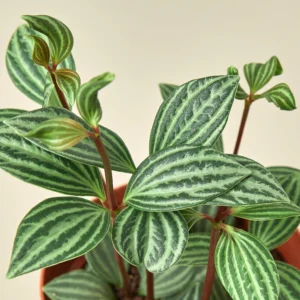
Origin: South America
Common Name(s): Parallel Peperomia
About the Peperomia Parallel
Peperomia Parallel is an elegant and unique variety known for its striking foliage. The plant has narrow, elongated, dark green leaves with parallel veins running through them, giving it a clean, graphic appearance. This compact plant is typically low-growing, making it ideal for small spaces, such as desks, windowsills, or shelves. Its simple yet bold leaf pattern makes it an eye-catching addition to any indoor garden. While it does not have significant air purifying qualities, it can help improve air quality by absorbing carbon dioxide and releasing oxygen, contributing to a fresher indoor atmosphere.
Light
Bright, indirect light: Prefers bright, indirect light. Avoid direct sunlight, as it can cause leaf discoloration and scorch the leaves.
Water
Water weekly: Allow the soil to dry out completely between waterings. Overwatering is a common cause of root rot in peperomias.
Temperature & Humidity
Warm temperatures: Thrives in temperatures between 65-75°F (18-24°C) and high humidity, but can adapt to average indoor humidity. Mist during dry winter months.
How big will my plant grow?
It typically grows up to 6-8 inches (15-20 cm), making it ideal for small spaces, such as desks, windowsills, or shelves.
Is this plant toxic for pets and kids?
No. The Peperomia Parallel is non-toxic to pets, making it a pet-friendly option for households with animals.
🌿 Additional Care Tips:
- Fertilize sparingly: Feed your Peperomia Parallel with a diluted, balanced liquid fertilizer once or twice a year during the spring and summer seasons. Too much fertilizer can burn the roots.
- Repot carefully: Repot your Peperomia Parallel only when it becomes root-bound. Use a well-draining potting mix.
- Avoid overwatering: Overwatering is the most common cause of death for peperomias. Allow the soil to dry out completely before watering again.
- Protect from cold drafts & pests: Peperomias are sensitive to cold drafts. Place them away from drafty windows and doors. Additionally, keep an eye out for common houseplant pests like mealybugs and spider mites. Treat infestations promptly with insecticidal soap or neem oil.
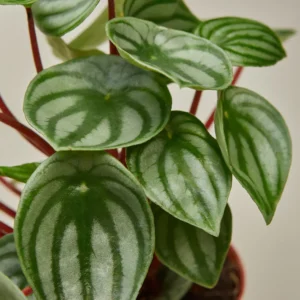
Origin: South America
Common Name(s): Watermelon Peperomia, Watermelon Begonia
About the Peperomia Watermelon
The Peperomia Watermelon, a rare, striking and compact houseplant, is known for its uniquely patterned, heart-shaped leaves that resemble the skin of a watermelon. The leaves are a beautiful mix of dark green with silver stripes running down the center, giving them a distinctive, almost metallic sheen. This variety is native to tropical regions in South America. While this Peperomia is does not have significant air purifying qualities, it can help improve air quality by absorbing carbon dioxide and releasing oxygen, contributing to a fresher indoor environment.
Light
Bright, indirect light: Prefers bright, indirect light. Avoid direct sunlight, as it can scorch the leaves and damage the watermelon-patterned variegation.
Water
Water weekly: Allow the soil to dry out completely between waterings. Overwatering is a common cause of root rot in peperomias.
Temperature & Humidity
Warm temperatures: Thrives in temperatures between 65-75°F (18-24°C) and moderate humidity, but can tolerate average indoor conditions.
How big will my plant grow?
It typically grows up to 8-12 inches (20-30 cm), making it an ideal choice for desktops, shelves, and small indoor spaces.
Is this plant toxic for pets and kids?
No. The Peperomia Watermelon is non-toxic to pets, making it a pet-friendly option for households with animals. As always, it’s best to monitor pets to prevent any accidental nibbling.
🌿 Additional Care Tips:
- Fertilize sparingly: Feed your Peperomia Watermelon with a diluted, balanced liquid fertilizer once or twice a year during the spring and summer seasons. Too much fertilizer can burn the roots.
- Repot carefully: Repot your Peperomia Watermelon only when it becomes root-bound. Use a well-draining potting mix.
- Avoid overwatering: Overwatering is the most common cause of death for peperomias. Allow the soil to dry out completely before watering again.
- Protect from cold drafts & pests: Peperomias are sensitive to cold drafts. Place them away from drafty windows and doors. Additionally, keep an eye out for common houseplant pests like mealybugs and spider mites. Treat infestations promptly with insecticidal soap or neem oil.
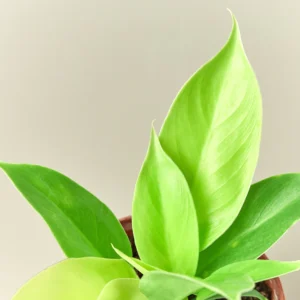
Origin: Central & South America
Common Name(s): Billietiae Philodendron
About the Philodendron Billietiae
The Philodendron Billietiae is a striking and unique variety known for its large, elongated, lance-shaped leaves that feature bold color contrasts. The leaves are deep green with yellow or orange veining, which gives them a dramatic and exotic look. This plant is known for its strong and significant air purifying qualities such as removing toxins from the air, producing oxygen, and regulating indoor humidity levels. This plant contributes to a fresher indoor environment.
Light
Bright, indirect light: Prefers bright, indirect light. Avoid direct sunlight, as it can cause leaf discoloration and scorch the leaves.
Water
Water weekly: Water when the top soil are dry, typically every 7-10 days. Reduce watering in winter and ensure the pot has drainage to prevent root rot.
Temperature & Humidity
Warm temperatures: Thrives in temperatures between 65-75°F (18-24°C) and moderate-to-high humidity.
How big will my plant grow?
It typically grows up to 3-6 feet, making it perfect for larger spaces or as a statement plant in a well-lit room.
Is this plant toxic for pets and kids?
Yes. This Philodendron variety is toxic to pets (cats and dogs) if ingested, so it’s important to keep it out of reach of curious animals. Keep away from small children to prevent accidental ingestion.
🌿 Additional Care Tips:
- Fertilize regularly: Feed your plant with a balanced liquid fertilizer diluted to half strength every 4 weeks during the spring and summer season.
- Monitor for pests: Keep an eye out for common houseplant pests like mealybugs and spider mites. Treat infestations promptly with insecticidal soap or neem oil.
- Be patient: Philodendron plants are slow growers, so don't be discouraged if it doesn't grow rapidly.
- Provide support: As the plant grows, it may require a moss pole or trellis to support its vining growth.
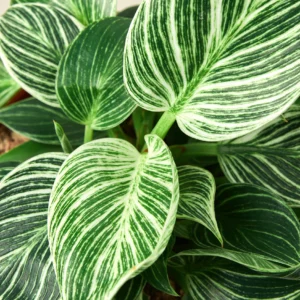
Origin: Central & South America
Common Name(s): Birkin Philodendron
About the Philodendron Birkin
Philodendron Birkin is a striking, ornamental houseplant known for its unique and eye-catching variegated leaves. The leaves are glossy and dark green with striking white or cream-colored streaks that run through the center, creating a beautiful, pinstriped pattern. This compact plant is a perfect choice for desks, tabletops, or smaller spaces in your home. This plant is known for its strong and significant air purifying qualities such as removing toxins from the air, producing oxygen, and regulating indoor humidity levels. This plant contributes to a fresher indoor environment.
Light
Bright, indirect light: Prefers bright, indirect light. Avoid direct sunlight, as it can cause leaf discoloration and scorch the leaves.
Water
Water weekly: Water when the top soil are dry, typically every 7-10 days. Reduce watering in winter and ensure the pot has drainage to prevent root rot.
Temperature & Humidity
Warm temperatures: Thrives in temperatures between 65-75°F (18-24°C) and moderate-to-high humidity.
How big will my plant grow?
It typically grows up to 12-18 inches (30-45 cm), making it ideal for small spaces, desks, tabletops, and windowsills. It has a bushy growth habit.
Is this plant toxic for pets and kids?
Yes. This Philodendron variety is toxic to pets (cats and dogs) if ingested, so it’s important to keep it out of reach of curious animals. Keep away from small children to prevent accidental ingestion.
🌿 Additional Care Tips:
- Fertilize regularly: Feed your plant with a balanced liquid fertilizer diluted to half strength every 4 weeks during the spring and summer season.
- Monitor for pests: Keep an eye out for common houseplant pests like mealybugs and spider mites. Treat infestations promptly with insecticidal soap or neem oil.
- Be patient: Philodendron Birkin is a slow grower, so don't be discouraged if it doesn't grow rapidly.
- Repotting: Repot every 1-2 years or when the plant becomes root-bound. Use a well-draining potting mix, such as peat-based or general houseplant mix, and select a pot that’s just 1-2 inches larger than the current one.
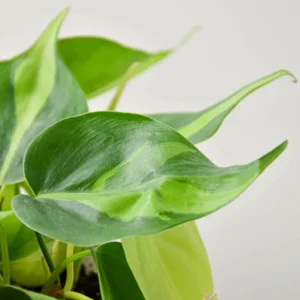
Origin: Central & South America
Common Name(s): Brasil Philodendron
About the Philodendron Brasil
The Philodendron Brasil is a vibrant, fast-growing variety known for its striking heart-shaped leaves that feature bold, variegated patterns. The leaves are deep green with bright yellow or golden streaks, creating a lively and tropical appearance. This climbing or trailing plant is an easy-care option and is perfect for hanging baskets, shelves, or as a floor plant. This plant is also known for its strong and significant air purifying qualities such as removing toxins from the air, producing oxygen, and regulating indoor humidity levels. This plant contributes to a fresher indoor atmosphere year round.
Light
Bright, indirect light: Prefers bright, indirect light. Avoid direct sunlight, as it can cause leaf discoloration and scorch the leaves.
Water
Water weekly: Water when the top soil are dry, typically every 7-10 days. Reduce watering in winter and ensure the pot has drainage to prevent root rot.
Temperature & Humidity
Warm temperatures: Thrives in temperatures between 65-75°F (18-24°C) and moderate-to-high humidity.
How big will my plant grow?
It typically grows up to 2-3 feet and spreads as a groundcover or climbing vine, making it perfect for hanging baskets or as a floor plant.
Is this plant toxic for pets and kids?
Yes. This Philodendron variety is toxic to pets (cats and dogs) if ingested, so it’s important to keep it out of reach of curious animals. Keep away from small children to prevent accidental ingestion.
🌿 Additional Care Tips:
- Fertilize regularly: Feed your plant with a balanced liquid fertilizer diluted to half strength every 4 weeks during the spring and summer season.
- Monitor for pests: Keep an eye out for common houseplant pests like mealybugs and spider mites. Treat infestations promptly with insecticidal soap or neem oil.
- Be patient: Philodendron plants are slow growers, so don't be discouraged if it doesn't grow rapidly.
- Provide support: As the plant grows, it may require a moss pole or trellis to support its vining growth.

Origin: Central & South America
Common Name(s): Little Hope Philodendron
About the Philodendron Little Hope
The Philodendron Little Hope is a compact and low-maintenance variety known for its lush, heart-shaped leaves that have a rich, deep green color. This small yet sturdy plant has a bushy growth habit and is ideal for small spaces like desks, tabletops, or hanging baskets. This plant is known for its strong and significant air purifying qualities such as removing toxins from the air, producing oxygen, and regulating indoor humidity levels. This plant contributes to a fresher indoor environment.
Light
Bright, indirect light: Prefers bright, indirect light. Avoid direct sunlight, as it can cause leaf discoloration and scorch the leaves.
Water
Water weekly: Water when the top soil are dry, typically every 7-10 days. Reduce watering in winter and ensure the pot has drainage to prevent root rot.
Temperature & Humidity
Warm temperatures: Thrives in temperatures between 65-75°F (18-24°C) and moderate-to-high humidity.
How big will my plant grow?
It typically grows up to 12-18 inches (30-45 cm), making it ideal for small to medium spaces, indoor gardens, and windowsills.
Is this plant toxic for pets and kids?
Yes. This Philodendron variety is toxic to pets (cats and dogs) if ingested, so it’s important to keep it out of reach of curious animals. Keep away from small children to prevent accidental ingestion.
🌿 Additional Care Tips:
- Fertilize regularly: Feed your plant with a balanced liquid fertilizer diluted to half strength every 4 weeks during the spring and summer season.
- Monitor for pests: Keep an eye out for common houseplant pests like mealybugs and spider mites. Treat infestations promptly with insecticidal soap or neem oil.
- Be patient: Philodendron Little Hope is a slow grower, so don't be discouraged if it doesn't grow rapidly.
- Repotting: Repot every 1-2 years or when the plant becomes root-bound. Use a well-draining potting mix, such as peat-based or general houseplant mix, and select a pot that’s just 1-2 inches larger than the current one.

Origin: Central & South America
Common Name(s): Moonlight Philodendron
About the Philodendron Moonlight
The Philodendron Moonlight is a stunning variety known for its vibrant, lime-green foliage that brightens any indoor space. The leaves have a smooth, waxy texture and maintain their luminous green color throughout their lifespan, making it a striking addition to any home. This plant has an upright, bushy growth habit and is perfect for smaller spaces or as a decorative accent in larger rooms.
This plant is known for its strong and significant air purifying qualities such as removing toxins from the air, producing oxygen, and regulating indoor humidity levels. This plant contributes to a fresher indoor environment.
Light
Bright, indirect light: Prefers bright, indirect light. Avoid direct sunlight, as it can cause leaf discoloration and scorch the leaves.
Water
Water weekly: Water when the top soil are dry, typically every 7-10 days. Reduce watering in winter and ensure the pot has drainage to prevent root rot.
Temperature & Humidity
Warm temperatures: Thrives in temperatures between 65-75°F (18-24°C) and moderate-to-high humidity.
How big will my plant grow?
It typically grows up to 2-3 feet, perfect for smaller spaces or as a decorative accent in larger rooms. It grows in an upright bushy structure.
Is this plant toxic for pets and kids?
Yes. This Philodendron variety is toxic to pets (cats and dogs) if ingested, so it’s important to keep it out of reach of curious animals. Keep away from small children to prevent accidental ingestion.
🌿 Additional Care Tips:
- Fertilize regularly: Feed your plant with a balanced liquid fertilizer diluted to half strength every 4 weeks during the spring and summer season.
- Monitor for pests: Keep an eye out for common houseplant pests like mealybugs and spider mites. Treat infestations promptly with insecticidal soap or neem oil.
- Be patient: Philodendron plants are slow growers, so don't be discouraged if it doesn't grow rapidly.
- Provide support: As the plant grows, it may require a moss pole or trellis to support its vining growth.
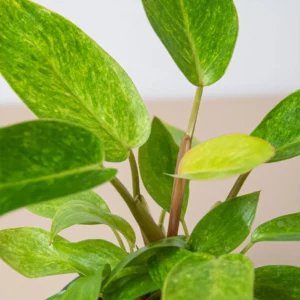
Origin: Central & South America
Common Name(s): Painted Lady Philodendron
About the Philodendron Painted Lady
The Philodendron Painted Lady is a beautiful and unique variety known for its striking, variegated leaves. The leaves feature a mix of light green, yellow, and cream tones with bold splashes of darker green, creating a painterly effect that gives the plant its name. This climbing or trailing Philodendron is stunning addition to larger spaces or vertical gardening setups. This plant is also known for its strong and significant air purifying qualities such as removing toxins from the air, producing oxygen, and regulating indoor humidity levels. This plant contributes to a fresher indoor atmosphere year round.
Light
Bright, indirect light: Prefers bright, indirect light. Avoid direct sunlight, as it can cause leaf discoloration and scorch the leaves.
Water
Water weekly: Water when the top soil are dry, typically every 7-10 days. Reduce watering in winter and ensure the pot has drainage to prevent root rot.
Temperature & Humidity
Warm temperatures: Thrives in temperatures between 65-75°F (18-24°C) and moderate-to-high humidity.
How big will my plant grow?
It typically grows up to 3-4 feet, perfect for large indoor spaces and setups.
Is this plant toxic for pets and kids?
Yes. This Philodendron variety is toxic to pets (cats and dogs) if ingested, so it’s important to keep it out of reach of curious animals. Keep away from small children to prevent accidental ingestion.
🌿 Additional Care Tips:
- Fertilize regularly: Feed your plant with a balanced liquid fertilizer diluted to half strength every 4 weeks during the spring and summer season.
- Monitor for pests: Keep an eye out for common houseplant pests like mealybugs and spider mites. Treat infestations promptly with insecticidal soap or neem oil.
- Be patient: Philodendron plants are slow growers, so don't be discouraged if it doesn't grow rapidly.
- Provide support: As the plant grows, it may require a moss pole or trellis to support its vining growth.
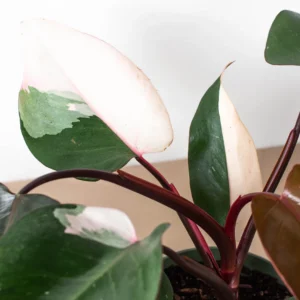
Origin: Central & South America
Common Name(s): Pink Princess Philodendron
About the Philodendron Pink Princess
The Philodendron Pink Princess is a highly sought-after variety known for its stunning variegated leaves that feature a beautiful mix of deep green and vibrant pink hues. The pink coloration can vary in intensity, creating a striking contrast against the dark green backdrop, making it an eye-catching addition to any indoor space. This climbing trailing plant is a perfect choice for hanging baskets. This plant is known for its strong and significant air purifying qualities such as removing toxins from the air, producing oxygen, and regulating indoor humidity levels. This plant contributes to a fresher indoor environment.
Light
Bright, indirect light: Prefers bright, indirect light. Avoid direct sunlight, as it can cause leaf discoloration and scorch the leaves.
Water
Water weekly: Water when the top soil are dry, typically every 7-10 days. Reduce watering in winter and ensure the pot has drainage to prevent root rot.
Temperature & Humidity
Warm temperatures: Thrives in temperatures between 65-75°F (18-24°C) and moderate-to-high humidity.
How big will my plant grow?
It typically grows up to 2-3 feet, making it perfect for hanging baskets or as a trailing plant in containers.
Is this plant toxic for pets and kids?
Yes. This Philodendron variety is toxic to pets (cats and dogs) if ingested, so it’s important to keep it out of reach of curious animals. Keep away from small children to prevent accidental ingestion.
🌿 Additional Care Tips:
- Fertilize regularly: Feed your plant with a balanced liquid fertilizer diluted to half strength every 4 weeks during the spring and summer season.
- Monitor for pests: Keep an eye out for common houseplant pests like mealybugs and spider mites. Treat infestations promptly with insecticidal soap or neem oil.
- Be patient: Philodendron Pink Princesss is a slow grower, so don't be discouraged if it doesn't grow rapidly.
- Provide support: As the plant grows, it may require a moss pole or trellis to support its vining growth.
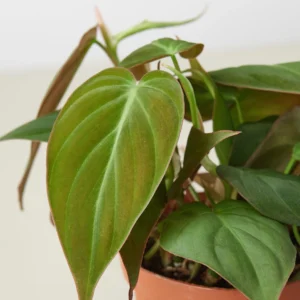
Origin: Central & South America
Common Name(s): Velvet Philodendron
About the Philodendron Velvet
The Philodendron Velvet is a visually stunning variety known for its rich, velvety, deep green leaves with a soft, almost plush texture. The leaves are large, heart-shaped, and have a distinct, luxurious feel, which gives the plant its "velvet" appeal. Its elegant foliage adds a touch of sophistication to any home. This compact plant is a perfect choice for desks, tabletops, or smaller spaces in your home. This plant is known for its strong and significant air purifying qualities such as removing toxins from the air, producing oxygen, and regulating indoor humidity levels. This plant contributes to a fresher indoor environment.
Light
Bright, indirect light: Prefers bright, indirect light. Avoid direct sunlight, as it can cause leaf discoloration and scorch the leaves.
Water
Water weekly: Water when the top soil are dry, typically every 7-10 days. Reduce watering in winter and ensure the pot has drainage to prevent root rot.
Temperature & Humidity
Warm temperatures: Thrives in temperatures between 65-75°F (18-24°C) and moderate-to-high humidity.
How big will my plant grow?
It typically grows up to 12-24 inches (30-60 cm), making it ideal for medium-sized indoor spaces such as desks, shelves, or tabletops.
Is this plant toxic for pets and kids?
Yes. This Philodendron variety is toxic to pets (cats and dogs) if ingested, so it’s important to keep it out of reach of curious animals. Keep away from small children to prevent accidental ingestion.
🌿 Additional Care Tips:
- Fertilize regularly: Feed your plant with a balanced liquid fertilizer diluted to half strength every 4 weeks during the spring and summer season.
- Monitor for pests: Keep an eye out for common houseplant pests like mealybugs and spider mites. Treat infestations promptly with insecticidal soap or neem oil.
- Be patient: Philodendron Velvet is a slow grower, so don't be discouraged if it doesn't grow rapidly.
- Provide support: As the plant grows, it may require a moss pole or trellis to support its vining growth.
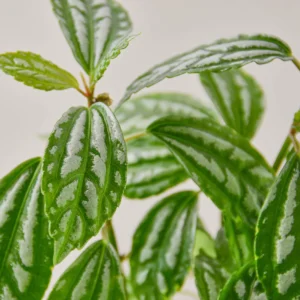
Origin: South China
Common Name(s): Aluminum Plant, Watermelon Pilea
About the Pilea Aluminum
Pilea Aluminum is an attractive, easy-care plant prized for its unique, metallic-silver patterns on deep green leaves, giving it a striking, textured look. This compact plant is of a low-maintenance nature with eye-catching foliage that makes it a popular choice for both beginner and seasoned plant enthusiasts. This plant is also known for its significant air purifying qualities such as producing oxygen and regulating indoor humidity levels.
Light
Bright, indirect light: This plant thrives in bright, indirect light. Avoid direct sunlight, especially during intense midday hours.
Water
Water weekly: Water every 5-7 days. Reduce watering in winter and ensure the pot has drainage to prevent root rot.
Temperature & Humidity
Warm temperatures: Thrives in temperatures between 65-75°F (18-24°C) and moderate-to-high humidity.
How big will my plant grow?
It typically grows up to 2-3 feet, making it perfect for tabletops, shelves, or windowsills.
Is this plant toxic for pets and kids?
No. The Pilea Aluminum is considered non-toxic to pets, making it a safe option for homes with cats or dogs.
🌿 Additional Care Tips:
- Fertilize regularly: Feed your plant with a balanced liquid fertilizer diluted to half strength every 4 weeks during the spring and summer season.
- Monitor for pests: Keep an eye out for common houseplant pests like mealybugs and spider mites. Treat infestations promptly with insecticidal soap or neem oil.
- Propagation: Pilea Aluminum can be easily propagated through stem cuttings.
- Prune to maintain beauty: Regularly pinch back leggy stems to encourage a bushier shape and remove any yellowing leaves to maintain a neat appearance. The plant is known for its distinctive, silver-green leaves with a metallic sheen.
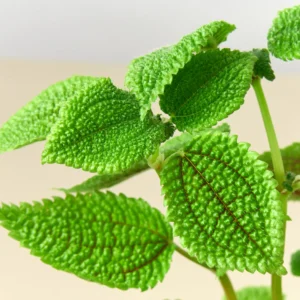
Origin: South China
Common Name(s): Moon Valley Pilea, Friendship Plant
About the Pilea Moon Valley
Pilea Moon Valley is admired for its textured, crinkled leaves that feature deep green and bronze tones, creating a stunning, almost mosaic-like appearance. The leaves are oval and have a distinct, pebbly texture that adds visual interest to any space. This plant is also known for its significant air purifying qualities such as producing oxygen and regulating indoor humidity levels.
Light
Bright, indirect light: This plant thrives in bright, indirect light. Avoid direct sunlight, especially during intense midday hours.
Water
Water weekly: Water every 5-7 days. Reduce watering in winter and ensure the pot has drainage to prevent root rot.
Temperature & Humidity
Warm temperatures: Thrives in temperatures between 65-75°F (18-24°C) and moderate-to-high humidity.
How big will my plant grow?
It typically grows up to 6-12 inches, making it perfect for desktops, shelves, or windowsills. It remains compact as it grows.
Is this plant toxic for pets and kids?
No. This Pilea is considered non-toxic to pets, making it a safe option for homes with cats or dogs.
🌿 Additional Care Tips:
- Fertilize regularly: Feed your plant with a balanced liquid fertilizer diluted to half strength every 4 weeks during the spring and summer season.
- Monitor for pests: Keep an eye out for common houseplant pests like mealybugs and spider mites. Treat infestations promptly with insecticidal soap or neem oil.
- Propagation: Pilea Moon Valley can be easily propagated through stem cuttings or leaf cuttings.
- Repotting: Repot annually in spring using a well-draining potting mix, such as one with peat and perlite. Select a pot only 1-2 inches larger in diameter to prevent overwatering issues due to excess soil.
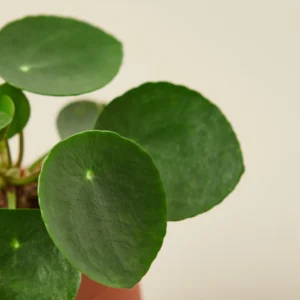
Origin: South China
Common Name(s): Chinese Money Plant, Pancake Plant, UFO Plant
About the Pilea Peperomioides Chinese Money
The Chinese Money Plant is loved for its charming, round, coin-shaped leaves that grow on long, slender stems, creating a unique, sculptural appearance. This compact plant is ideal choice for desktops, shelves, or small spaces. With its easy care requirements and eye-catching form, it’s perfect for beginners and adds a playful touch to any room. This plant is also known for its significant air purifying qualities such as producing oxygen and regulating indoor humidity levels.
Light
Bright, indirect light: This plant thrives in bright, indirect light. Avoid direct sunlight, especially during intense midday hours.
Water
Water weekly: Water every 5-7 days. Reduce watering in winter and ensure the pot has drainage to prevent root rot.
Temperature & Humidity
Warm temperatures: Thrives in temperatures between 65-75°F (18-24°C) and moderate-to-high humidity.
How big will my plant grow?
It typically grows up to 12 inches, making it perfect for tabletops, shelves, or windowsills. It remains compact as it grows.
Is this plant toxic for pets and kids?
No. This Pilea is considered non-toxic to pets, making it a safe option for homes with cats or dogs.
🌿 Additional Care Tips:
- Fertilize regularly: Feed your plant with a balanced liquid fertilizer diluted to half strength every 4 weeks during the spring and summer season.
- Monitor for pests: Keep an eye out for common houseplant pests like mealybugs and spider mites. Treat infestations promptly with insecticidal soap or neem oil.
- Propagation: This plant produces small “pups” around the base. Gently separate these and replant them to grow new plants or to encourage a less crowded main plant.
- Rotate occasionally and prune: Rotate the plant regularly to maintain balanced growth. Remove any yellowing or damaged leaves regularly to maintain a neat appearance. Prune any leggy growth to encourage a fuller shape.
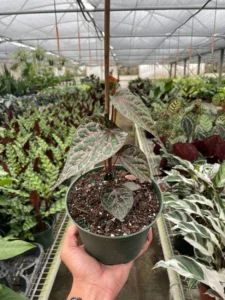
Origin: South America
Common Name(s): Piper Crocatum, Silver-Leaf Betel
About the Piper Crocatum
Piper Crocatum is a stunning tropical vine known for its heart-shaped leaves that showcase a striking, metallic silver pattern on a dark green background, with hints of pink or red on the undersides. This plant is ideal for adding a bold, exotic touch to any indoor space. With its climbing growth habit, Piper Crocatum is well-suited for hanging baskets or climbing trellises. This plant is also known for its significant air purifying qualities such as producing oxygen and regulating indoor humidity levels.
Light
Bright, indirect light: Piper Crocatum thrives in bright, indirect light. Avoid direct sunlight, especially during intense midday hours. A spot near an east-facing window is ideal.
Water
Water weekly: Every 5-7 days. Water thoroughly, ensuring the soil is evenly moistened, and then allow it to dry out completely before watering again.
Temperature & Humidity
Warm temperatures: Thrives in temperatures between 65-80°F (18-27°C). Requires high humidity (70%+); mist regularly, place near a humidifier if needed.
How big will my plant grow?
With proper care, it typically grows up to 2-3 feet, making it perfect for trellis and hanging basket.
Is this plant toxic for pets and kids?
Yes, the Piper Crocatum is toxic if ingested, so it should be kept out of reach of pets and children.
🌿 Additional Care Tips:
- Fertilize regularly: Feed your plant with a balanced liquid fertilizer diluted to half strength every 4 weeks during the spring and summer season.
- Monitor for pests: Keep an eye out for common houseplant pests like mealybugs and spider mites. Treat infestations promptly with insecticidal soap or neem oil.
- Propagation: This plant can be easily propagated through stem cuttings or leaf cuttings.
- Crystal formation: You may notice small, crystal-like formations on the leaves. This is a normal process and indicates the plant is healthy.
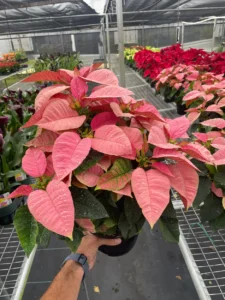
Origin: South America
Common Name(s): Poinsettia Pink
About the Poinsettia Pink
Poinsettia Pink is a beautiful and delicate variety of the classic Poinsettia, known for its soft pink bracts that surround the tiny yellow flowers in the center. This variety adds a touch of elegance and charm to any holiday decor or indoor space. It's perfect for tabletops, windowsills, or as part of a festive display during the winter season. This plant is also known for its significant air purifying qualities such as removing toxins and producing oxygen.
Light
Bright, indirect light: Poinsettias thrives in bright, indirect light. Avoid direct sunlight, as it can scorch the leaves.
Water
Water regularly: Water when the top 1-2 inches of soil feel dry, typically every 3-4 days. Be sure to water thoroughly, allowing water to drain out of the pot. Reduce watering in winter when the plant is dormant.
Temperature & Humidity
Warm temperatures: Poinsettias prefers cool temperatures, ideally between 65-75°F (18-24°C) with moderate humidity.
How big will my plant grow?
It typically grows up to 12-18 inches, making it a perfect decorative choice for tabletops, windowsills, and holiday displays.
Is this plant toxic for pets and kids?
Yes. Poinsettias are mildly toxic to pets (cats and dogs) if ingested, causing mild stomach upset. It's best to keep them out of reach of curious animals, especially if they tend to nibble on plants.
🌿 Additional Care Tips:
- Avoid drafts: Protect your Poinsettia from cold drafts, as they can cause leaf drop.
- Fertilize sparingly: Feed your Poinsettia with a balanced liquid fertilizer diluted to half strength once a month in the summer and spring.
- Monitor for pests: Keep an eye out for common houseplant pests like mealybugs and spider mites. Treat infestations promptly with insecticidal soap or neem oil.
- Pruning: After the holiday season, prune your Poinsettia to encourage new growth.
- Seasonal care: Poinsettias are a short-day plants, meaning they requires specific light conditions to bloom. To encourage reblooming, provide 12-14 hours of darkness each night for 5-6 weeks during the fall.
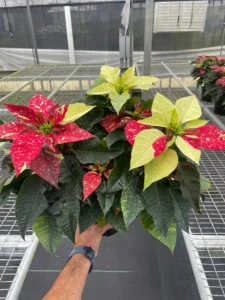
Origin: South America
Common Name(s): Poinsettia Red Glitter
About the Poinsettia Red Glitter
The Poinsettia 'Red Glitter' is a festive and vibrant variety of the traditional Poinsettia plant, known for its striking red bracts that are dusted with a sparkling, glittery effect, giving it a unique and eye-catching appearance. This seasonal favorite is commonly used to add a splash of holiday color to homes and offices. This plant is also known for its significant air purifying qualities such as removing toxins and producing oxygen.
Light
Bright, indirect light: Poinsettia Red Glitter thrives in bright, indirect light. Avoid direct sunlight, as it can scorch the leaves and damage the beautiful red patterns.
Water
Water regularly: Water when the top 1-2 inches of soil feel dry, typically every 3-4 days. Be sure to water thoroughly, allowing water to drain out of the pot. Reduce watering in winter when the plant is dormant.
Temperature & Humidity
Warm temperatures: Poinsettia Red Glitter prefers cool temperatures, ideally between 60-70°F (15-21°C) with moderate humidity.
How big will my plant grow?
It typically grows up to 12-18 inches, making an excellent addition to any indoor holiday decor or as a thoughtful gift.
Is this plant toxic for pets and kids?
Yes. Poinsettias are mildly toxic to pets (cats and dogs) if ingested, causing mild stomach upset. It's best to keep them out of reach of curious animals, especially if they tend to nibble on plants.
🌿 Additional Care Tips:
- Avoid drafts: Protect your Poinsettia from cold drafts, as they can cause leaf drop.
- Fertilize sparingly: Feed your Poinsettia with a balanced liquid fertilizer diluted to half strength once a month in the summer and spring.
- Monitor for pests: Keep an eye out for common houseplant pests like mealybugs and spider mites. Treat infestations promptly with insecticidal soap or neem oil.
- Pruning: After the holiday season, prune your Poinsettia to encourage new growth.
- Seasonal care: Poinsettia Red Glitter is a short-day plant, meaning it requires specific light conditions to bloom. To encourage reblooming, provide 12-14 hours of darkness each night for 5-6 weeks during the fall.

Origin: South America
Common Name(s): Poinsettia Red
About the Poinsettia Red
Poinsettia Red is the classic and most popular variety of the Poinsettia plant, widely known for its vibrant red bracts that resemble large, showy petals surrounding tiny, yellow flowers. This festive plant is a favorite during the holiday season, often used as decoration in homes and offices. This plant is also known for its significant air purifying qualities such as removing toxins and producing oxygen.
Light
Bright, indirect light: The Poinsettia Red loves basking in bright, indirect light. It’s perfect for a spot near a window with plenty of light but no direct sun, as that can scorch their vibrant red bracts.
Water
Water regularly: Water when the top 1-2 inches of soil feel dry, typically every 3-4 days. Be sure to water thoroughly, allowing water to drain out of the pot. Reduce watering in winter when the plant is dormant.
Temperature & Humidity
Warm temperatures: The Poinsettia Red prefers cool temperatures, ideally between 65-75°F (18-24°C) with moderate humidity.
How big will my plant grow?
It typically grows up to 12-18 inches, making it a perfect choice for tabletops, windowsills, and holiday displays.
Is this plant toxic for pets and kids?
Yes. Poinsettias are mildly toxic to pets (cats and dogs) if ingested, causing mild stomach upset. It's best to keep them out of reach of curious animals, especially if they tend to nibble on plants.
🌿 Additional Care Tips:
- Avoid drafts: Protect your Poinsettia from cold drafts, as they can cause leaf drop.
- Fertilize sparingly: Feed your Poinsettia with a balanced liquid fertilizer diluted to half strength once a month in the summer and spring.
- Monitor for pests: Keep an eye out for common houseplant pests like mealybugs and spider mites. Treat infestations promptly with insecticidal soap or neem oil.
- Pruning: After the holiday season, prune your Poinsettia to encourage new growth.
- Seasonal care: The Poinsettia Red is a short-day plant, meaning it requires specific light conditions to bloom. To encourage reblooming, provide 12-14 hours of darkness each night for 5-6 weeks during the fall.
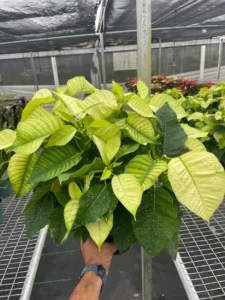
Origin: South America
Common Name(s): Poinsettia White
About the Poinsettia White
The Poinsettia White is an elegant variety of the classic Poinsettia, known for its crisp, white bracts that surround the tiny yellow flowers in the center. This variety offers a more subtle, sophisticated appearance compared to the traditional red Poinsettia and is often used in winter decor for a more serene, snowy look. It makes for the ultimate choice for display on tabletops, mantels, or windowsills. This plant is also known for its significant air purifying qualities such as removing toxins and producing oxygen.
Light
Bright, indirect light: Poinsettias thrives in bright, indirect light. Avoid direct sunlight, as it can scorch the leaves.
Water
Water regularly: Water when the top 1-2 inches of soil feel dry, typically every 3-4 days. Be sure to water thoroughly, allowing water to drain out of the pot. Reduce watering in winter when the plant is dormant.
Temperature & Humidity
Warm temperatures: Poinsettias prefers cool temperatures, ideally between 65-75°F (18-24°C) with moderate humidity.
How big will my plant grow?
It typically grows up to 12-18 inches, making it a perfect decorative choice for tabletops, windowsills, and holiday displays.
Is this plant toxic for pets and kids?
Yes. Poinsettias are mildly toxic to pets (cats and dogs) if ingested, causing mild stomach upset. It's best to keep them out of reach of curious animals, especially if they tend to nibble on plants.
🌿 Additional Care Tips:
- Avoid drafts: Protect your Poinsettia from cold drafts, as they can cause leaf drop.
- Fertilize sparingly: Feed your Poinsettia with a balanced liquid fertilizer diluted to half strength once a month in the summer and spring.
- Monitor for pests: Keep an eye out for common houseplant pests like mealybugs and spider mites. Treat infestations promptly with insecticidal soap or neem oil.
- Pruning: After the holiday season, prune your Poinsettia to encourage new growth.
- Seasonal care: Poinsettias are a short-day plants, meaning they requires specific light conditions to bloom. To encourage reblooming, provide 12-14 hours of darkness each night for 5-6 weeks during the fall.
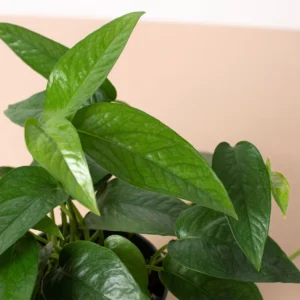
Origin: Philippines, Island of Cebu
Common Name(s): Cebu Blue Pothos
About the Pothos Cebu Blue
Pothos Cebu Blue is a stunning variety of the Pothos plant known for its unique, silvery-blue, heart-shaped leaves that add a touch of elegance to any space. The leaves have a slightly metallic sheen that glistens in the light, giving the plant a distinctive, striking appearance. This variety can be provided with support for climbing, or it can trail beautifully in hanging baskets. Cebu Blue Pothos is perfect for both beginners and experienced plant owners because it is easy to care for and adaptable to a variety of indoor conditions. This plant is also known for its significant air purifying qualities such as removing toxins, producing oxygen, and regulating indoor humidity levels.
Light
Bright, indirect light: Pothos plants thrive in bright, indirect light. Avoid direct sunlight, which can scorch their beautiful patterned leaves.
Water
Water weekly: When the top 1-2 inches of soil feel dry, typically, every 7-10 days, but always check the soil first. Avoid overwatering, as this can cause root rot. If the leaves start to yellow, you might be watering too much.
Temperature & Humidity
Warm temperatures: Pothos prefer cool temperatures, ideally between 65-75°F (18-24°C) with moderate-to-high humidity.
How big will my plant grow?
It typically grows up to 6-10 feet, making it ideal for pole support and indoor structures for climbing.
Is this plant toxic for pets and kids?
Yes. The Pothos Cebu Blue is toxic to pets (cats and dogs) if ingested, causing symptoms such as vomiting, drooling, and oral irritation. Keep this plant out of reach of curious pets to avoid any health issues.
🌿 Additional Care Tips:
- Fertilize regularly: Feed your plant with a balanced liquid fertilizer diluted to half strength every 3-6 weeks during the growing season (spring and summer).
- Monitor for pests: While Pothos plants are relatively pest-resistant, they're not immune. Keep an eye out for spider mites, aphids, or mealybugs. If you spot any pests, treat the plant with neem oil or insecticidal soap. Wipe the leaves down regularly to keep them clean and shiny.
- Provide support: As the plant grows, it may require a moss pole or trellis to support its vining growth.
- Be patient: Pothos plants are relatively slow growers, so don't be discouraged if they don't grow rapidly.
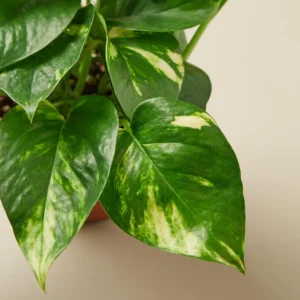
Origin: Southeast Asia
Common Name(s): Golden Pothos, Devil’s Ivy
About the Pothos Golden Devil’s Ivy
The Pothos Golden is one of the most popular and easy-to-care-for houseplants. This variety is renowned for its heart-shaped leaves that are a vibrant mix of deep green and bright golden-yellow variegation. Golden Pothos are perfect for hanging baskets, shelves, or as a climber on a trellis. Its attractive foliage and resilience to varying conditions make it an ideal plant for both beginners and experienced plant owners. This plant is also well known for its significant air purifying qualities such as removing toxins, producing oxygen, and regulating indoor humidity levels.
Light
Bright, indirect light: Pothos plants thrive in bright, indirect light. Avoid direct sunlight, which can scorch their beautiful patterned leaves.
Water
Water weekly: When the top 1-2 inches of soil feel dry, typically, every 7-10 days, but always check the soil first. Avoid overwatering, as this can cause root rot. If the leaves start to yellow, you might be watering too much.
Temperature & Humidity
Warm temperatures: Pothos prefer cool temperatures, ideally between 65-75°F (18-24°C) with moderate-to-high humidity.
How big will my plant grow?
It typically grows up to 10 feet, making it ideal for pole support, trellis, indoor structures for climbing, and hanging baskets.
Is this plant toxic for pets and kids?
Yes. This plant is toxic to pets (cats and dogs) if ingested, causing symptoms such as vomiting, drooling, and oral irritation. Keep this plant out of reach of curious pets to avoid any health issues.
🌿 Additional Care Tips:
- Fertilize regularly: Feed your plant with a balanced liquid fertilizer diluted to half strength every 3-6 weeks during the growing season (spring and summer).
- Monitor for pests: While Pothos plants are relatively pest-resistant, they're not immune. Keep an eye out for spider mites, aphids, or mealybugs. If you spot any pests, treat the plant with neem oil or insecticidal soap. Wipe the leaves down regularly to keep them clean and shiny.
- Provide support: As the plant grows, it may require a moss pole or trellis to support its vining growth.
- Be patient: Pothos plants are relatively slow growers, so don't be discouraged if they don't grow rapidly.
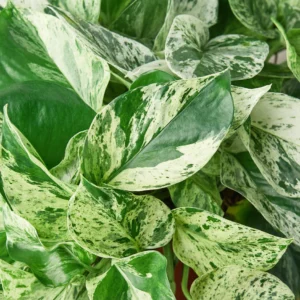
Origin: Southeast Asia
Common Name(s): Marble Queen Pothos
About the Pothos Marble Queen
The Pothos Marble Queen is a stunning variety of Pothos known for its beautiful, variegated leaves that feature a marbled pattern of creamy white and green. The striking contrast of colors makes it a standout plant in any indoor space, whether it’s used as a trailing vine, hanging plant, or climbing on a support. Like other Pothos varieties, Marble Queen is a low-maintenance plant that thrives in various conditions, making it perfect for beginners or anyone looking to add a touch of greenery with minimal effort. This plant is also well known for its significant air purifying qualities such as removing toxins, producing oxygen, and regulating indoor humidity levels.
Light
Bright, indirect light: Pothos plants thrive in bright, indirect light. Avoid direct sunlight, which can scorch their beautiful patterned leaves.
Water
Water weekly: When the top 1-2 inches of soil feel dry, typically, every 7-10 days, but always check the soil first. Avoid overwatering, as this can cause root rot. If the leaves start to yellow, you might be watering too much.
Temperature & Humidity
Warm temperatures: Pothos prefer cool temperatures, ideally between 65-75°F (18-24°C) with moderate-to-high humidity.
How big will my plant grow?
It typically grows up to 6-10 feet, making it ideal for pole support, indoor structures for climbing, hanging baskets, and shelves.
Is this plant toxic for pets and kids?
Yes. This plant is toxic to pets (cats and dogs) if ingested, causing symptoms such as vomiting, drooling, and oral irritation. Keep this plant out of reach of curious pets to avoid any health issues.
🌿 Additional Care Tips:
- Fertilize regularly: Feed your plant with a balanced liquid fertilizer diluted to half strength every 3-6 weeks during the growing season (spring and summer).
- Monitor for pests: While Pothos plants are relatively pest-resistant, they're not immune. Keep an eye out for spider mites, aphids, or mealybugs. If you spot any pests, treat the plant with neem oil or insecticidal soap. Wipe the leaves down regularly to keep them clean and shiny.
- Provide support: As the plant grows, it may require a moss pole or trellis to support its vining growth.
- Be patient: Pothos plants are relatively slow growers, so don't be discouraged if they don't grow rapidly.

Origin: Southeast Asia
Common Name(s): Neon Pothos
About the Pothos Neon
The Pothos Neon is a vibrant and eye-catching variety of the classic Pothos, known for its bright, lime-green leaves that can add a pop of color to any space. The striking neon yellow-green hue of its heart-shaped leaves makes it a standout plant in any room, whether it's climbing a trellis or trailing from a hanging basket. Neon Pothos is a fast-growing, easy-care plant that thrives in a variety of conditions, making it perfect for both beginners and experienced plant owners. This plant is well known for its significant air purifying qualities such as removing toxins, producing oxygen, and regulating indoor humidity levels.
Light
Bright, indirect light: Pothos plants thrive in bright, indirect light. Avoid direct sunlight, which can scorch their beautiful patterned leaves.
Water
Water weekly: When the top 1-2 inches of soil feel dry, typically, every 7-10 days, but always check the soil first. Avoid overwatering, as this can cause root rot. If the leaves start to yellow, you might be watering too much.
Temperature & Humidity
Warm temperatures: Pothos prefer cool temperatures, ideally between 65-75°F (18-24°C) with moderate-to-high humidity.
How big will my plant grow?
It typically grows up to 6-10 feet, making it ideal for pole support, indoor structures for climbing, hanging baskets, and shelves.
Is this plant toxic for pets and kids?
Yes. This plant is toxic to pets (cats and dogs) if ingested, causing symptoms such as vomiting, drooling, and oral irritation. Keep this plant out of reach of curious pets to avoid any health issues.
🌿 Additional Care Tips:
- Fertilize regularly: Feed your plant with a balanced liquid fertilizer diluted to half strength every 3-6 weeks during the growing season (spring and summer).
- Monitor for pests: While Pothos plants are relatively pest-resistant, they're not immune. Keep an eye out for spider mites, aphids, or mealybugs. If you spot any pests, treat the plant with neem oil or insecticidal soap. Wipe the leaves down regularly to keep them clean and shiny.
- Provide support: As the plant grows, it may require a moss pole or trellis to support its vining growth.
- Be patient: Pothos plants are relatively slow growers, so don't be discouraged if they don't grow rapidly.
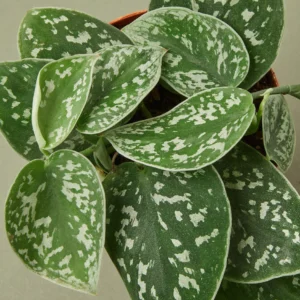
Origin: Southeast Asia
Common Name(s): Satin Pothos, Silk Pothos
About the Pothos Satin
The Pothos Satin is a visually striking variety of the popular Pothos plant, celebrated for its elegant, silvery-green variegated leaves that have a glossy, satin-like finish. The shimmering foliage adds a touch of sophistication to any space, making it an attractive choice for both home decor and office environments. As a fast-growing vine, this plant ideal for hanging baskets, shelves, or as a cascading floor plant. This plant is also known for its significant air purifying qualities such as removing toxins, producing oxygen, and regulating indoor humidity levels.
Light
Bright, indirect light: Pothos plants thrive in bright, indirect light. Avoid direct sunlight, which can scorch their beautiful patterned leaves.
Water
Water weekly: When the top 1-2 inches of soil feel dry, typically, every 7-10 days, but always check the soil first. Avoid overwatering, as this can cause root rot. If the leaves start to yellow, you might be watering too much.
Temperature & Humidity
Warm temperatures: Pothos prefer cool temperatures, ideally between 65-75°F (18-24°C) with moderate-to-high humidity.
How big will my plant grow?
It typically grows up to 6-10 feet, making it ideal for pole support, indoor structures for climbing, hanging baskets, and shelves.
Is this plant toxic for pets and kids?
Yes. This plant is toxic to pets (cats and dogs) if ingested, causing symptoms such as vomiting, drooling, and oral irritation. Keep this plant out of reach of curious pets to avoid any health issues.
🌿 Additional Care Tips:
- Fertilize regularly: Feed your plant with a balanced liquid fertilizer diluted to half strength every 3-6 weeks during the growing season (spring and summer).
- Monitor for pests: While Pothos plants are relatively pest-resistant, they're not immune. Keep an eye out for spider mites, aphids, or mealybugs. If you spot any pests, treat the plant with neem oil or insecticidal soap. Wipe the leaves down regularly to keep them clean and shiny.
- Provide support: As the plant grows, it may require a moss pole or trellis to support its vining growth.
- Be patient: Pothos plants are relatively slow growers, so don't be discouraged if they don't grow rapidly.
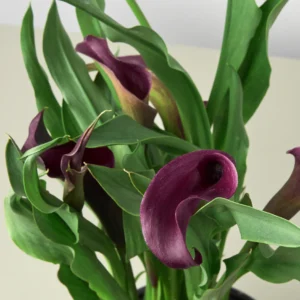
Origin: South Africa
Common Name(s): Purple Calla Lily
About the Purple Calla Lily
The Purple Calla Lily, known for its stunning, deep purple flowers, is a striking variety of the Calla Lily that adds elegance and a pop of color to any space. Its tall, slender stems support the signature funnel-shaped blooms, which emerge in rich, velvety shades of purple. Calla lilies are commonly associated with grace and beauty, making them an excellent choice for enhancing both indoor and outdoor gardens. This plant is also well known for its significant air purifying qualities such as removing toxins, producing oxygen, and regulating indoor humidity levels.
Light
Bright, indirect light: Purple Calla Lilies thrive in bright, indirect light. Avoid direct sunlight, as it can scorch the leaves and flowers.
Water
Water regularly: Every 5-7 days, while in cooler months, reduce watering frequency. Ensure the pot has good drainage.
Temperature & Humidity
Warm temperatures: Purple Calla Lilies prefer warm temperatures, ideally between 65-75°F (18-24°C) with moderate humidity.
How big will my plant grow?
It typically grows up to about 18 to 30 inches (45–75 cm) in height, depending on the growing conditions.
Is this plant toxic for pets and kids?
Yes. This plant is toxic to pets (cats and dogs) if ingested, causing symptoms such as vomiting, drooling, and oral irritation. Always ensure it is placed in a safe location.
🌿 Additional Care Tips:
- Fertilize regularly: Feed your plant with a balanced liquid fertilizer diluted to half strength every 2-4 weeks during the growing season.
- Monitor for pests: Keep an eye out for common houseplant pests like mealybugs and spider mites. Treat infestations promptly with insecticidal soap or neem oil.
- Repot as needed: Repot your Purple Calla Lily every 1-2 years in a slightly larger pot with fresh, well-draining potting mix.
- Provide adequate drainage: Ensure the pot has drainage holes to prevent waterlogging.
- Dormancy period: After flowering, the plant may enter a dormant period of slower or no growth. During this time, reduce watering and move the plant to a cooler location.
S
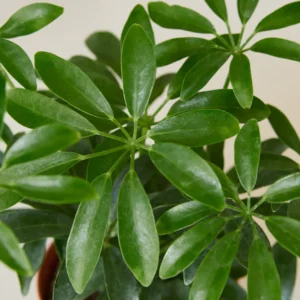
Origin: Taiwan
Common Name(s): Umbrella Tree, Dwarf Umbrella Tree
About the Schefflera Arboricola Umbrella Tree
This Umbrella tree is a popular houseplant characterized by its distinctive, umbrella-like leaf clusters. Each leaf is composed of several glossy, deep green leaflets that radiate outward from a central point, resembling the shape of an umbrella. This attractive, easy-care plant adds a touch of tropical greenery to any home or office space. This plant is also known for its air purifying qualities such as removing toxins from the air, producing oxygen, and regulating indoor humidity levels.
Light
Bright, indirect light: Schefflera thrive in bright, indirect light. Avoid direct sunlight, which can scorch their beautiful patterned leaves. The leaves really pops under good light, so the more bright, filtered sunlight it gets, the better.
Water
Water regularly: Every 7-10 days, but always check the soil first. During the winter, you can cut back on watering, as the plant’s growth slows.
Temperature & Humidity
Warm temperatures: Schefflera prefer cool temperatures, ideally between 65-75°F (18-24°C) with low-to-moderate humidity.
How big will my plant grow?
It typically grows to a height of about 6 to 10 feet when it is allowed to grow in its compact form. It is usually pruned to remain compact.
Is this plant toxic for pets and kids?
Yes. This Schefflera is mildly toxic to pets (cats and dogs) if ingested, causing symptoms such as drooling, vomiting, or lack of appetite. It is recommended to keep the plant out of reach of pets to avoid any health concerns.
🌿 Additional Care Tips:
- Fertilize regularly: Feed with a balanced liquid fertilizer once a month during the growing season (spring and summer). During the fall and winter months, stop fertilizing as the plant is dormant and not actively growing.
- Monitor for pests: While not overly susceptible to pests, Schefflera can occasionally attract spider mites, mealybugs, or scale. Keep an eye out for any infestations and treat with neem oil or insecticidal soap. Cleaning the leaves with a damp cloth helps to prevent dust buildup and deter pests.
- Pruning: Prune your Schefflera regularly to promote healthy growth.
- Repot as needed: Repot your Schefflera every 2-3 years in a slightly larger pot with fresh, well-draining potting mix. Choose a pot that’s only 1-2 inches larger in diameter than the current one to avoid water retention issues.
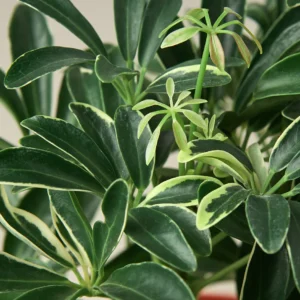
Origin: The Pacific Islands
Common Name(s): Moonlight Schefflera, Dwarf Umbrella Tree
About the Schefflera Moonlight
The Schefflera Moonlight is known for its vibrant, bright yellow and green variegated leaves. The foliage appears almost glowing, with the lighter yellow tones contrasting beautifully against the deep green centers of the leaves. This compact, easy-to-care for shrub-like plant features an elegant, umbrella-like leaf pattern, making it an eye-catching addition to any home or office space. This plant is also known for its air purifying qualities such as removing toxins from the air, producing oxygen, and regulating indoor humidity levels.
Light
Bright, indirect light: Schefflera thrive in bright, indirect light. Avoid direct sunlight, which can scorch their beautiful patterned leaves. The leaves really pops under good light, so the more bright, filtered sunlight it gets, the better.
Water
Water regularly: Every 7-10 days, but always check the soil first. During the winter, you can cut back on watering, as the plant’s growth slows.
Temperature & Humidity
Warm temperatures: Schefflera prefer cool temperatures, ideally between 65-75°F (18-24°C) with low-to-moderate humidity.
How big will my plant grow?
It typically grows to a height of about 3 to 4 feet when it is allowed to grow in its compact form.
Is this plant toxic for pets and kids?
Yes. This Schefflera is mildly toxic to pets (cats and dogs) if ingested, causing symptoms such as drooling, vomiting, or lack of appetite. It is recommended to keep the plant out of reach of pets to avoid any health concerns.
🌿 Additional Care Tips:
- Fertilize regularly: Feed with a balanced liquid fertilizer once a month during the growing season (spring and summer). During the fall and winter months, stop fertilizing as the plant is dormant and not actively growing.
- Monitor for pests: While not overly susceptible to pests, Schefflera can occasionally attract spider mites, mealybugs, or scale. Keep an eye out for any infestations and treat with neem oil or insecticidal soap. Cleaning the leaves with a damp cloth helps to prevent dust buildup and deter pests.
- Pruning: Prune your Schefflera regularly to promote healthy growth.
- Repot as needed: Repot your Schefflera every 2-3 years in a slightly larger pot with fresh, well-draining potting mix. Choose a pot that’s only 1-2 inches larger in diameter than the current one to avoid water retention issues.
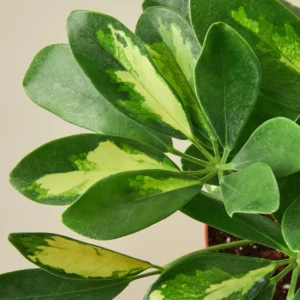
Origin: The Pacific Islands
Common Name(s): Variegated Schefflera, Dwarf Umbrella Tree
About the Schefflera Variegated
Schefflera Variegated, also known as the Dwarf Umbrella Tree, is a visually striking plant with glossy, variegated leaves that feature a mix of dark green and cream or yellowish-white edges. This compact shrub is known for its attractive, umbrella-shaped clusters of leaves that make it a popular choice for homes and offices. It’s an easy-to-care-for plant, thriving in moderate to bright, indirect light and providing a bold yet elegant touch to your space. This plant is also known for its air purifying qualities such as removing toxins from the air, producing oxygen, and regulating indoor humidity levels.
Light
Bright, indirect light: Schefflera thrive in bright, indirect light. Avoid direct sunlight, which can scorch their beautiful patterned leaves. The leaves really pops under good light, so the more bright, filtered sunlight it gets, the better.
Water
Water regularly: Every 7-10 days, but always check the soil first. During the winter, you can cut back on watering, as the plant’s growth slows.
Temperature & Humidity
Warm temperatures: Schefflera prefer cool temperatures, ideally between 65-75°F (18-24°C) with low-to-moderate humidity.
How big will my plant grow?
It typically grows to a height of about 3 to 4 feet when it is allowed to grow in its compact form.
Is this plant toxic for pets and kids?
Yes. The Schefflera Variegated is mildly toxic to pets (cats and dogs) if ingested, causing symptoms such as drooling, vomiting, or lack of appetite. It is recommended to keep the plant out of reach of pets to avoid any health concerns.
🌿 Additional Care Tips:
- Fertilize regularly: Feed with a balanced liquid fertilizer once a month during the growing season (spring and summer). During the fall and winter months, stop fertilizing as the plant is dormant and not actively growing.
- Monitor for pests: While not overly susceptible to pests, Schefflera can occasionally attract spider mites, mealybugs, or scale. Keep an eye out for any infestations and treat with neem oil or insecticidal soap. Cleaning the leaves with a damp cloth helps to prevent dust buildup and deter pests.
- Pruning: Prune your Schefflera regularly to promote healthy growth.
- Repot as needed: Repot your Schefflera every 2-3 years in a slightly larger pot with fresh, well-draining potting mix. Choose a pot that’s only 1-2 inches larger in diameter than the current one to avoid water retention issues.
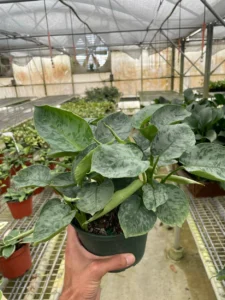
Origin: Southeast Asia
Common Name(s): Sarawak Schismatoglottis
About the Schismatoglottis Sarawak
The Schismatoglottis Sarawak is a unique tropical plant with lush, velvety foliage that has become a favorite among collectors for its exotic look and easygoing nature. This plant boasts elongated, lance-shaped leaves with silvery-green patterns on a dark green background, giving it a striking, almost metallic appearance. Sarawak Schismatoglottis is ideal for adding a touch of the tropics to your indoor plant collection. It is also known for its strong air purifying qualities such as producing oxygen, removing toxins from the air, and regulating indoor humidity levels.
Light
Bright, indirect light: The Schismatoglottis Sarawak prefers bright, indirect light to maintain its striking leaf pattern, though it can tolerate low light as well. Avoid direct sunlight, as it can scorch the delicate leaves and cause their colors to fade.
Water
Water regularly: Keep the soil evenly moist but not waterlogged. Water when the top 1-2 inches of soil feel dry, typically every 5-7 days in warmer months. In winter, allow the soil to dry out a bit more between waterings.
Temperature & Humidity
Warm temperatures: This tropical plant loves warmth and high humidity. Aim for temperatures between 65-80°F (18-27°C) and maintain humidity levels around 60% or higher. Use a humidifier or humidity tray if your indoor air is dry.
How big will my plant grow?
It typically grows to a height of about 18 to 24 inches (45-60 cm). However, under optimal conditions, it may occasionally reach 30 inches (75 cm) or more. It can spread similarly to its height, with a bushy or clumping growth habit; very attractive clump of leaves.
Is this plant toxic for pets and kids?
Yes. This variety is mildly toxic to pets (cats and dogs) if ingested, causing symptoms such as mouth irritation, drooling, or vomiting. Keep it out of reach of curious pets to avoid any potential health issues.
🌿 Additional Care Tips:
- Fertilize regularly: Feed your plant with a balanced liquid fertilizer diluted to half strength every 4 weeks during the growing season (spring and summer).
- Monitor for pests: Keep an eye out for common houseplant pests like mealybugs and spider mites. Treat infestations promptly with insecticidal soap or neem oil.
- Repot as needed: Repot your Schismatoglottis Sarawak every 1-2 years in a slightly larger pot with fresh, well-draining potting mix.
- Avoid cold drafts: Protect your Schismatoglottis Sarawak from cold drafts, as they can damage the plant.
- Provide adequate drainage: Ensure the pot has drainage holes to prevent waterlogging.
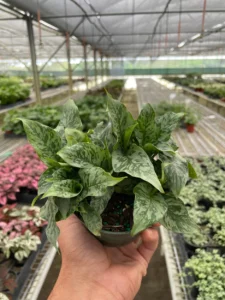
Origin: Southeast Asia
Common Name(s): Thailand Schismatoglottis
About the Schismatoglottis Thailand
Schismatoglottis Thailand is an elegant tropical plant prized for its striking, dark green foliage accented by unique silver patterns. Native to the lush forests of Thailand, this plant brings an exotic touch to indoor spaces and makes an excellent addition for plant enthusiasts looking for something distinct. This easy-care plant is well-suited to low-light environments, making it ideal for adding greenery to rooms with limited natural light. It is also known for its strong air purifying qualities such as producing oxygen, removing toxins from the air, and regulating indoor humidity levels.
Light
Bright, indirect light: The Schismatoglottis Thailand prefers bright, indirect light to maintain its striking leaf pattern, though it can tolerate low light as well. Avoid direct sunlight, as it can scorch the delicate leaves and cause their colors to fade.
Water
Water regularly: Keep the soil evenly moist but not waterlogged. Water when the top 1-2 inches of soil feel dry, typically every 5-7 days in warmer months. In winter, allow the soil to dry out a bit more between waterings.
Temperature & Humidity
Warm temperatures: This tropical plant loves warmth and high humidity. Aim for temperatures between 65-80°F (18-27°C) and maintain humidity levels around 60% or higher. Use a humidifier or humidity tray if your indoor air is dry.
How big will my plant grow?
It typically grows to a height of about 18 to 24 inches (45 -60 cm). It can spread similarly to its height, with a bushy or clumping growth habit; very attractive clump of leaves.
Is this plant toxic for pets and kids?
Yes. This variety is mildly toxic to pets (cats and dogs) if ingested, causing symptoms such as mouth irritation, drooling, or vomiting. Keep it out of reach of curious pets to avoid any potential health issues.
🌿 Additional Care Tips:
- Fertilize regularly: Feed your plant with a balanced liquid fertilizer diluted to half strength every 4 weeks during the growing season (spring and summer).
- Monitor for pests: Keep an eye out for common houseplant pests like mealybugs and spider mites. Treat infestations promptly with insecticidal soap or neem oil.
- Repot as needed: Repot your Schismatoglottis Thailand every 1-2 years in a slightly larger pot with fresh, well-draining potting mix.
- Avoid cold drafts: Protect your Schismatoglottis Thailand from cold drafts, as they can damage the plant.
- Provide adequate drainage: Ensure the pot has drainage holes to prevent waterlogging.
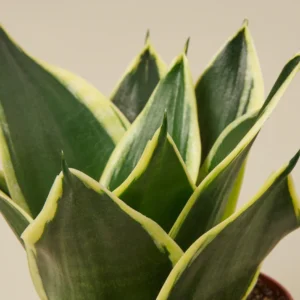
Origin: Africa
Common Name(s): Black Gold Snake Plant, Mother-in-Law’s Tongue
About the Snake Plant Black Gold
The Black Gold Snake Plant is a stunning, low-maintenance plant that adds a touch of elegance to any indoor space with its tall, sword-like leaves. Known for their dark green centers with contrasting golden-yellow leaf margins, Black Gold Snake Plants are both visually striking and incredibly hardy. This variety is perfect for plant owners of all experience levels. It is also known for its strong air purifying qualities such as producing oxygen, removing toxins from the air, and regulating indoor humidity levels.
Light
Bright, indirect light: Snake Plants prefers bright, indirect light and can tolerate some direct sun, especially in the morning or late afternoon. Place it near a sunny window for optimal growth. Low light conditions are tolerated, but yields slower growth.
Water
Water regularly: Snake plants are very drought-tolerant. Keep the soil evenly moist but not waterlogged. Water when the top 1-2 inches of soil feel dry, typically every 5-7 days in warmer months. In winter, allow the soil to dry out a bit more between waterings.
Temperature & Humidity
Warm temperatures: Snake plants prefer warm temperatures, ideally between 65-75°F (18-24°C) with low-to-moderate humidity.
How big will my plant grow?
It typically grows to a height of about 2 to 3 feet (60 to 90 cm), though in optimal conditions, it may reach up to 4 feet (1.2 meters).
Is this plant toxic for pets and kids?
Yes. This variety is mildly toxic to pets (cats and dogs) if ingested, causing symptoms such as mouth irritation, drooling, or vomiting. Keep it out of reach of curious pets to avoid any potential health issues.
🌿 Additional Care Tips:
- Fertilize sparingly: Feed your snake plant with a balanced liquid fertilizer diluted to half strength once or twice a year during the spring and or summer.
- Repot infrequently: Repot your snake plant only when it becomes root-bound. Use a well-draining cactus or succulent potting mix.
- Tolerant of neglect: Snake plants are very forgiving and can tolerate periods of neglect, but generally the more care - they look healthier and more beautiful.
- Propagation: Snake plants are easy to propagate through leaf cuttings or stem cuttings. Simply cut a healthy leaf or stem and place it in a pot with well-draining soil. Keep the soil slightly moist and in a warm, bright location.
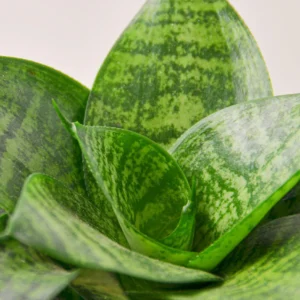
Origin: Africa
Common Name(s): Black Robusta Snake Plant, Forest Star Snake Plant
About the Snake Plant Black Robusta Forest Star
The Black Robusta Snake Plant is an elegant and resilient houseplant, distinguished by its deep, dark green foliage with subtle silver-gray markings. With its compact and upright growth, Black Robusta is perfect for adding a sleek, contemporary touch to any space. This hardy plant is incredibly low-maintenance and is ideal for beginner plant owners or those with busy lifestyles. It is also known for its strong air purifying qualities such as producing oxygen, removing toxins from the air, and regulating indoor humidity levels.
Light
Bright, indirect light: Snake Plants prefers bright, indirect light and can tolerate some direct sun, especially in the morning or late afternoon. Place it near a sunny window for optimal growth. Low light conditions are tolerated, but yields slower growth.
Water
Water regularly: Snake plants are very drought-tolerant. Keep the soil evenly moist but not waterlogged. Water when the top 1-2 inches of soil feel dry, typically every 5-7 days in warmer months. In winter, allow the soil to dry out a bit more between waterings.
Temperature & Humidity
Warm temperatures: Snake plants prefer warm temperatures, ideally between 65-75°F (18-24°C) with low-to-moderate humidity.
How big will my plant grow?
It typically grows to a height of about 2 to 3 feet (60 to 90 cm), though in optimal conditions, it may reach up to 4 feet (1.2 meters).
Is this plant toxic for pets and kids?
Yes. This variety is mildly toxic to pets (cats and dogs) if ingested, causing symptoms such as mouth irritation, drooling, or vomiting. Keep it out of reach of curious pets to avoid any potential health issues.
🌿 Additional Care Tips:
- Fertilize sparingly: Feed your snake plant with a balanced liquid fertilizer diluted to half strength once or twice a year during the spring and or summer.
- Repot infrequently: Repot your snake plant only when it becomes root-bound. Use a well-draining cactus or succulent potting mix.
- Tolerant of neglect: Snake plants are very forgiving and can tolerate periods of neglect, but generally the more care - they look healthier and more beautiful.
- Propagation: Snake plants are easy to propagate through leaf cuttings or stem cuttings. Simply cut a healthy leaf or stem and place it in a pot with well-draining soil. Keep the soil slightly moist and in a warm, bright location.
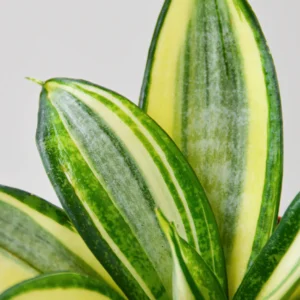
Origin: Africa
Common Name(s): Gold Hahnii Snake Plant, Bird’s Nest Snake Plant
About the Snake Plant Gold Hahnii
The Gold Hahnii Snake Plant is a compact, rosette-forming variety known for its beautiful golden-yellow edges and green, variegated leaves. With its shorter, clumping growth habit, it resembles a bird’s nest, making it a unique and attractive addition to tabletops, shelves, or windowsills. It is very well known for its strong air purifying qualities such as producing oxygen, removing toxins from the air, and regulating indoor humidity levels.
Light
Bright, indirect light: Snake Plants prefers bright, indirect light and can tolerate some direct sun, especially in the morning or late afternoon. Place it near a sunny window for optimal growth. Low light conditions are tolerated, but yields slower growth.
Water
Water regularly: Snake plants are very drought-tolerant. Keep the soil evenly moist but not waterlogged. Water when the top 1-2 inches of soil feel dry, typically every 5-7 days in warmer months. In winter, allow the soil to dry out a bit more between waterings.
Temperature & Humidity
Warm temperatures: Snake plants prefer warm temperatures, ideally between 65-75°F (18-24°C) with low-to-moderate humidity.
How big will my plant grow?
It typically grows to a height of about 2 to 3 feet (60 to 90 cm), though in optimal conditions, it may reach up to 4 feet (1.2 meters).
Is this plant toxic for pets and kids?
Yes. This variety is mildly toxic to pets (cats and dogs) if ingested, causing symptoms such as mouth irritation, drooling, or vomiting. Keep it out of reach of curious pets to avoid any potential health issues.
🌿 Additional Care Tips:
- Fertilize sparingly: Feed your snake plant with a balanced liquid fertilizer diluted to half strength once or twice a year during the spring and or summer.
- Repot infrequently: Repot your snake plant only when it becomes root-bound. Use a well-draining cactus or succulent potting mix.
- Tolerant of neglect: Snake plants are very forgiving and can tolerate periods of neglect, but generally the more care - they look healthier and more beautiful.
- Propagation: Snake plants are easy to propagate through leaf cuttings or stem cuttings. Simply cut a healthy leaf or stem and place it in a pot with well-draining soil. Keep the soil slightly moist and in a warm, bright location.
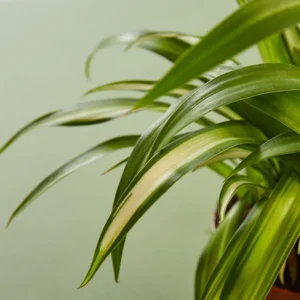
Origin: Southern Africa
Common Name(s): Hawaiian Spider Plant
About the Spider Plant Hawaiian
The Hawaiian Spider Plant is a striking variety of the popular Spider Plant, known for its bold green leaves with creamy white variegation that forms a stunning contrast. Its long, arching leaves and spider-like offshoots, or "spiderettes," give it a cascading appearance, making it an ideal choice for hanging baskets or as a decorative tabletop plant. Like its counterparts, the Hawaiian Spider Plant is easy to care for, making it perfect for plant beginners. It is unique in that it has strong air purifying qualities such as producing oxygen, removing toxins from the air, and regulating indoor humidity levels.
Light
Bright, indirect light: The Spider Plant Hawaiian thrives in bright, indirect light. While it can tolerate low light, its striking green and white variegation is most vibrant when exposed to moderate to bright, filtered light. Direct sunlight can scorch its leaves, so it's best to keep it out of harsh sun.
Water
Water regularly: Typically, this means watering every 7-10 days, but always check the soil moisture first. Allow the plant to drain well, as standing water can lead to root rot. In winter, reduce watering to allow the plant to rest.
Temperature & Humidity
Warm temperatures: The Spider Plant Hawaiian prefers temperatures between 60-75°F (16-24°C). It is adaptable to average indoor humidity levels, but it will appreciate occasional misting or being placed on a humidity tray in drier climates.
How big will my plant grow?
The plant itself typically grows to about 12 to 15 inches (30-38 cm) tall. However, it can spread much wider as the leaves arch outward, creating a bushy effect.
Is this plant toxic for pets and kids?
No. This Spider plant is non-toxic to pets (cats and dogs), making it a safe choice for households with curious animals.
🌿 Additional Care Tips:
- Fertilize regularly: Feed your plant with a balanced liquid fertilizer diluted to half strength every 4 weeks during spring and summer.
- Monitor for pests: Keep an eye out for common houseplant pests like mealybugs and spider mites. Treat infestations promptly with insecticidal soap or neem oil.
- Repot as needed: Repot Spider Plants every 1-2 years in a slightly larger pot with fresh, well-draining potting mix.
- Propagation: Spider Plants can be easily propagated through plantlets or division.
- Low-maintenance: Spider Plants are a low-maintenance and are perfect for beginners.
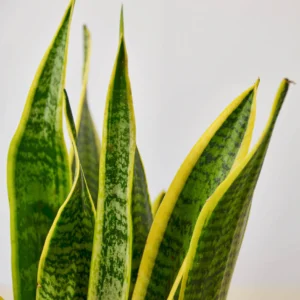
Origin: Africa
Common Name(s): Laurentii Snake Plant, Mother-in-Law's Tongue
About the Snake Plant Laurentii
The Laurentii Snake Plant is one of the most popular varieties of Sansevieria, known for its striking appearance and exceptional ease of care. With its tall, sword-shaped leaves that feature dark green centers and bright yellow margins, Laurentii is perfect for adding a dramatic, modern touch to any indoor space. Its architectural form and low-maintenance nature make it ideal for beginners or busy plant owners. It is very well known for its strong air purifying qualities such as producing oxygen, removing toxins from the air, and regulating indoor humidity levels.
Light
Bright, indirect light: Snake Plants prefers bright, indirect light and can tolerate some direct sun, especially in the morning or late afternoon. Place it near a sunny window for optimal growth. Low light conditions are tolerated, but yields slower growth.
Water
Water regularly: Snake plants are very drought-tolerant. Keep the soil evenly moist but not waterlogged. Water when the top 1-2 inches of soil feel dry, typically every 5-7 days in warmer months. In winter, allow the soil to dry out a bit more between waterings.
Temperature & Humidity
Warm temperatures: Snake plants prefer warm temperatures, ideally between 65-75°F (18-24°C) with low-to-moderate humidity.
How big will my plant grow?
It typically grows to a height of about 2 to 3 feet (60 to 90 cm), though in optimal conditions, it may reach up to 4 feet (1.2 meters).
Is this plant toxic for pets and kids?
Yes. This variety is mildly toxic to pets (cats and dogs) if ingested, causing symptoms such as mouth irritation, drooling, or vomiting. Keep it out of reach of curious pets to avoid any potential health issues.
🌿 Additional Care Tips:
- Fertilize sparingly: Feed your snake plant with a balanced liquid fertilizer diluted to half strength once or twice a year during the spring and or summer.
- Repot infrequently: Repot your snake plant only when it becomes root-bound. Use a well-draining cactus or succulent potting mix.
- Tolerant of neglect: Snake plants are very forgiving and can tolerate periods of neglect, but generally the more care - they look healthier and more beautiful.
- Propagation: Snake plants are easy to propagate through leaf cuttings or stem cuttings. Simply cut a healthy leaf or stem and place it in a pot with well-draining soil. Keep the soil slightly moist and in a warm, bright location.
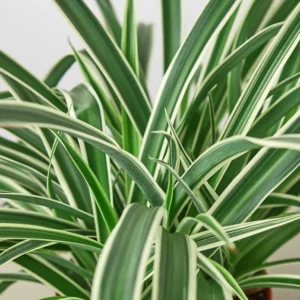
Origin: Southern Africa
Common Name(s): Reverse Spider Plant, Variegated Spider Plant
About the Spider Plant Reverse
The Reverse Spider Plant is a beautiful and unique variety of the classic Spider Plant, known for its striking foliage that features green leaves with creamy white margins, creating a reverse effect compared to the traditional variety. This fast-growing plant is perfect for adding a touch of elegance and greenery to any space, with its cascading leaves and offshoots that resemble "spiderettes." It is very well known for its strong air purifying qualities such as producing oxygen, removing toxins from the air, and regulating indoor humidity levels.
Light
Bright, indirect light: Spider Plant Reverse thrives in bright, indirect light. It can also tolerate low to moderate light, though the vibrant variegation may fade with too little light. Avoid direct sunlight, as it can scorch the leaves and damage the plant’s appearance.
Water
Water regularly: Typically, this means watering every 7-10 days, but always check the soil moisture first. Allow the plant to drain well, as standing water can lead to root rot. In winter, reduce watering to allow the plant to rest.
Temperature & Humidity
Warm temperatures: Spider Plant Reverse prefers temperatures between 60-75°F (16-24°C). It is adaptable to average indoor humidity levels, but it will appreciate occasional misting or being placed on a humidity tray in drier climates.
How big will my plant grow?
The plant itself typically grows to about 12 to 15 inches (30-38 cm) tall. However, it can spread much wider as the leaves arch outward, creating a bushy effect.
Is this plant toxic for pets and kids?
No. This Spider plant is non-toxic to pets (cats and dogs), making it a safe choice for households with curious animals.
🌿 Additional Care Tips:
- Fertilize regularly: Feed your plant with a balanced liquid fertilizer diluted to half strength every 4 weeks during spring and summer.
- Monitor for pests: Keep an eye out for common houseplant pests like mealybugs and spider mites. Treat infestations promptly with insecticidal soap or neem oil.
- Repot as needed: Repot Spider Plants every 1-2 years in a slightly larger pot with fresh, well-draining potting mix.
- Propagation: Spider Plants can be easily propagated through plantlets or division.
- Low-maintenance: Spider Plants are a low-maintenance and are perfect for beginners.
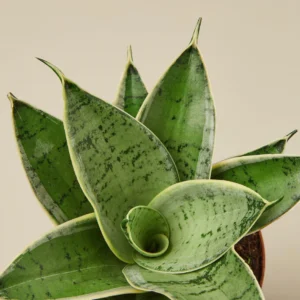
Origin: Africa
Common Name(s): Starlight Snake Plant, Silver Star Snake Plant
About the Snake Plant Starlight
The Starlight Snake Plant is a beautiful and rare variety of Sansevieria, known for its unique, silver-toned leaves accented with subtle dark green patterns. With its upright, sword-shaped foliage, this plant is ideal for adding a modern touch to any room. The silver variegation makes it a striking addition to indoor decor and its for plant enthusiasts and beginners alike. It is very well known for its strong air purifying qualities such as producing oxygen, removing toxins from the air, and regulating indoor humidity levels.
Light
Bright, indirect light: Snake Plants prefers bright, indirect light and can tolerate some direct sun, especially in the morning or late afternoon. Place it near a sunny window for optimal growth. Low light conditions are tolerated, but yields slower growth.
Water
Water regularly: Snake plants are very drought-tolerant. Keep the soil evenly moist but not waterlogged. Water when the top 1-2 inches of soil feel dry, typically every 5-7 days in warmer months. In winter, allow the soil to dry out a bit more between waterings.
Temperature & Humidity
Warm temperatures: Snake plants prefer warm temperatures, ideally between 65-75°F (18-24°C) with low-to-moderate humidity.
How big will my plant grow?
It typically grows to a height of about 2 to 3 feet (60 to 90 cm), though in optimal conditions, it may reach up to 4 feet (1.2 meters).
Is this plant toxic for pets and kids?
Yes. This variety is mildly toxic to pets (cats and dogs) if ingested, causing symptoms such as mouth irritation, drooling, or vomiting. Keep it out of reach of curious pets to avoid any potential health issues.
🌿 Additional Care Tips:
- Fertilize sparingly: Feed your snake plant with a balanced liquid fertilizer diluted to half strength once or twice a year during the spring and or summer.
- Repot infrequently: Repot your snake plant only when it becomes root-bound. Use a well-draining cactus or succulent potting mix.
- Tolerant of neglect: Snake plants are very forgiving and can tolerate periods of neglect, but generally the more care - they look healthier and more beautiful.
- Propagation: Snake plants are easy to propagate through leaf cuttings or stem cuttings. Simply cut a healthy leaf or stem and place it in a pot with well-draining soil. Keep the soil slightly moist and in a warm, bright location.
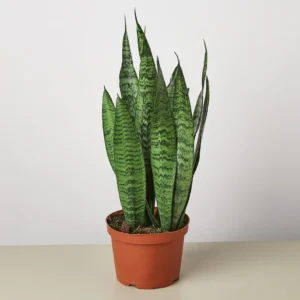
Origin: Africa
Common Name(s): Zeylanica Snake Plant, Sri Lanka Snake Plant
About the Snake Plant Zeylanica
The Zeylanica Snake Plant is a striking variety of Sansevieria, known for its tall, upright leaves that are a rich dark green with light, silvery-gray horizontal stripes. This plant’s bold, architectural appearance makes it a standout feature in any room, while its low-maintenance care requirements make it a favorite among both novice and experienced plant owners. It is very well known for its strong air purifying qualities such as producing oxygen, removing toxins from the air, and regulating indoor humidity levels.
Light
Bright, indirect light: Snake Plants prefers bright, indirect light and can tolerate some direct sun, especially in the morning or late afternoon. Place it near a sunny window for optimal growth. Low light conditions are tolerated, but yields slower growth.
Water
Water regularly: Snake plants are very drought-tolerant. Keep the soil evenly moist but not waterlogged. Water when the top 1-2 inches of soil feel dry, typically every 5-7 days in warmer months. In winter, allow the soil to dry out a bit more between waterings.
Temperature & Humidity
Warm temperatures: Snake plants prefer warm temperatures, ideally between 65-75°F (18-24°C) with low-to-moderate humidity.
How big will my plant grow?
It typically grows to a height of about 2 to 3 feet (60 to 90 cm), though in optimal conditions, it may reach up to 4 feet (1.2 meters).
Is this plant toxic for pets and kids?
Yes. This variety is mildly toxic to pets (cats and dogs) if ingested, causing symptoms such as mouth irritation, drooling, or vomiting. Keep it out of reach of curious pets to avoid any potential health issues.
🌿 Additional Care Tips:
- Fertilize sparingly: Feed your snake plant with a balanced liquid fertilizer diluted to half strength once or twice a year during the spring and or summer.
- Repot infrequently: Repot your snake plant only when it becomes root-bound. Use a well-draining cactus or succulent potting mix.
- Tolerant of neglect: Snake plants are very forgiving and can tolerate periods of neglect, but generally the more care - they look healthier and more beautiful.
- Propagation: Snake plants are easy to propagate through leaf cuttings or stem cuttings. Simply cut a healthy leaf or stem and place it in a pot with well-draining soil. Keep the soil slightly moist and in a warm, bright location.
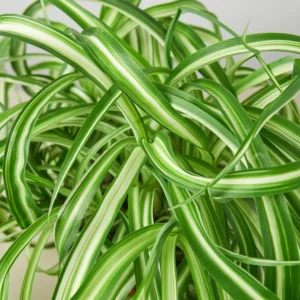
Origin: Southern Africa
Common Name(s): Bonnie Spider Plant, Curly Spider Plant
About the Spider Plant Bonnie
The Bonnie Spider Plant is a unique and attractive variety of the Spider Plant, known for its curly, arching leaves that give it a fuller, more compact appearance. Unlike the traditional straight-leafed Spider Plant, the Bonnie variety features tightly spiraled foliage, adding a playful and whimsical touch to any space. Its cascading "spiderettes" (baby plantlets) enhance its charm, making it a popular choice for hanging baskets or as a decorative plant for tabletops and shelves. It is unique in that it has strong air purifying qualities such as producing oxygen, removing toxins from the air, and regulating indoor humidity levels.
Light
Bright, indirect light: Spider Plant Bonnie thrives in bright, indirect light. While it can adapt to lower light conditions, its growth may slow down, and the leaves might lose some of their vibrant green color. Avoid direct sunlight, as it can scorch the delicate, curly leaves.
Water
Water regularly: Typically, this means watering every 7-10 days, but always check the soil moisture first. Allow the plant to drain well, as standing water can lead to root rot. In winter, reduce watering to allow the plant to rest.
Temperature & Humidity
Warm temperatures: The Spider Plant Bonnie prefers temperatures between 60-75°F (16-24°C). It does well in average indoor humidity but will appreciate higher humidity levels, especially during warmer months. Consider misting the plant occasionally or using a humidity tray in drier environments.
How big will my plant grow?
The plant itself typically grows to about 12 to 15 inches (30-38 cm) tall. However, it can spread much wider as the leaves arch outward, creating a bushy effect.
Is this plant toxic for pets and kids?
No. This Spider plant is non-toxic to pets (cats and dogs), making it a safe choice for households with curious animals.
🌿 Additional Care Tips:
- Fertilize regularly: Feed your plant with a balanced liquid fertilizer diluted to half strength every 4 weeks during spring and summer.
- Monitor for pests: Keep an eye out for common houseplant pests like mealybugs and spider mites. Treat infestations promptly with insecticidal soap or neem oil.
- Repot as needed: Repot Spider Plants every 1-2 years in a slightly larger pot with fresh, well-draining potting mix.
- Propagation: Spider Plants can be easily propagated through plantlets or division.
- Low-maintenance: Spider Plants are a low-maintenance and are perfect for beginners.

Origin: Brazil
Common Name(s): Tricolor, Bloodleaf, Stromanthe
About the Stromanthe Sanguinea
The Stromanthe Sanguinea, also known as Tricolor or Bloodleaf, is a stunning ornamental plant known for its striking foliage. It features vibrant green leaves with dramatic pink, white, and red variegation that gives it a colorful, tropical appearance. The undersides of the leaves are a deep red, adding an extra layer of beauty when the leaves curl or move. This plant is perfect for brightening up indoor spaces with its bold, exotic look. It has strong air purifying qualities such as producing oxygen, removing toxins from the air, and regulating indoor humidity levels.
Light
Bright, indirect light: Stromanthe thrives in bright, indirect light. It can tolerate lower light conditions, but the vivid coloration of its leaves will be more pronounced with more light. Avoid direct sunlight.
Water
Water regularly: Typically, this means watering every 7-10 days, but always check the soil moisture first. Allow the plant to drain well, as standing water can lead to root rot. In winter, reduce watering to allow the plant to rest.
Temperature & Humidity
Warm temperatures: Stromanthe prefers warm temperatures, ideally between 65-75°F (18-24°C) with humid conditions. Consider misting regularly or using a humidifier during the winter months.
How big will my plant grow?
This plant, typically a compact, bushy plant, grows to about 1 - 2 feet (30 - 60 cm) tall. Its spread can be similar, with the plant forming a dense clump of foliage.
Is this plant toxic for pets and kids?
No. This plant is non-toxic to pets (cats and dogs), making it a safe choice for households with curious animals.
🌿 Additional Care Tips:
- Fertilize regularly: Feed your Stromanthe with a balanced liquid fertilizer diluted to half strength every 4-6 weeks during spring and summer.
- Monitor for pests: Keep an eye out for common houseplant pests like mealybugs and spider mites. Treat infestations promptly with insecticidal soap or neem oil.
- Repot as needed: Repot your Stromanthe every 1-2 years in a slightly larger pot with fresh, well-draining potting mix.
- Prayer plant movement: Stromanthe is a prayer plant, meaning its leaves fold up at night and open in the morning.
- Provide adequate drainage: Ensure the pot has drainage holes to prevent waterlogging.
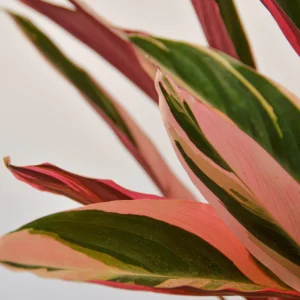
Origin: Brazil
Common Name(s): Magenta Triostar, Triostar Stromanthe
About the Stromanthe Magenta Triostar
The Stromanthe Magenta Triostar is a stunning and vibrant variety of the Stromanthe plant, known for its bold and beautiful foliage. It features striking leaves that are a mix of green, white, and magenta hues, creating a dramatic color contrast. The leaves have a glossy finish, and their vibrant pink and purple undersides become visible as they move or curl, adding to the plant's allure. This tropical plant is an excellent choice for bringing an exotic, colorful touch to any indoor space. It has strong air purifying qualities such as producing oxygen, removing toxins from the air, and regulating indoor humidity levels.
Light
Bright, indirect light: Stromanthe thrives in bright, indirect light. It can tolerate lower light conditions, but the vivid coloration of its leaves will be more pronounced with more light. Avoid direct sunlight.
Water
Water regularly: Typically, this means watering every 7-10 days, but always check the soil moisture first. Allow the plant to drain well, as standing water can lead to root rot. In winter, reduce watering to allow the plant to rest.
Temperature & Humidity
Warm temperatures: Stromanthe prefers warm temperatures, ideally between 65-75°F (18-24°C) with humid conditions. Consider misting regularly or using a humidifier during the winter months.
How big will my plant grow?
This plant, typically a compact, bushy plant, grows to about 1 - 2 feet (30 - 60 cm) tall. Its spread can be similar, with the plant forming a dense clump of foliage.
Is this plant toxic for pets and kids?
No. This plant is non-toxic to pets (cats and dogs), making it a safe choice for households with curious animals.
🌿 Additional Care Tips:
- Fertilize regularly: Feed your Stromanthe with a balanced liquid fertilizer diluted to half strength every 4-6 weeks during spring and summer.
- Monitor for pests: Keep an eye out for common houseplant pests like mealybugs and spider mites. Treat infestations promptly with insecticidal soap or neem oil.
- Repot as needed: Repot your Stromanthe every 1-2 years in a slightly larger pot with fresh, well-draining potting mix.
- Prayer plant movement: Stromanthe is a prayer plant, meaning its leaves fold up at night and open in the morning.
- Provide adequate drainage: Ensure the pot has drainage holes to prevent waterlogging.

Origin: South Africa & Mozambique
Common Name(s): Jade Plant, Money Tree, Friendship Tree, Lucky Plant
About the Succulent Crassula Jade
This hardy, evergreen succulent has become a beloved houseplant around the world, prized for its thick, fleshy, glossy green leaves and its ability to thrive in a variety of conditions with minimal care. It is often regarded as a symbol of good luck, prosperity, and friendship, which is why it’s commonly referred to as the "Money Tree" or "Lucky Plant." Its easy-care nature and attractive appearance make it a popular choice for indoor gardens, offices, or even as a decorative accent in outdoor spaces.
Light
Bright, indirect light: This plant prefers plenty of light to maintain its fresh vegetation. It can tolerate direct sunlight but do avoid prolonged exposure. Benefit from a few hours of morning sunlight.
Water
Water once every 2-3 weeks: Water every 2-3 weeks or when the soil feels dry to the touch (about 1-2 inches deep). Allow soil to dry out between waterings. This plant is a drought-tolerant succulent, so it’s better to underwater than overwater.
Temperature & Humidity
Warm temperatures: This plant prefer temperatures between 60-80°F (16-27°C) with low to moderate humidity. It can tolerate small periods of higher temperature. Avoid frost.
How big will my plant grow?
This plant grows slowly, reaching heights of up to 3 feet (90 cm) indoors, though its growth can be controlled with occasional pruning. It has small, star-shaped white or pinkish flowers that typically appear in winter or early spring.
Is this plant toxic for pets and kids?
No. This plant is non-toxic to pets (cats and dogs), making it a safe choice for households with curious animals.
🌿 Additional Care Tips:
- Watch for pests: Watch out for mealybugs and scale insects, which can infest Crassula Jade plants.
- Repot every 1-2 years: Repot this plant every 1-2 years or when the plant becomes root-bound. Use a well-draining cactus or succulent mix.
- Fertilize sparingly: Feed your plant with a balanced liquid fertilizer diluted to half strength once or twice a year during the growing season.
- Propagates easily: This plant can be easily propagated through leaf cuttings or stem cuttings.
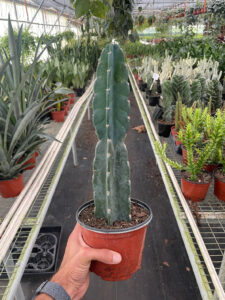
Origin: North, Central & South America
Common Name(s): Cuddly Cactus, Peruvian Cactus, Queen of the Night Cactus
About the Succulent Cereus Cuddly Cactus
Often referred to as the “Cuddly Cactus” due to its relatively soft spines compared to other cacti, it is a popular choice for both indoor and outdoor plants. his cactus is well-adapted to arid environments and is commonly grown for its architectural form and ability to thrive in dry conditions. This cactus is an excellent choice for beginner gardeners or anyone looking for a low-maintenance plant.
Light
Bright, direct light: This plant prefers a lot of direct light, and in most cases the full direct sun to grow and maintain its vegetation. They need as much sunlight as possible to grow and thrive.
Water
Water once every 2-3 weeks: Water every 2-3 weeks during the growing season or when the soil feels dry to the touch. The Cuddly Cactus can store water in its leaves for extended periods of time. Water every 4-6 weeks in the fall and winter months.
Temperature & Humidity
Warm temperatures: This plant prefer temperatures between 65-75°F (16-24°C) in the growing months with low to moderate humidity. Can tolerate temperates up to 100°F but any condition less than 50°F.
How big will my plant grow?
Indoors, the Cuddly Cactus typically grows to about 6 to 12 inches (15 to 30 cm) tall. With adequate pruning, tends to remain compact, which makes it well-suited for small spaces or containers. Outdoors, it can reach impressive heights of 10–20 feet (3–6 meters).
Is this plant toxic for pets and kids?
No. While the Cereus Cuddly Cactus is non-toxic to pets, its spines can still cause irritation if touched. Always keep the cactus out of reach of children or pets.
🌿 Additional Care Tips:
- Watch for pests: Watch out for mealybugs and scale insects, which can infest Cuddly Cactus plants.
- Flower occasionally: The Cereus Cuddly Cactus produces large, white or pinkish flowers that bloom at night, typically in late spring to early summer.
- Handle with Care: Cuddly Cacti are covered in spines that can cause painful injuries. Use thick gloves when handling them.
- Prune as needed: Pruning is generally not necessary unless you need to remove damaged or dead stems. If the cactus becomes too large, you can trim back the stems carefully.
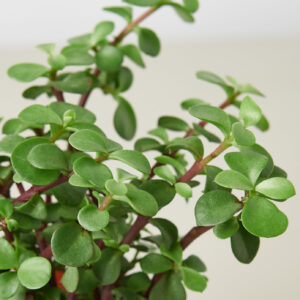
Origin: South Africa
Common Name(s): Elephant Bush, Dwarf Jade Plant
About the Succulent Elephant Bush
This plant is often referred to as the "Elephant Bush" because of its thick, fleshy stems, which resemble the trunk of an elephant, especially as it grows larger. It's a popular plant for both beginners and experienced gardeners due to its easy-care nature, attractive appearance, and versatile growth habit. It can also produce small, star-shaped pink or white flowers in the late spring or early summer, though it is more commonly grown for its attractive foliage.
Light
Bright, indirect light: This plant prefers plenty of light to maintain its fresh vegetation. It can tolerate direct sunlight in the mornings and afternoon. Avoid midday sun.
Water
Water once every 2-3 weeks: This plant stores water in the leaves and stem so it does not require frequent watering. Allow soil to dry out between waterings.
Temperature & Humidity
Warm temperatures: This plant prefer temperatures between 60-85°F (16-29°C) with low to moderate humidity. It can tolerate slightly cooler temperature but avoid freezing conditions.
How big will my plant grow?
This plant can grow into a small shrub or even a small tree, reaching heights of 3–6 feet (1–2 meters). When grown indoors or in smaller containers, it remains more compact, making it ideal for windowsills, desks, or other small spaces.
Is this plant toxic for pets and kids?
No. This plant is non-toxic to pets (cats and dogs), making it a safe choice for households with curious animals.
🌿 Additional Care Tips:
- Propagate as needed: It can be propagated by stem cuttings or leaf cuttings only when necessary. Allow the cut end to callus for 1-2 days before planting it in well-draining soil.
- Watch for Pests: Watch out for mealybugs and scale insects, which can infest Elephant Bush plants.
- Fertilize sparingly: Feed your plant with a balanced liquid fertilizer diluted to half strength once or twice a year during the growing season.
- Care for winter: During winter, reduce watering and move the plant to a cooler, brighter location.
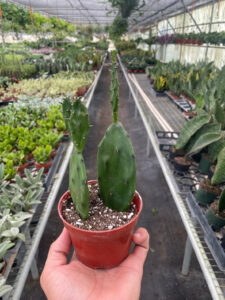
Origin: North, Central & South America
Common Name(s): Prickly Pear Cactus, Nopal Cactus, Indian Fig Cactus
About the Succulent Prickly Pear Cactus
Known for its broad, flattened pads and its ability to thrive in arid, desert-like conditions, this succulent has become an iconic symbol of desert landscapes. Its distinctive pads are often covered in spines or glochids (small, fine spines) that can be prickly to the touch, but the plant also produces colorful, edible fruits called "tunas" (or "prickly pears") that are popular in various culinary dishes, especially in Mexican and Southwestern cuisines. In the summer, the plant produces beautiful, trumpet-shaped flowers, followed by the development of the distinctive fruits, which are often bright red, pink, or yellow, and covered with small spines.
Light
Bright, indirect light: This plant prefers plenty of light, and in most cases the full direct sun to grow and maintain its fresh vegetation.
Water
Water once every 2-3 weeks: Water every 2-3 weeks or when the soil feels dry to the touch. The Prickly Pear can store water in its leaves for extended periods of time. Water every 4-6 weeks in the fall and winter months.
Temperature & Humidity
Warm temperatures: This plant prefer temperatures between 65-80°F (18-27°C) in the growing months with low to moderate humidity. Avoid sudden fluctuations in temperature or any condition less than 50°F.
How big will my plant grow?
This plant typically grow to about 1 to 3 feet (30 to 90 cm) tall.
Is this plant toxic for pets and kids?
No. This plant is non-toxic to pets (cats and dogs), making it a safe choice for households with curious animals.
🌿 Additional Care Tips:
- Pruning when need: Pruning is generally not necessary unless you need to remove dead pads or control the size of the plant
- Repot every 2-3 years: Repot every 2-3 years or when the plant becomes too large for its container.
- Handle with Care: Prickly Pear cacti are covered in spines that can cause painful injuries. Use thick gloves when handling them.
- Propagates easily: This plant can be easily propagated by cutting off stem pads (cladodes) and allowing it to dry and callus for a few days before planting it in well-draining soil.
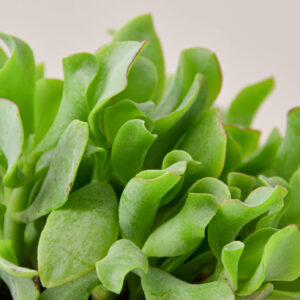
Origin: South Africa
Common Name(s): Ripple Jade, Propeller Plant, Jade Ripple
About the Succulent Ripple Jade
Known for its distinctive, wing-like, rippled foliage that resembles a jade-colored propeller or butterfly wing, this plant stands out due to its unique, fan-shaped leaves. They are arranged in opposing pairs, giving it a visually dynamic and sculptural appearance. It may produce small, star-shaped, white or pale pink flowers that appear in dense clusters at the tips of the stems.
Light
Bright, indirect light: This plant prefers plenty of light to maintain its fresh vegetation. It can tolerate few hours of sunlight in the morning but avoid direct sunlight.
Water
Water once every 2-3 weeks: Water every 2-3 weeks or when the soil feels dry to the touch (about 1-2 inches deep). Allow soil to dry out between waterings. This plant is a drought-tolerant succulent, so it’s better to underwater than overwater.
Temperature & Humidity
Warm temperatures: This plant prefer temperatures between 60-80°F (16-27°C) with low to moderate humidity. It can tolerate small periods of higher temperature. Avoid frost.
How big will my plant grow?
This plant can grow up to 12–18 inches (30–45 cm) in height and about 12 inches (30 cm) in width, making it suitable for small to medium-sized containers, spaces, tabletops, and counters.
Is this plant toxic for pets and kids?
No. This plant is non-toxic to pets (cats and dogs), making it a safe choice for households with curious animals.
🌿 Additional Care Tips:
- Watch for pests: Watch out for mealybugs and scale insects, which can infest Ripple Jade plants.
- Repot every 1-2 years: Repot this plant every 1-2 years or when the plant becomes root-bound. Use a well-draining cactus or succulent mix.
- Fertilize sparingly: Feed your plant with a balanced liquid fertilizer diluted to half strength once or twice a year during the growing season.
- Propagates easily: This plant can be easily propagated through leaf cuttings or stem cuttings.
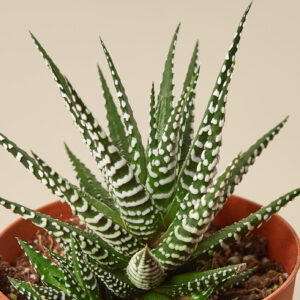
Origin: South Africa
Common Name(s): Zebra Plant, Zebra Haworthia
About the Succulent Zebra Plant
Known for its striking appearance, it features thick, fleshy, dark green leaves with prominent white horizontal stripes that resemble the pattern of a zebra's skin, hence the name "Zebra Plant." The leaves are arranged in rosettes and have a slightly translucent, banded appearance, which gives the plant a unique and eye-catching texture. Additionally, it can produce small, tubular white or pale pink flowers in the summer.
Light
Bright, indirect light: This plant prefers plenty of light to maintain its fresh vegetation. It can tolerate direct sunlight and full sun in hot climates with shade in the afternoon.
Water
Water once every 2-3 weeks: Water every 2-3 weeks or when the soil feels dry to the touch (about 1-2 inches deep). Allow soil to dry out between waterings. This plant is a drought-tolerant succulent, so it’s better to underwater than overwater.
Temperature & Humidity
Warm temperatures: This plant prefer temperatures between 60-80°F (16-27°C) with low to moderate humidity. It can tolerate slightly cooler temperature, but avoid exposure to sudden temperature change.
How big will my plant grow?
This plant typically grows up to 6–8 inches (15–20 cm) in height and spreading up to 12 inches (30 cm) in diameter.
Is this plant toxic for pets and kids?
No. This plant is non-toxic to pets (cats and dogs), making it a safe choice for households with curious animals.
🌿 Additional Care Tips:
- Prune as needed: Prune to remove dead or damaged leaves and to shape the plant if it becomes too leggy.
- Repot every 1-2 years: Repot this plant every 1-2 years or when the plant becomes root-bound. Use a well-draining cactus or succulent mix.
- Fertilize sparingly: Feed your plant with a balanced liquid fertilizer diluted to half strength once or twice a year during the growing season.
- Propogates easily: The Zebra Plant can be easily propagated by offsets (pups). Simply remove the small baby plants that grow around the base of the mother plant, allow them to callus over for a day or two, and then plant them in their own pot with well-draining soil.
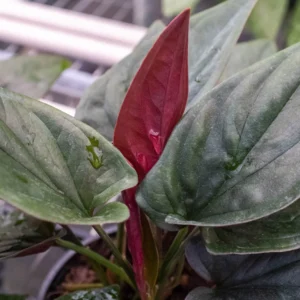
Origin: Central & South America
Common Name(s): Red Arrowhead Plant, Red Syngonium
About the Syngonium Red Arrowhead
The Red Arrowhead, a striking variety of Syngonium podophyllum, is known for its vibrant red and burgundy-colored leaves that gradually transform into green as the plant matures. The arrow-shaped leaves give this plant its distinctive look, and the red hues add a touch of bold color to any indoor space. This fast-growing and low-maintenance plant is a great choice for those looking to add a pop of color and tropical flair to their home or office. It is very well known for its strong air purifying qualities such as producing oxygen, removing toxins from the air, and regulating indoor humidity levels.
Light
Bright, indirect light: Syngonium plants prefer bright, indirect light but can tolerate lower light levels. However, in low light, their growth may slow, and their vibrant foliage may lose some of its color. Direct sunlight should be avoided, as it can scorch the leaves.
Water
Water regularly: Every 5-7 days, while in cooler months, reduce watering frequency. Ensure the pot has good drainage.
Temperature & Humidity
Warm temperatures: Syngonium plants prefer temperatures between 60-80°F (16-27°C) and high humidity (60% or higher). They can adapt to average indoor humidity but will thrive in a humid environment.
How big will my plant grow?
Indoors, the Syngonium Red Arrowhead typically grows to about 3 to 6 feet (90 to 180 cm) in height, though it can grow taller if given ample space and support (trail or climb if provided with a trellis or structure).
Is this plant toxic for pets and kids?
Yes. This Syngonium variety is toxic to pets (cats and dogs). Please prevent them from chewing on the leaves as it can cause stomach upset, difficulty swallowing and vomitng.
🌿 Additional Care Tips:
- Fertilize regularly: Feed your Syngonium with a balanced liquid fertilizer diluted to half strength every 2-4 weeks during the growing season.
- Monitor for pests: Keep an eye out for common houseplant pests like mealybugs and spider mites. Treat infestations promptly with insecticidal soap or neem oil.
- Pruning: Prune your Syngonium regularly to encourage healthy growth.
- Propagation: Syngoniums can be easily propagated through stem cuttings.
- Unique leaf shape: Syngoniums are known for their distinctive, arrowhead-shaped leaves, which can vary in color and shape depending on the variety.
- Climbing or trailing: Syngoniums can be trained to climb a moss pole or allowed to trail.
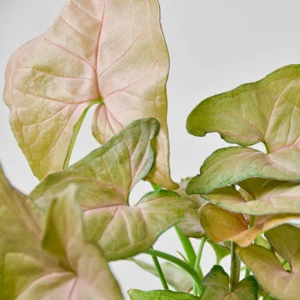
Origin: Central & South America
Common Name(s): Strawberry Arrowhead Plant
About the Syngonium Strawberry
The Syngonium Strawberry, also known as the Strawberry Arrowhead, is a striking cultivar of the popular Syngonium podophyllum. This variety is admired for its unique, heart-shaped leaves that start as a soft pink or red and gradually transition into a light green as they mature. The vibrant color contrast between the new pink/red growth and the mature green foliage makes this plant a visually captivating addition to any indoor garden. It is known for its strong air purifying qualities such as producing oxygen, removing toxins from the air, and regulating indoor humidity levels.
Light
Bright, indirect light: Syngonium plants prefer bright, indirect light but can tolerate lower light levels. However, in low light, their growth may slow, and their vibrant foliage may lose some of its color. Direct sunlight should be avoided, as it can scorch the leaves.
Water
Water regularly: Every 5-7 days, while in cooler months, reduce watering frequency. Ensure the pot has good drainage.
Temperature & Humidity
Warm temperatures: Syngonium plants prefer temperatures between 60-80°F (16-27°C) and high humidity (60% or higher). They can adapt to average indoor humidity but will thrive in a humid environment.
How big will my plant grow?
Indoors, this Syngonium typically grows to about 3 to 6 feet (90 to 180 cm) in height. It benefits from structural support eg. trellis to trail or climb
Is this plant toxic for pets and kids?
Yes. This Syngonium variety is toxic to pets (cats and dogs). Please prevent them from chewing on the leaves as it can cause stomach upset, difficulty swallowing and vomitng.
🌿 Additional Care Tips:
- Fertilize regularly: Feed your Syngonium with a balanced liquid fertilizer diluted to half strength every 2-4 weeks during the growing season.
- Monitor for pests: Keep an eye out for common houseplant pests like mealybugs and spider mites. Treat infestations promptly with insecticidal soap or neem oil.
- Pruning: Prune your Syngonium regularly to encourage healthy growth.
- Propagation: Syngoniums can be easily propagated through stem cuttings.
- Unique leaf shape: Syngoniums are known for their distinctive, arrowhead-shaped leaves, which can vary in color and shape depending on the variety.
- Climbing or trailing: Syngoniums can be trained to climb a moss pole or allowed to trail.
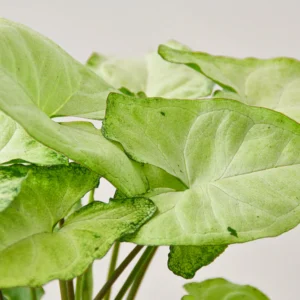
Origin: Central & South America
Common Name(s): White Butterfly Syngonium
About the Syngonium White Butterfly
The Syngonium White Butterfly is known for its beautiful variegated leaves. The arrowhead-shaped foliage creates a lush, elegant appearance, making this plant an eye-catching addition to any indoor space. The graceful, trailing vines of the White Butterfly Syngonium also make it a perfect plant for hanging baskets or cascading from shelves. It is known for its strong air purifying qualities such as producing oxygen, removing toxins from the air, and regulating indoor humidity levels.
Light
Bright, indirect light: Syngonium plants prefer bright, indirect light but can tolerate lower light levels. However, in low light, their growth may slow, and their vibrant foliage may lose some of its color. Direct sunlight should be avoided, as it can scorch the leaves.
Water
Water regularly: Every 5-7 days, while in cooler months, reduce watering frequency. Ensure the pot has good drainage.
Temperature & Humidity
Warm temperatures: Syngonium plants prefer temperatures between 60-80°F (16-27°C) and high humidity (60% or higher). They can adapt to average indoor humidity but will thrive in a humid environment.
How big will my plant grow?
Indoors, this Syngonium typically grows to about 3 to 6 feet (90 to 180 cm) in height. It benefits from structural support eg. trellis to trail or climb
Is this plant toxic for pets and kids?
Yes. This Syngonium variety is toxic to pets (cats and dogs). Please prevent them from chewing on the leaves as it can cause stomach upset, difficulty swallowing and vomitng.
🌿 Additional Care Tips:
- Fertilize regularly: Feed your Syngonium with a balanced liquid fertilizer diluted to half strength every 2-4 weeks during the growing season.
- Monitor for pests: Keep an eye out for common houseplant pests like mealybugs and spider mites. Treat infestations promptly with insecticidal soap or neem oil.
- Pruning: Prune your Syngonium regularly to encourage healthy growth.
- Propagation: Syngoniums can be easily propagated through stem cuttings.
- Unique leaf shape: Syngoniums are known for their distinctive, arrowhead-shaped leaves, which can vary in color and shape depending on the variety.
- Climbing or trailing: Syngoniums can be trained to climb a moss pole or allowed to trail.
Z
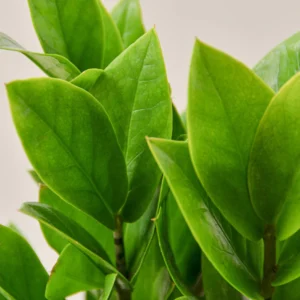
Origin: Eastern Africa
Common Name(s): ZZ Plant
About the ZZ Plant
The ZZ Plant is a popular and highly durable variety of the classic ZZ plant, known for its glossy, dark green, feather-like leaves that add a touch of elegance to any space. This plant is well-known for its resilience, making it a great option for low-light spaces or those with less-than-perfect plant care routines. Its ability to tolerate neglect, drought, and low light makes it an excellent choice for busy homeowners or office spaces. It is very well known for its strong air purifying qualities such as producing oxygen, removing toxins from the air, and regulating indoor humidity levels.
Light
Bright, indirect light: ZZ Plants thrive in bright, indirect light. Avoid direct sunlight, as it can scorch the leaves.
Water
Water occasionally: Every 1-2 weeks. ZZ Plants are drought-tolerant. Allow the soil to dry out completely before watering. Ensure the pot has good drainage.
Temperature & Humidity
Warm temperatures: ZZ Plants prefer warm temperatures, ideally between 65-75°F (18-24°C) with low-to-moderate humidity.
How big will my plant grow?
Indoors,it typically grows to about 2 to 3 feet (60 to 90 cm) in height. In ideal conditions, it can reach up to 4 feet (1.2 meters) tall with very sturdy stems.
Is this plant toxic for pets and kids?
Yes. The ZZ Plant is toxic to pets (cats and dogs) if ingested, so it's important to place it out of reach of curious animals. Ingesting parts of the plant can cause symptoms like vomiting, drooling, and digestive discomfort.
🌿 Additional Care Tips:
- Fertilizing: ZZ plants don't need frequent feeding, but you can apply a diluted, balanced liquid fertilizer once a month during the growing season (spring and summer). Avoid fertilizing in the fall and winter when the plant is dormant.
- Cleaning: Wipe the glossy leaves with a damp cloth to remove dust and keep the plant looking fresh. This also helps the plant absorb light more efficiently.
- Resilient to Pests: ZZ plants are generally resistant to pests like spider mites, aphids, and mealybugs. However, it's still a good idea to periodically check for signs of infestation, especially if the plant is stressed or weakened.
- Slow Growth: ZZ plants are slow growers, which means they don't require frequent pruning. However, you can trim any yellowing or damaged leaves to maintain a tidy appearance.